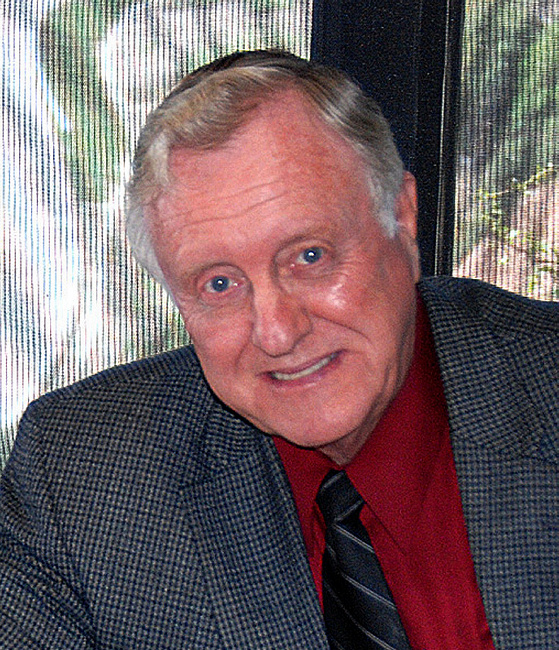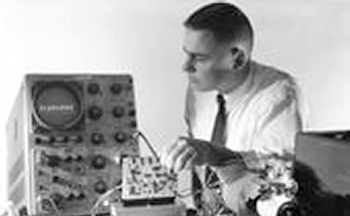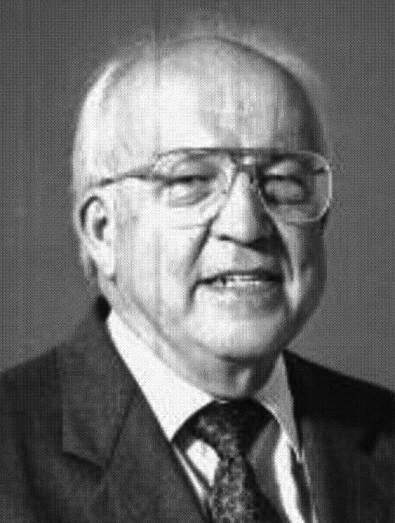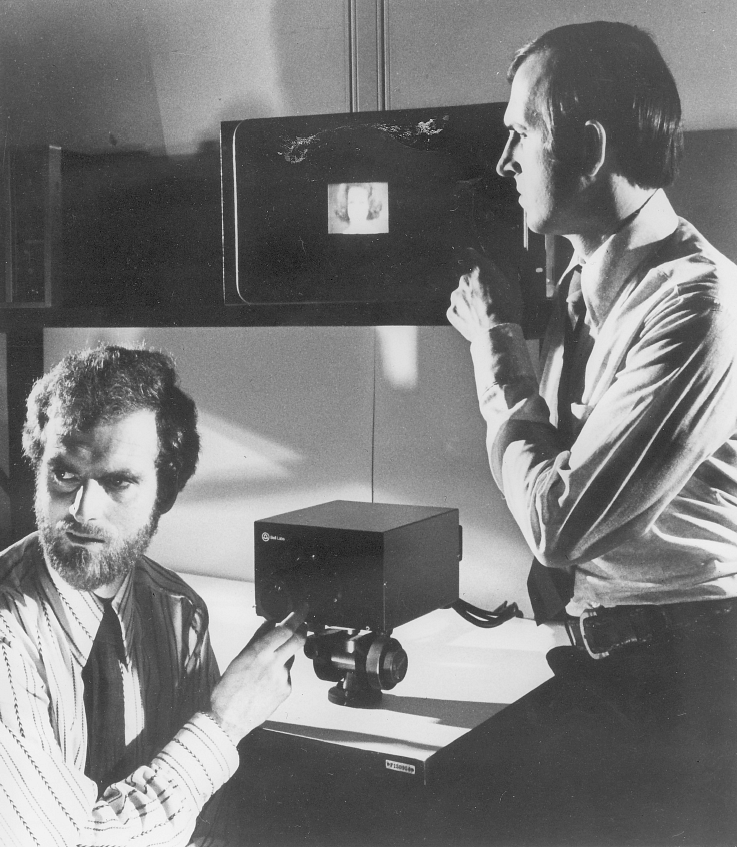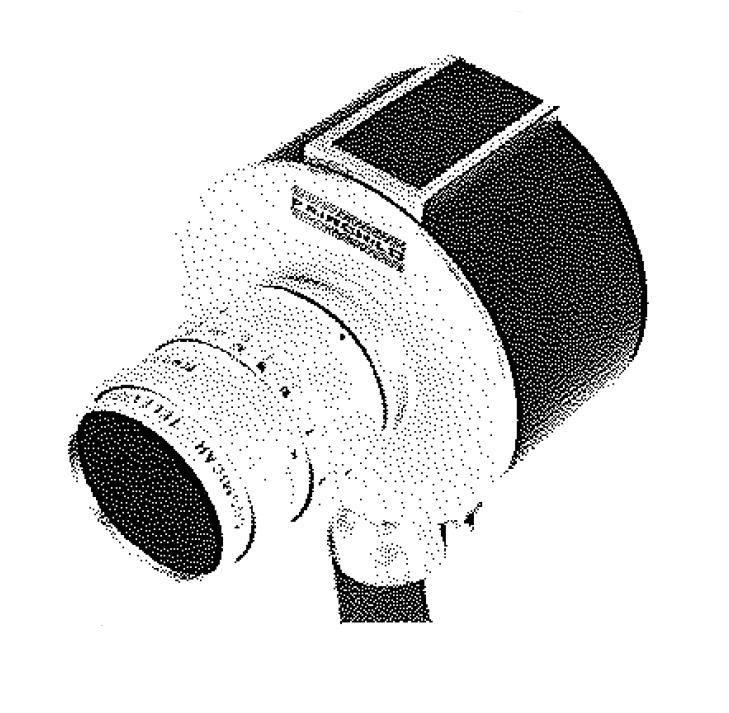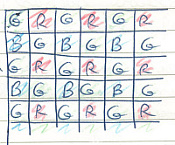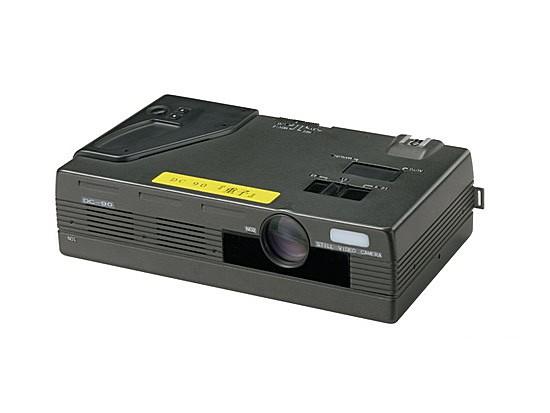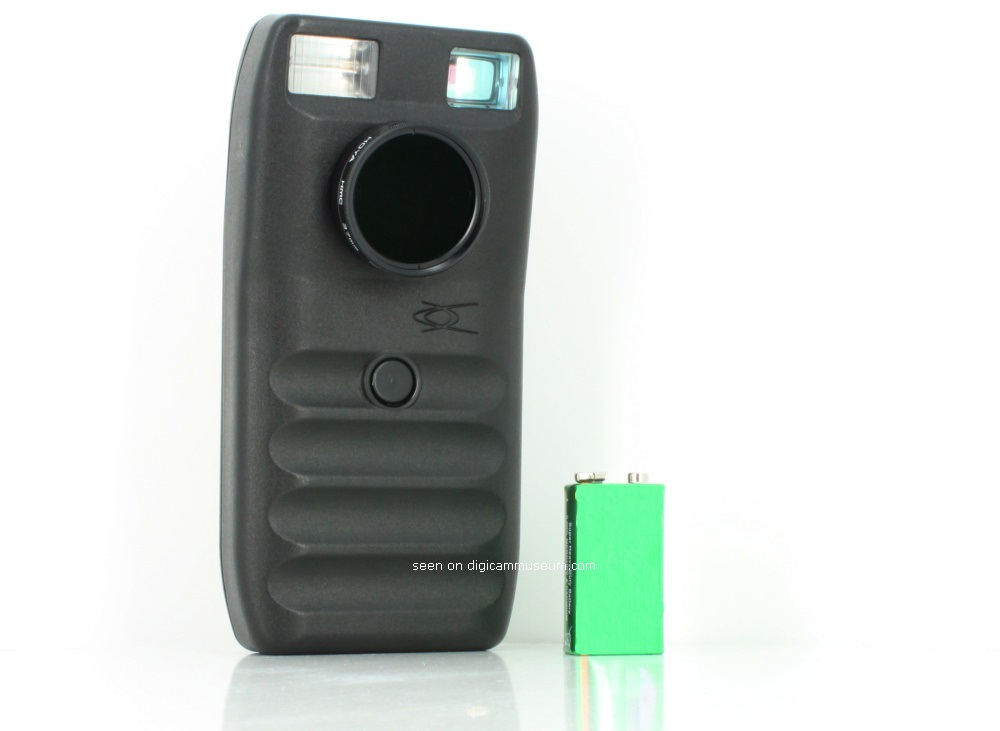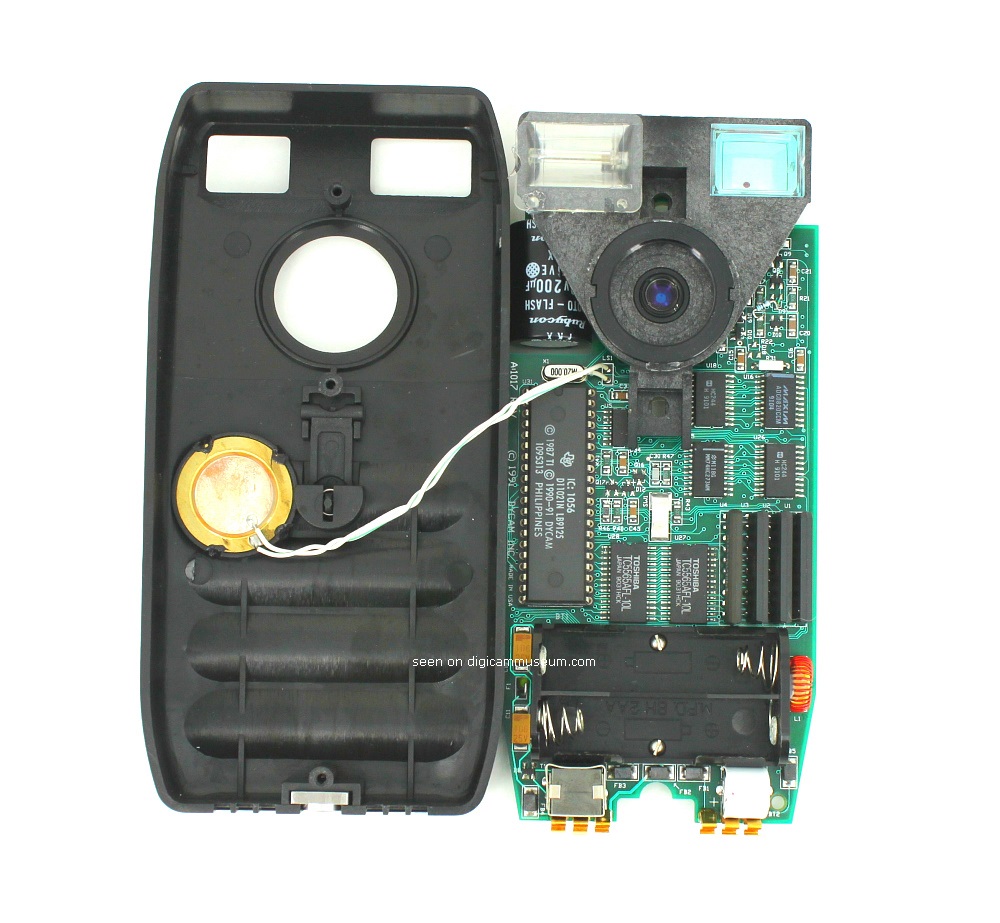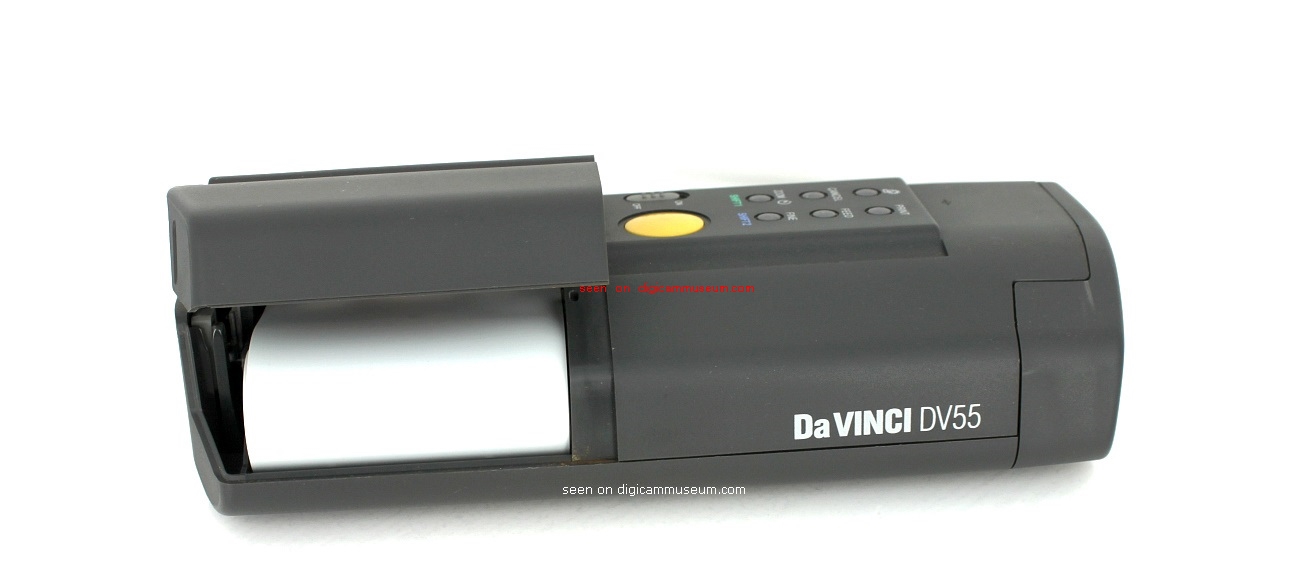History of the digital camera and digital imaging
The history of digital imaging as well as the invention and introduction of the first digital cameras is a bit blurry and often poorly covered in books and on websites. This has always bothered me, so I did some research of my own and I want to provide you with a more accurate history lesson. I've drooled over tons of websites, magazines, newspapers and books and have also spoken to a few engineers who were actually involved in the development of early digicams and digital imaging. Without their help this website would not have been possible. This history lesson is as accurate as can be so if you think I am mistaken I am truly looking forward to discuss this with you. Also, if anyone feels I am missing something or has valuable information that needs to be added I would be very grateful for that. I am convinced that sometime in the near future we can make this place the #1 Digital Imaging History website on the net!
I personally want to thank the following people for their time, knowledge and patience even when my questions became so plentiful to the point of becoming almost annoying. I am also grateful that these fine individuals took some time to review and approve parts of my material:
- Eugene F. Lally (Space Age pioneer, scientist, spacecraft mission designer, photographer and inventor. Without his encouragement I'd given up!)
- Steven J. Sasson (Engineer, inventor of the world's first hand-held CCD digital camera)
- James McGarvey (Product architect, lead engineer of the Kodak DCS series, designer of the world's first DSLR camera)
- Kenneth Parulski (engineer, lead researcher of the world's first color megapixel prototype digital camera and inventor)
- James R. Janesick (scientist, engineer, researcher and probably the world's leading expert on CCD/CMOS technology)
- Stephen K. Babey (scientist, inventor, expert on advanced imaging instrumentation, particularly hyperspectral instruments)
- Motokazu Ohkawa (Chairperson of the DSC Committee in JEIDA, expert in ISO TC42, co-inventor of the Fujix DS-1P)
- Dr. Roger N. Clark (Scientist, expert on imaging spectrometers, co-investigator on the Mars Reconnaissance Orbiter, science team member on the Cassini mission to Saturn)
- Ken Boydston (CEO and founder of MegaVision, digital imaging pioneer)
- Paul Laughton (ex-Logitech project manager for Logitech Fotoman, Fotoman Pixtura and Kodak DC40, programmer of the original Apple DOS)
- Eric Anderson (Engineer, M.S. and E.E. from MIT, Chief Architect and Camera Software Manager at Apple, Chief Technology Officer at FlashPoint, owner of 140+ patents)
- Dr. K. Bradley Paxton (former VP and General Manager of Kodak's Electronic Photography Division)
- Todd Gustavson (Author and technology curator of the George Eastman Museum)
The following history is not meant to be definitive in any way since single steps and inventions in the development of digital cameras and solid-state imagers are sometimes poorly documented or not disclosed to the public. For example, if I would have unrestricted access to all IEEE and SPIE documents, this history section would have been much bigger (and more scientific). Also the concept of digital imaging and the role of imaging sensors in applications is so versified that it would take dozens of books to cover it all. Especially imaging concepts like scanner cameras and the scientific use of CCD's would blow this site out of proportions. All information and pictures displayed here are for informational purposes only. Photos, pictures and images are property of their respective owners. If anyone or any company feels his/her or it's rights violated please inform me and I'll remove the requested content. IF you want to use this information in part or whole, please ask for permission first. In any case you must refer to this website.
1760 - transmission phantasies
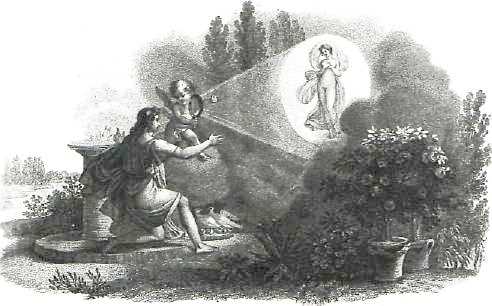
Miraculous Mirror (© Public Domain) Huh? Why 1760? There wasn't even electricity back then. (okay, there were frictional electric machines and Leyden jars but no devices of any kind). Long before the discovery of photography there was a french man by the name of Charles-Francois Tiphaigne de la Roche who wrote a novel. It was called Giphantie (an anagram of the author's middle name). The book is believed to be the only work prior to 1800 that describes an example of an imaginative anticipation of photography, television and even webcams. The protagonist is being taken in a typhoon and arrives in the land of Giphantie, deep in africa, were a breed of supermen living in secrecy show him wondrous things, for example how pictures are made. The process is described as follows:
"You know, that rays of light reflected from different bodies form pictures, paint the image reflected on all polished surfaces, for example, on the retina of the eye, on water, and on glass. The spirits have sought to fix these fleeting images; they have made a subtle matter by means of which a picture is formed in the twinkling of an eye. They coat a piece of canvas with this matter, and place it in front of the object to be taken. The first effect of this cloth is similar to that of a mirror, but by means of it's viscous nature the prepared canvas, as is not the case with the mirror, retains a facsimile of the image. The mirror represents images faithfully, but retains none; our canvas reflects them no less faithfully, but retains them all. This impression of the image is instantaneous. The canvas is then removed and deposited in a dark place. An hour later the impression is dry, and you have a picture the more precious in that no art can imitate its truthfulness."[0]
It basically describes the imprinting of an image on a special coated canvas (negative film) that is then put in a dark place (darkroom) to be developed. The result is a facsimile of the image (photograph). One can only speculate what the author meant with "matter". Since he was a doctor and protoscientist and wrote several books about alchemy and science one may think that he was envisioning photography and thus ahead of his time. On another page the author talks about the transmission of images from different points of the earth to a mirror by means of "portions of air in the atmosphere reserved by the spirits for this task". This could be an anticipation of television broadcasts and web cams. Okay, still far from digital photography but I found it quite amusing so I mentioned it here as a prelude for things to come.
1839 - invention of photography
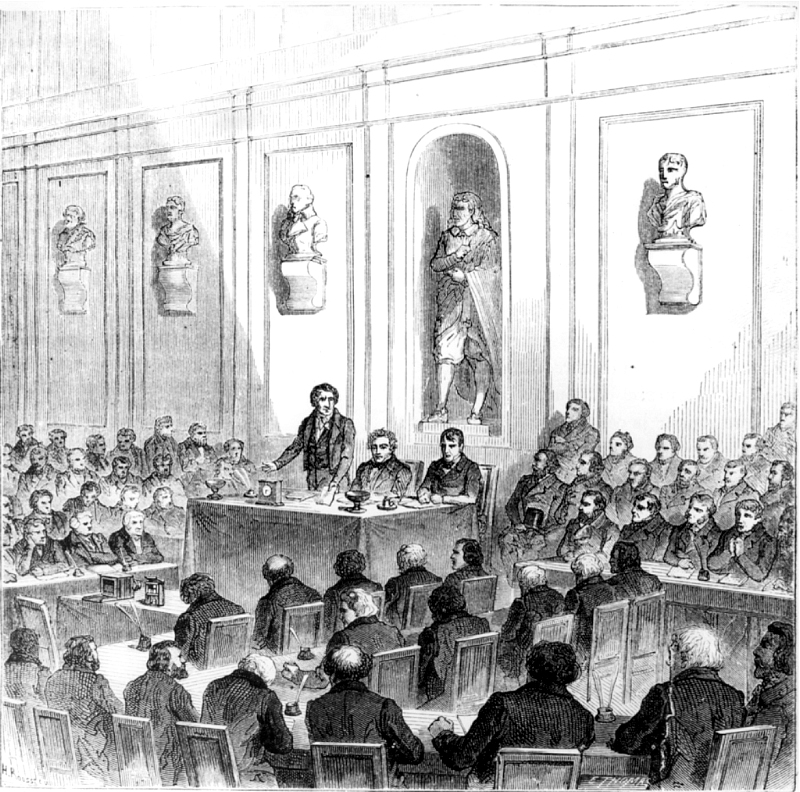
Announcement of the Daguerréotype
(© unknown artist) 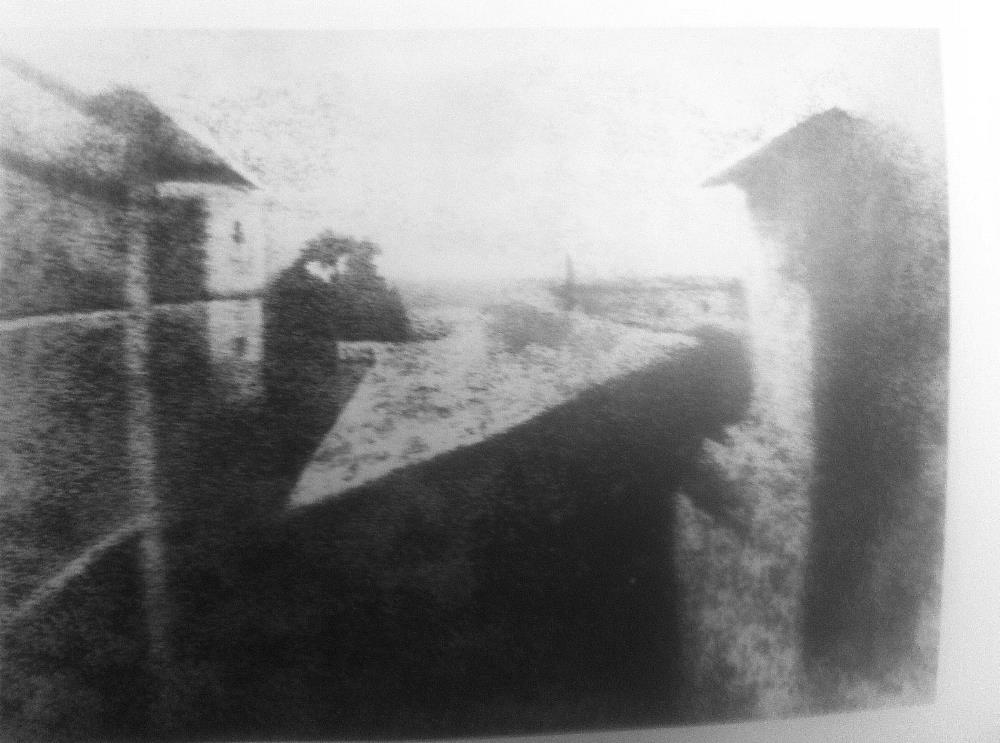
View from the windows at Le Gras (© Joseph Niépce) 1839 is a historic date because it is the official birth year of photography. So, in 2014, photography was 175 years old. The experiments that lead to this date are those made by Joseph Nicéphore Niépce and Louis Jacques Mandé Daguerre. Niépce was the first person who succeeded in permanently capturing an image on a sheet of bitumen-coated pewter. His goal was to permanently capture the fleeting images of the then popular camera obscura. It showed parts of his backyard from a view through his own window. It is now the oldest known camera photograph still in existence and taken with said camera obscura. The exposure time, contrary to popular belief, took several days. Needless to say that today, the image on the original plate is hardly recognizable anymore and all the images one can see on the internet are manually enhanced versions of the original plate.
Louis Daguerre, who also tried to permanently capture images, bought his cameras and lenses from a parisian optician called Charles Chevalier. Chevalier told Daguerre about Niépce's experiments and so Daguerre and Niépce entered a partnership which resulted in the world's first photographic society. After Niépce's death in 1833, Daguerre continued experimenting on his own with photosensitive substances and eventually invented a new process of permanently capturing photographic images which he called daguerréotype. In 1835, Daguerre demonstrated this in his own theater, the Diorama, and a review of that evening stated that Daguerre has found the means to collect, on a plate prepared by him, the image produced by the camera obscura, in such a way that a portrait, a landscape, or any view, projected upon this plate by the ordinary camera obscura, leaves an imprint in light and shade there, and thus presents the most perfect of all drawings.
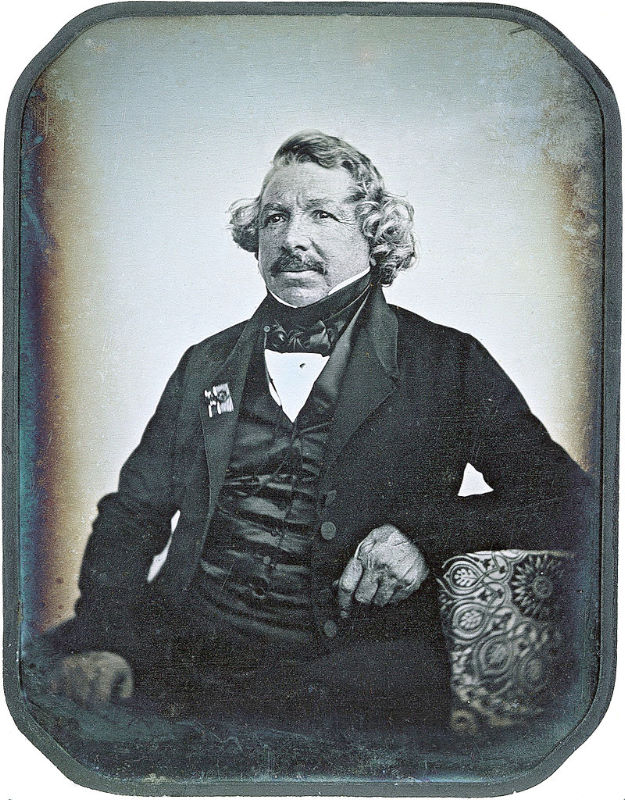
Daguerréotype of L. Daguerre (© J.B. Sabatier-Blot) 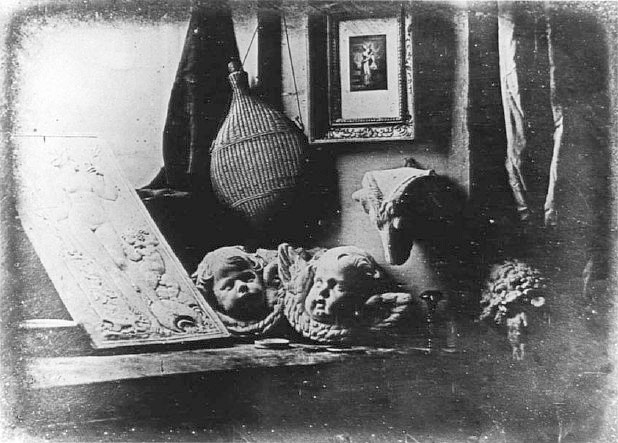
Oldest Daguerréotype from 1837 (© L. Daguerre) On August 19th, 1839, François Arago announced the daguerreotype process at a joint meeting of the French Academy of Sciences and the Académie des Beaux-Arts at the Institute of France. Daguerre was also present but refused to talk due to his sore throat. Isodore Niépce, son of Joseph Niépce, was also present to represent the work of his father. He too sat in silence as Arago explained the process to fully packed house. The room was completely quiet because no one wanted to miss a single detail of this new marvel. At the end of the demonstration Arago made a spectacular statement. He announced that the french government had passed a bill on July 30th, 1839, that the daguerréotype process had been bought by the french government and was given to the world as a free gift. This meant that everyone could become a photographer without paying royalties to a third party. Shortly after, people made a run for chemical stores and opticians to acquire material for taking photographs. Daguerre received a life long yearly stipend of 6,000 Francs from the french government and the estate of Niépce received 4,000 Francs yearly. Later that year William Fox Talbot announced his silver chloride "sensitive paper" process. Together with the daguerréotype these announcements mark 1839 as the year photography was born.
1880 - selenium photocells
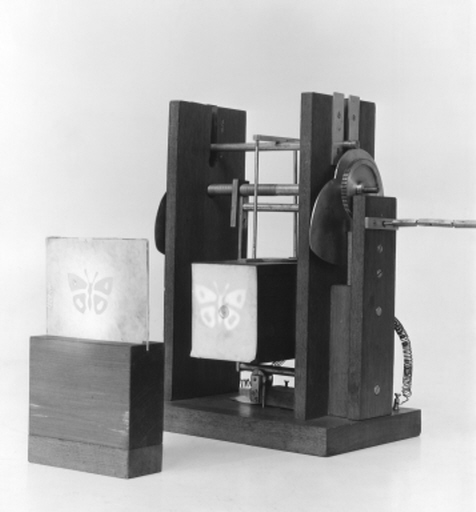
Bidwell's picture transmitter and receiver
(© National Museum of Science and Industry) 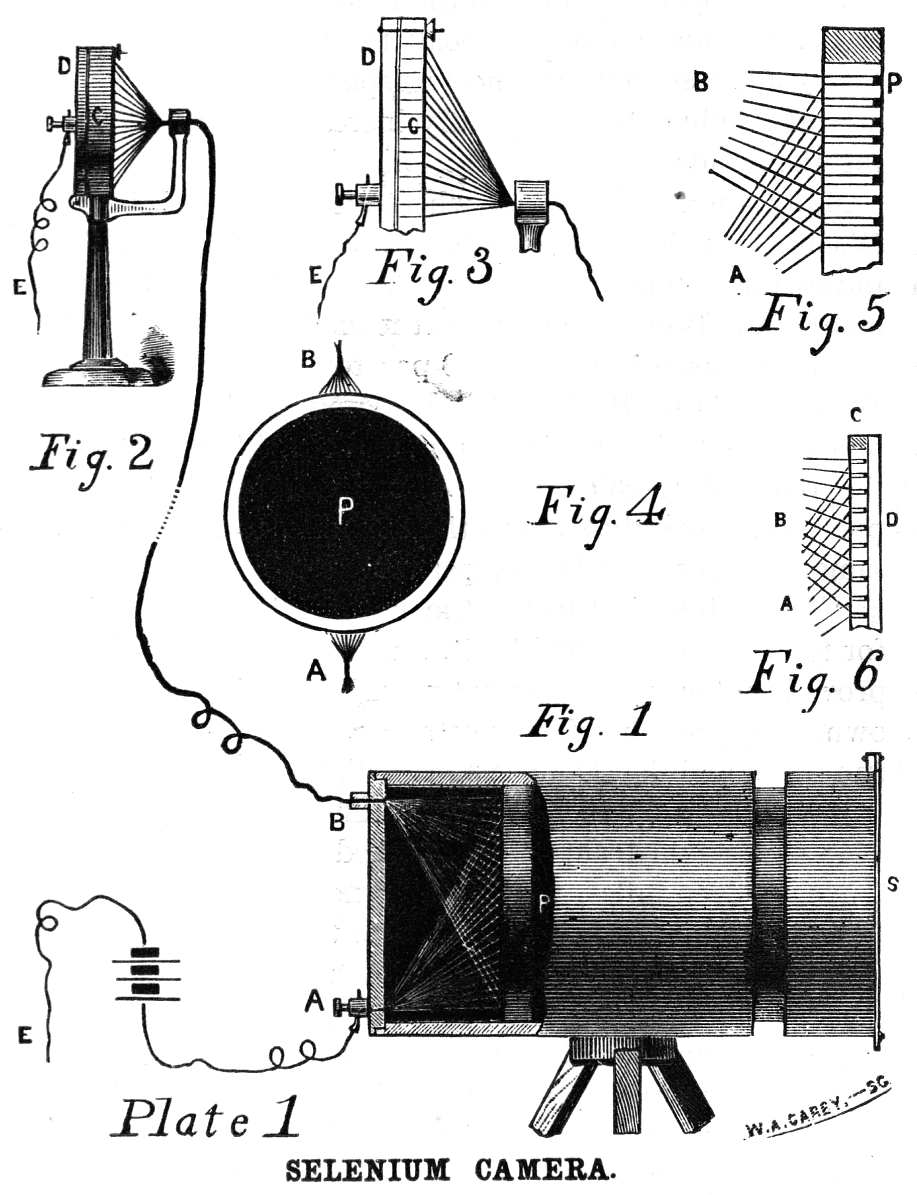
Carey's selenium photocell camera (© Library of Congress) Around the year 1880, long after the invention of photography, various inventors tried to reproduce images by using selenium photocells, wires, electricity and light. The inventions were practically all based on selenium photocells but with different outcome. One invention described that light captured on a selenium photocell would trigger an electromagnetically driven pencil to reproduce the image. Another invention by John Perry proposed an electronic camera that used an array of selenium detectors to convert an image intensity into an array of electrical signals. The camera did not use any type of scanning mechanism which was typical for many early electronic cameras. The camera would be referred to as a focal-plane camera and bears a striking resemblance to modern day CCD cameras.
Some inventions not only proposed an electronic reproduction device but also receivers that could output the image. George Carey for instance was the first person to call a video imager "camera" and Maurice LeBlanc became the first person to propose scanning an image onto a single photocell by using two mirrors that would deflect light onto said photocell. The induced current would then flow to a synchronized light valve using another pair of mirrors to modulate or change the amount of light emitted and displayed at the receiver. By 1881 it was clearly proven that selenium could work for a single image. Shelford Bidwell scanned, transmitted and reproduced images of simple origin in black and white, e.g. a butterfly and a crude drawing of a human face. The images were about two inches square and the entire reproduction process took about twenty minutes. The lack of wisdom and money prevented these ideas and inventions from becoming feasable products. They remained experiments and it wasn't until 1884 when Paul Nipkow started phantasizing about transmitting images after he experimented with his Bell telephone and a selfmade microphone. The then invented Nipkow discs became the fundament of modern day television.
1920 - electrophotography
Some early attempts at electrophotography were made by dutch scientist P.S. Hana in 1920, his patent described an "electrographic process" and a similar attempt was made by Otto von Bronk in 1922 where he used photocurrents on electrosensitive papers. He placed the electrosensitive paper between a photoconductive layer and a conductive plate. Then a voltage was applied across the construction while the photoconductive layer is exposed to the image. The illuminated areas therefore became conductive and the current that flowed into the areas caused a change in color. Similar inventions in this field were later conducted by Dr. Fritz Klutke and Dr. Ulrich Schmieschek as described in their 1937/1938 patent "Photosensitive system for the electrolytic production of photographic images by means of resistance photocells". These very early experiments are now almost forgotten and information about it can only be found in old patents.
In 1932, a belgian engineer by the name of De Meulenaere issued a patent in which he described a process to create images by using Leyden jars and selenium plates. He used this to form an image as a powder pattern on another plate placed close to the selenium surface. His methods were alas never developed into a practical process but it paved the way for the photoelectric formation of latent, electrostatic images.[57]
1938 - First electrostatic image
The more serious and commercial attempts in this field began with the inventions of one Chester Carlson and his patented "Electron Photography". Carlson suggested methods for using a photoconductive and insulating surface to produce electrostatic, latent images. His inventions became the basis for the first practical electrophotographic system. In 1938, together with Otto Kornei, they produced the first electrostatic image on a photoconductive surface. The sensitive plate consisted of a layer of sulphur on a zinc plate which was charged by rubbing the surface with a cloth. The electrostatic image was produced by contact exposure to a prepared transparency. Then developed with powder and transferred to a paper sheet.[57]
1957 - scanner work

First digital picture
(© NIST)The first attempts at recording pictures on magnetic tape were made by the Bing Crosby Laboratories in 1951. Bing Crosby saw the potential of it and started manufacturing the first video tape recorders that could turn images into electric impulses that were recorded and stored on magnetic tape. A few years later Russell A. Kirsch, while at the National Bureau for standards, was working on the first mechanical drum scanner. It was used to measure the variations of intensity on the surface of a photograph. For the scanning and digitizing process the Standard Eastern Automatic Computer was used which was as large as an entire room and the only programmable computer in the United States. By converting the resulting photomultiplier signals into arrays of 176 by 176 binary digits, feeding them to the afore mentioned SEAC 1500 word binary computer, and programming this computer to extract line drawings, count objects, recognise characters of type, and produce oscilloscope displays they created the world's first digital image, a picture of Kirsch' infant son, Walden.[1a]
The picture size of 176x176 was limited simply by the memory capacity of the SEAC. In retrospect Kirsch said the following about his groundbreaking work:
"squares was the logical thing to do, of course, the logical thing was not the only possibility ... but we used squares. It was something very foolish that everyone in the world has been suffering from ever since".
1958 - Texas Instruments and the IC

Kilby's original IC (Photo Texas Instruments)Geoffrey William Arnold Dummer, was a British electronics engineer who was the first person to conceptualise and built a prototype of the integrated circuit. In May of 1952, after reading a paper at the US Electronic Components Symposium, he made the following statement: "with the advent of the transistor and the work on semi-conductors generally, it now seems possible to envisage electronic equipment in a solid block with no connecting wires. The block may consist of layers of insulating, conducting, rectifying and amplifying materials, the electronic functions being connected directly by cutting out areas of the various layers". This is now generally accepted as the first public description of an integrated circuit. His ability to turn his idea of an integrated circuit into practical reality was restricted by his lack of responsibility for active devices and the lack of suitable manufacturing techniques. He never claimed to be the inventor of integrated circuits.[1b]
Jack St. Clair Kilby joined Texas Instruments in Dallas in 1958. Since he was a new employee he had no vacation time coming and during the summer of that year, he was working with borrowed and improvised equipment, when he conceived and built the first electronic circuit in which all of the components, both active and passive, were fabricated in a single piece of semiconductor material half the size of a paper clip. It was a relatively simple device that Jack showed to a handful of co-workers gathered in TI's semiconductor lab, only a transistor and other components on a slice of germanium. Little did this group of onlookers know that Kilby's invention was about to revolutionize the electronics industry. His invention of the monolithic integrated circuit - the microchip - laid the conceptual and technical foundation for the entire field of modern microelectronics, from pocket calculators to digital cameras.[1c]
1960 - NASA's image enhancing experiments
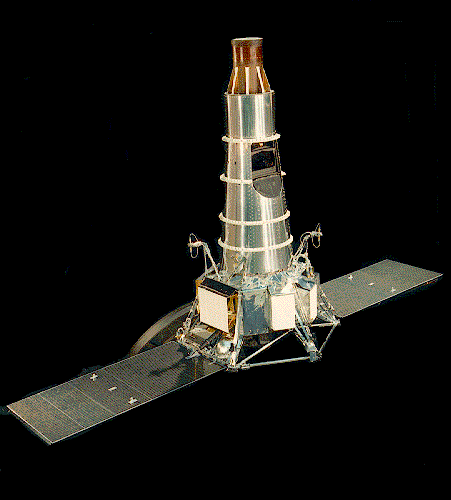
Ranger 7 Spacecraft
(Photo courtesy NASA)The evolution of digital photography and many innovations in this field are directly originating from the U.S. space program and the cold war espionage program run under by the National Reconnaissance Office (NRO), which required construction of cameras that could travel into the space and send back images thus the first step towards digital imaging happened in the early 1960s as NASA geared up for the Apollo Lunar Exploration Program. As a precursor to landing humans on the moon, NASA sent out a series of probes to map the lunar surface. The Ranger missions relied on video cameras outfitted with transmitters that broadcast analog signals. These weak transmissions were plagued by interference from natural radio sources like the sun. Conventional television receivers could not transform them into coherent images. In 1964 Ranger 7 crash-landed on the moon but was able to transmit the first picture ever taken of the moon's surface via television signals.
Researchers at NASA's Jet Propulsion Laboratory (JPL) developed ways to "clean" and enhance analog signals by processing them through computers. Signals were analyzed by a computer and converted into numerical or digital information. In this way, unwanted interference could be removed, while critical data could be enhanced. By the time of the Ranger 7 mission, JPL was producing crystal clear images of the moon's surface. The spacecraft carried six television vidicon cameras, 2 full-scan cameras (channel F, one wide-angle, one narrow-angle) and 4 partial scan cameras (channel P, two wide-angle, two narrow-angle) to accomplish these objectives. The cameras were arranged in two separate chains, or channels, each self-contained with separate power supplies, timers, and transmitters so as to afford the greatest reliability and probability of obtaining high-quality video pictures. No other experiments were carried on the spacecraft. The age of digital imaging had dawned.
1961 - first digital photography concept
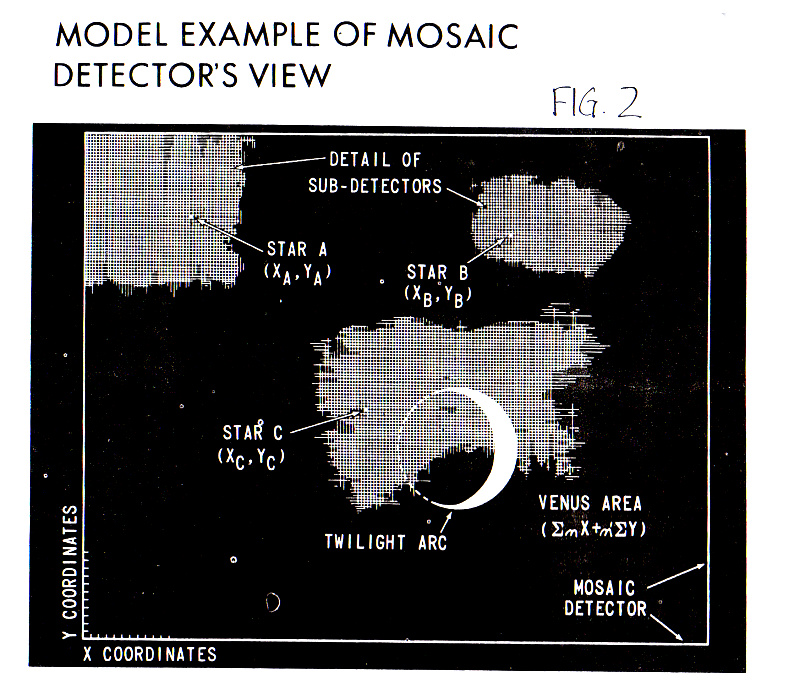
Mosaic view example
(Picture courtesy E.F. Lally)Electrical engineer, scientist, inventor and space age pioneer Eugene F. Lally (while at JPL for NASA) published a paper in February of 1961 called "Mosaic Guidance for Interplanetary Travel"[2]. It proposed for manned Mars missions the design of sensors employing mosaic arrays of photodetectors at the focal plane of cameras with their analogue output converted into the digital domain to provide real-time onboard guidance and navigation. Locations of stars, asteroids and planets were photographed for attitude and position referencing. This was the first presentation of a digital photography concept and digital camera design usable on spacecraft and for general photography. It's concept was way ahead of it's time and technology had yet to catch up with the idea. The autonomous capability of his real-time onboard optical navigation concept was adopted by the Jet Propulsion Laboratory and called AutoNav. This became the central navigation and guidance technology on spacecraft missions for the exploration of space from the 1990s forward. The Kepler Spacecraft telescope uses an advanced version of this digital focal plane to discover exoplanets orbiting stars[3]
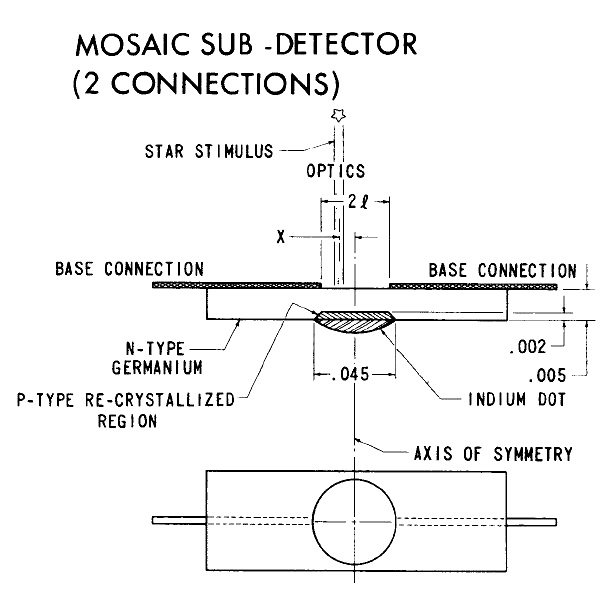
Example of a subdetector
(Picture courtesy E.F. Lally) Before Mr. Lally's papers there was nothing written, built or hinted towards digital photography. He was the first who combined the two words "digital photography" and came up with design ideas. At the time of these papers, no hardware was available to achieve the design but he knew it would follow in good time. Mr. Lally knew what technology was needed and how it could be developed. The papers presented at the American Rocket Society in 1961 where also reviewed by Bell Labs. Bell Labs contacted him and they started their own funded work to move toward developing a light sensitive element, a mosaic element as he called it. Several years later after Bell Labs was successful, Fairchild Semiconductors contacted him when they began to apply Bell Lab's work and started to produce a many element mosaic focal plane sensor. They ended up with one 100 x 100 element (pixel) sensor and asked him if he would like to have it to develop it into a camera as in his initial concept.
But at that time Eugene was working on different projects and space programs, consuming most of his time so he had to decline the offer. He thanked Fairchild Imaging for the proposal and suggested they contact Kodak of which he was sure could make the first prototype digital camera.[4]
1963 - video disc camera and CMOS

David Paul GreggDavid Paul Gregg, in his own words an "eclectic engineer" from Stanford University, claims that he first conceived the concept of the video disc during his employment at Westrex corporation in the late 1950's. It was while at Westrex that Gregg claims he realized it would be possible to burn video and audio information onto a disc master. He not only holds a patent for a optical disk he invented in 1958, but he also invented a Videodisk camera that could store several minutes worth of images at one time.[5a] This technology can be regarded as a precursor to digital photography. I've seen websites and books referring to this camera as being the first digital camera, which of course is simply not true since it was an analog device which propably used an imaging tube. Unfortunately there is no record or spec sheet of this specific camera nor was a patent filed. The impact of his invention would later lead to the development of the CD, the Laserdisc, the DVD and ultimately the Blu-ray disc. Ironically Sony created something similar to the Videodisk camera in the late nineties called the Mavica CD digital camera which used a 3-inch optical disc for image storage.
S. R. Morrison at the Honeywell Research Center developed a new class of photosensitive junction device, including a photopot, a scanner, and an x-y light-spot position indicator. Those devices were constructed with standard semiconductor technology, in his case using diodes diffused into silicon.[5b]
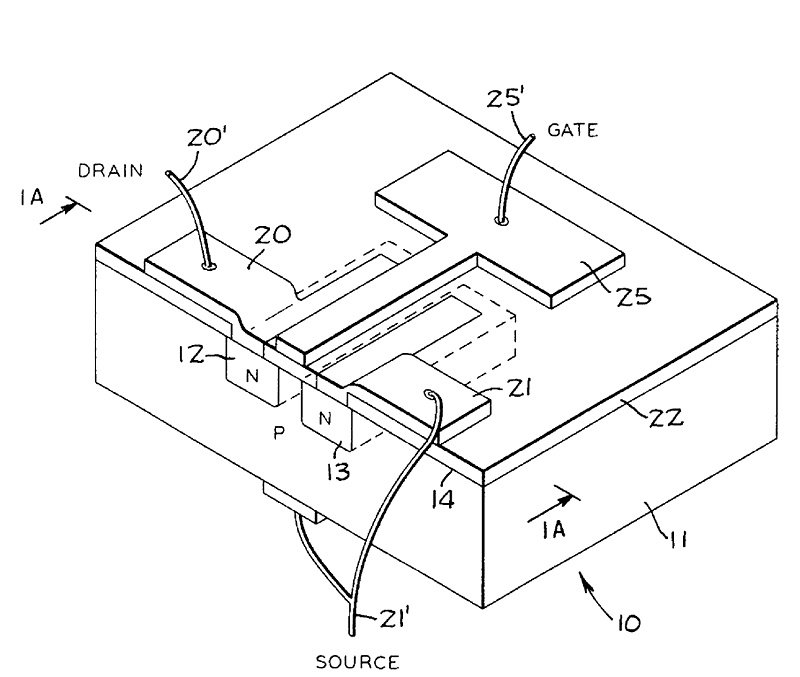
Patent drawingDr. Frank Wanlass, while working for Fairchild Semiconductors, invented and patented the first CMOS logic circuits, or complementary-symmetry metal-oxide-semiconductor in 1963, RCA Corporation followed later that year. This new technology was groundbreaking for its use in computer logic design, communications transceivers, and of course, digital imaging sensors. While most digital cameras do not use CMOS technology, it was a huge step in the advancement of digital photography. He was given U.S. patent #3,356,858 for "Low Stand-By Power Complementary Field Effect Circuitry" in 1967.[6a]
Wanlass' initial demonstration circuit, a two transistor inverter, consumed a few nanowatts of standby power, compared to milliwatts of standby power for equivalent bipolar and PMOS gates. Interestingly, Wanlass utilized Fred Heiman's back-bias methodology to achieve an n-channel enhancement mode device (due to the difficulty of uncontrolled surface charges at that stage of technology to fabricate an n-channel enhancement-mode MOS transistor) to work in conjunction with the conventional PMOS enhancement-mode transistor. CMOS eventually became the ultimate MOSFET technology.
1964 - IBM's Scanistor
In 1963, J. W. Horton and Robert J. Lynch, of IBM's Advanced Systems Development Division (ASDD), invented the "Scanistor". They filed a patent (US3,317,733) for it called "Radiation scanner employing rectifying devices and photoconductors". Their goal was to provide scanners that were simple, compact and inexpensive compared to the existing bulky cathode ray and tube scanners. In November of 1964 IBM announced the development of an experimental solid state optical scanning device to convert images into electrical signals. Approximately the size of a dime, the Scanistor combined high resolution and quick response with other attributes of solid state electronics. Made of silicon and sensitive to both ordinary light and near infrared radiation, the Scanistor test units were tried in such applications as document and film scanning and character recognition.
In december of 1964, they published their results in "Proceedings of the IEEE, Vol. 52, Issue 12, p. 1513-1528" and suggested that Scanistors form a new class of semiconducting devices which perform image scanning or dissection by reason of a novel electronic method of commutating a single output terminal to any preselected illuminated portion of the device. The selection is uniquely determined by a voltage applied across two terminals of the device. The present investigation is concerned with a strip-shaped unit called the multijunction scanistor which is comprised of a linear, integrated-circuit array of photodiodes. This device provides an output either as a sequence of pulses which represent spatial sampling of a line image at a discrete number of points, or as an analog wave-form which is a linear transformation of the line image. The units were shown to give good results when used to scan a typewritten document for facsimile display on an oscilloscope.[6b]
1965 - Pixels
![]()
Pixelated Saturn image (© NASA/JPL-Caltech) ![]()
Non pixelated Saturn image (© NASA/JPL-Caltech) The word pixel was first published by Frederic C. Billingsley of JPL, to describe the picture elements of video images from space probes to the Moon and Mars. Billingsley was an American engineer, who spent most of his career developing techniques for digital image processing in support of American space probes to the moon, to Mars, and to other planets. The origins of the word go way back to the 1930's when Zworykin's television research group at RCA popularized the term "picture element". In the 1960's Bell Labs called it "image element". However, Billingsley did not coin the term himself. Instead, he got the word "pixel" from Keith E. McFarland, at the Link Division of General Precision in Palo Alto, who did not know where the word originated. McFarland said simply it was "in use at the time" (circa 1963). At the same time Bell Labs was in favor of the word "pel". But in the early 1970's "pixel" was spread through computer image processing publications from NASA, USC, IBM and others. To the left you can see a picture of the planet Saturn with pixels as large as 1/16th inch, you can clearly see the rectangular shape of each pixel. To the right you can see an image with pixels as small as 1/300th of an inch each. The image is very smooth and even when zooming in, no pixelation can be found. Today it not only stands for the number of pixels in an image, but also expresses the number of image sensor elements of digital cameras or the number of display elements of digital displays.[7a]
1966 - (photo)dielectric tape cameras
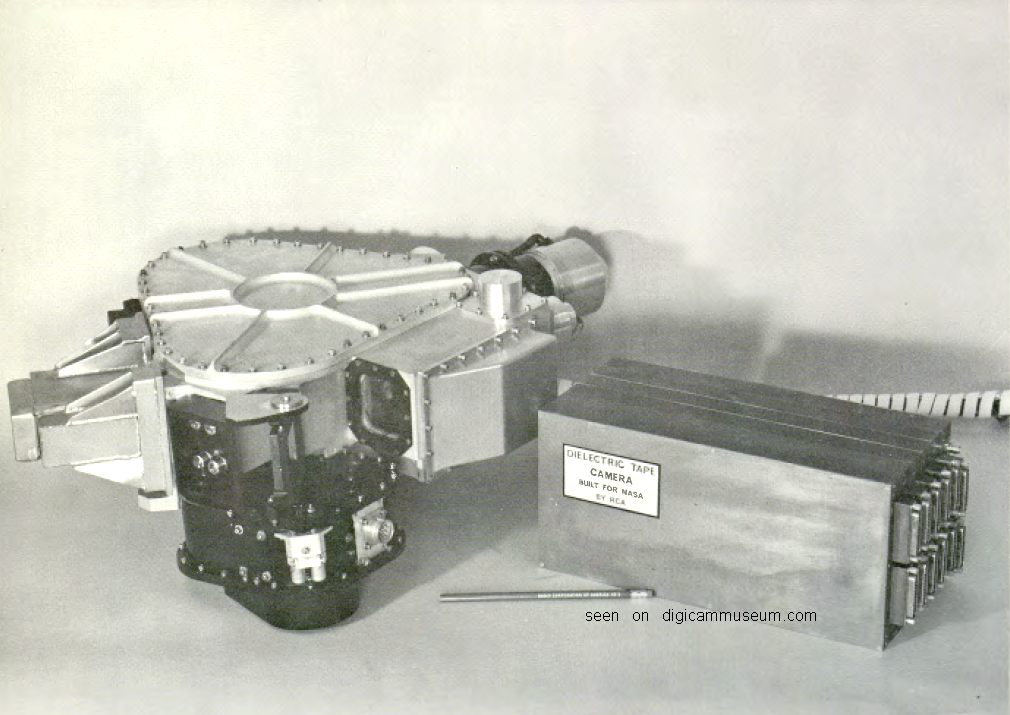
NASA dielectric tape camera (© RCA) 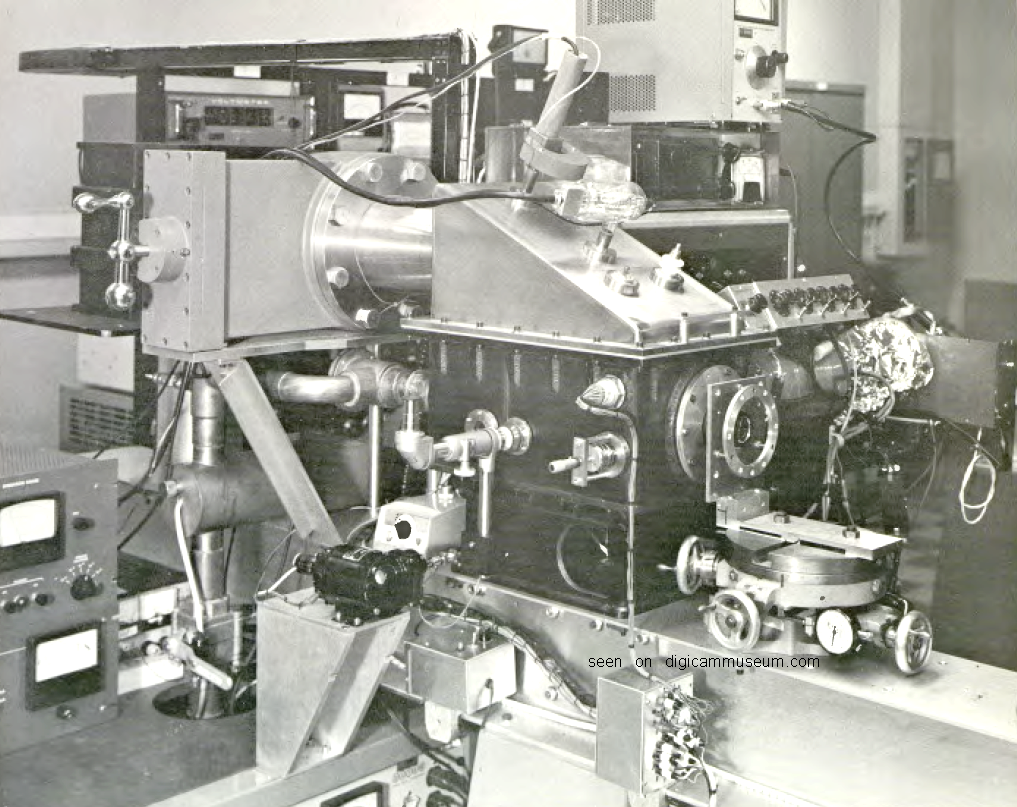
Airforce dielectric tape camera (© RCA) RCA announced a dielectric tape camera system for spacecrafts. It recorded images electrostatically on special plastic tape. Images could be erased and stored permanently without resolution loss. The camera could use color filters for mapping distant planets in color. A camera for NASA was built. The fruits of these efforts were described in a 1968 paper by James D'Arcy, an EE from RCA's Astro-Electronics Division. It presented a TV camera which combined the features of an image sensor and an electrostatic tape recorder in one package. A so-called photo-dielectric tape camera. The optical images that were sensed by the camera were stored directly on dielectric tape in the form of charge patterns. The stored information could be retrieved immediately or retained for as long as several months. Dielectric tape was a sort of reusable electronic film, available in 35mm and 70mm. At the time of the paper two such cameras had already been built. One for the US Airforce and one for NASA. The camera was operated in three ways, preparation, recording and playback. First the tape had to be prepared by charging it, this would remove any charge pattern that existed and would prepare the tape to exposure. The preparation process required saturating light and an electron flood beam. The light would short-circuit the photo-conductor resistance while the flood beam would charge the surface of the tape. The recording process then placed a focused optical image on the tape in the form of a charge pattern. The playback function would then convert the charge pattern into an electric signal which was transmitted to the ground station.
In case of the NASA camera it consisted of a gun which was similar to a 1-inch vidicon. A signal readout was achieved by "shooting" at the tape with 350V and therefore generating secondary electrons, a secondary structure close to the tape would separate these electrons and provide the output signal. The Airforce camera used a 4.5-inch orthicon. The NASA tape camera was approved for space flight and was developed for use in the Nimbus satellite. It was to provide high resolution images of earth's cloud cover. The tape was caught on reels. One reel consisted of 90 feet of tape which was good for about 120 images. The camera resolution was 1400 TV lines. Capturing one image took 26 seconds. Playback and transmitting an entire reel down to earth would take 8 minutes. The camera and it's electronics weighted 83 pounds. Power consumption was 25 watts in recording and 30 watts in playback mode. [56]
1967 - TFT and tubeless camera
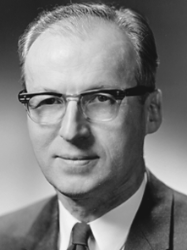
Dr. Paul Weimer (© NAS/NAE) 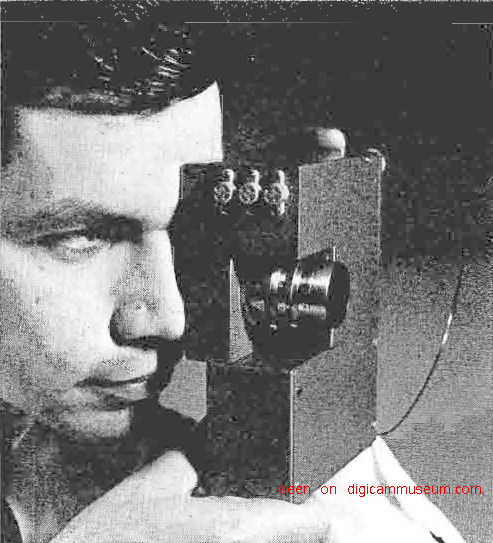
First tubeless camera (© RCA) Gene P. Weckler at Fairchild suggested operating p-n junctions in a photon flux integrating mode. The photocurrent from the junction is integrated on a reversebiased p-n junction capacitance. Readout of the integrated charge using a PMOS switch was suggested. The signal charge, appearing as a current pulse, could be converted to a voltage pulse using a series resistor. A 100x 100 element array of photodiodes was reported in 1968. Weckler later called the device a reticon and formed Reticon to commercialize the sensor.[7b]
Meanwhile, at the RCA Laboratories, P. K. Weimer reported a thin-film transistor (TFT) solid-state image sensor using CdS/CdSe TFTs and photoconductors. The 180x180 element array included self-scanning complementary logic circuitry for sequentially addressing pixels. An experimental television camera incorporating a completely integrated self-scanned solid-state image sensor had already been built in 1966. The integrated sensor included a photosensitive array having 32 400 picture elements, two 180-stage shift register scan generators and associated video coupling transistors. This large-scale integration of more than 100 000 components was carried out in the laboratory entirely by evaporated thin-film techniques. Each element of the photosensitive array comprised one or two photoconductors of CdS or CdS-CASe mixture, each in series with a diode. The array that was scanned at conventional television scan rates permitted the picture to be displayed upon a commercial television receiver. The camera could be connected to the receiver either through a cable or through a UHF link with camera and transmitter powered by a self-contained battery. Camera circuits other than the integrated sensor employed conventional transistors and integrated components. Dr. Weimer was among the pioneers who developed the "Image Orthicon", a television camera tube that was used for nearly 20 years in the US. After that he did pioneering work in the thin film transistor (TFT) technology and it's use in integrated circuits.[7c]
1968 - Bucket Brigade

Patent drawingOne year before Boyle and Smith would come up with a CCD, three fellows from Philips Labs. in NY filed for a patent on "All Solid State Radiation Imagers". Edward H. Stupp, Pieter Cath and Zsolt Szilagyi came up with a concept of digitizing images on scanners and a concept of digitizing video signals, predating the concept of making still pictures by digitizing signals from an array of discrete sensor elements. They constructed a flat-screen target for receiving and storing an optical image on a matrix composed of an array of photodiodes connected to a capacitor to form an array of two terminal devices connected in rows and columns. The patent was granted in 1970 and a breadboard of the concept was built. It was the first Solid State imager patent ever. Philips thus invented and patented the bucket-brigade-device (BBD), a predecessor to all other charge-transfer devices like the CCD. For various reasons the BBD was never seriously considered for use as an imaging device. Bell Labs and Philips worked independently on such devices unaware of each other's inventions until 1970 when both companies made publications about their work.[8][9]
Also active at that time was Plessey Semiconductors in the UK. In a 1968 seminal paper, P. Noble described several configurations of self-scanned silicon image detector arrays. Both surface photodiodes and buried photodiodes (to reduce dark current) were described. Noble also discussed a charge integration amplifier for readout, similar to that used later by others. In addition, the first use of a MOS source-follower transistor in the pixel for readout buffering was reported.[7b]
1969 - first CCD
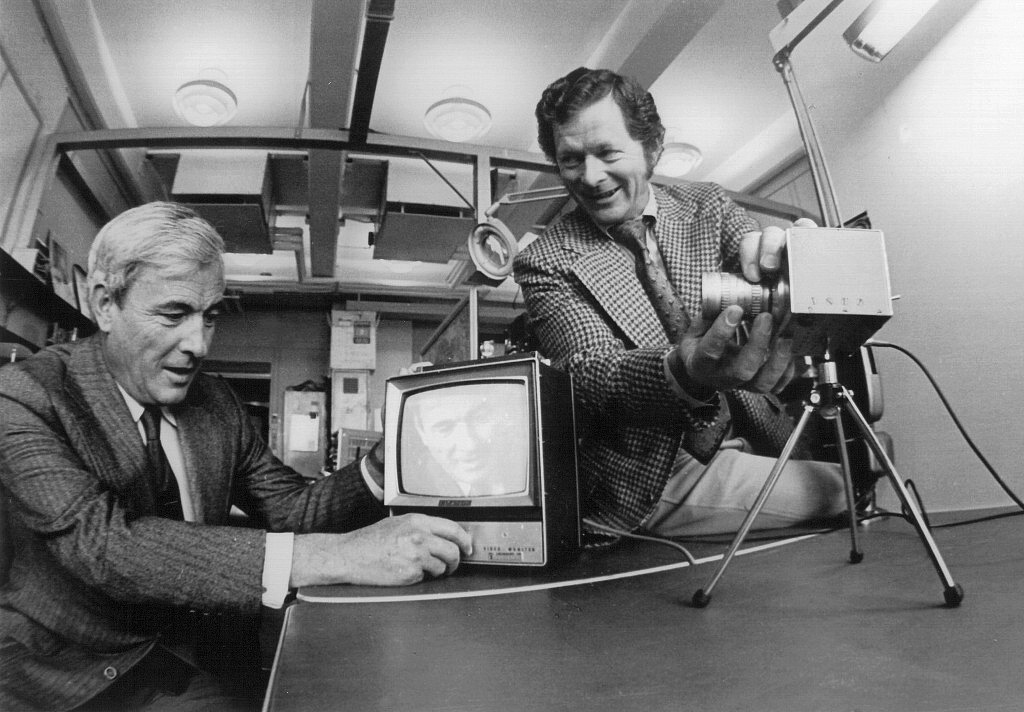
Boyle and Smith (Photo Alcatel-Lucent/Bell Labs)
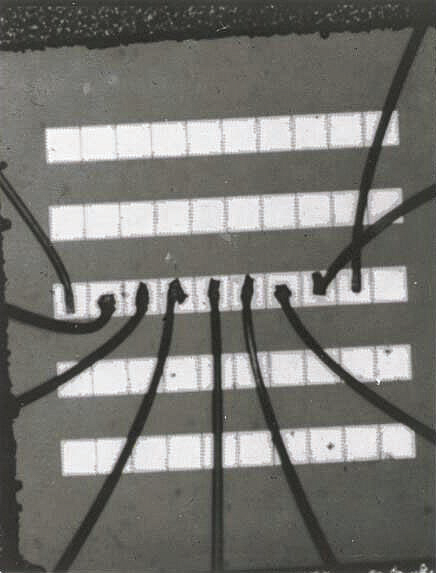
First CCD
(Photo Alcatel-Lucent/Bell Labs)The charge-coupled-device (CCD) was invented at AT&T Bell Labs by nobel prize winners George E. Smith and Willard Sterling Boyle on October 18, 1969. The story behind the invention is that Jack Morton, VP of Bell Labs Electronics Technology, was a strong proponent of magnetic bubble memory and he wanted to speed up the development of said memory as he saw great potential in it. Also at that time there was talk of resources being transferred to the magnetic bubble department and for this not to happen, he encouraged Boyle to come up with something that could compete with magnetic bubble. Around that time though the picturephone was being produced using diode arrays in silicon. But it seemed that charge storage on individual diodes had been somewhat problematic and new research was needed. Bearing the three existing technologies in mind (magnetic bubbles memory, silicon diode arrays and MOS technology) the CCD was invented. In a one hour meeting it took them just about thirty minutes to sketch out the CCD's basic structure, define the concept of it's operation, and outline the applications for which it would be best suited. Only a few weeks later a three-phase device was designed, manufactured and tested proving their drawings to be accurate. Because of charge transfer inefficiency (the inability to transfer all of the charge from one element to the next) lead them to invent the buried channel CCD for which they filed a patent. The invention was publicly announced in April of 1970.[10]
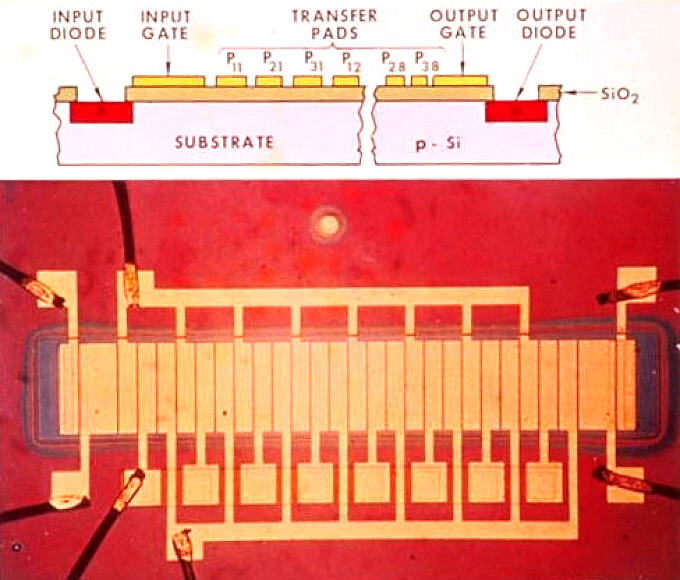
First integrated device
(Photo Alcatel-Lucent/Bell Labs)
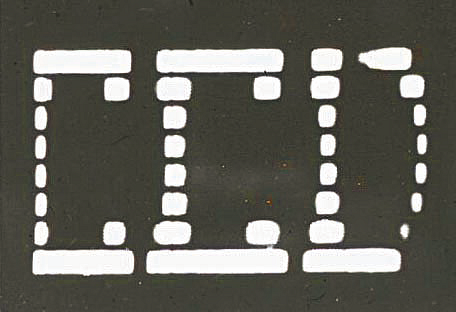
Oscilloscope output of the 8-bit imager device
(Photo Alcatel-Lucent/Bell Labs)The CCD quantized light focused directly on a pixel array. The CCD counts photons of light that fall on picture elements (pixels) creating a serial numeric electron count. The chip's exposure time could be varied (trading for higher noise) making it parallel to film. The electron count is converted into machine code by an analog to digital converter (ADC). The first CCD was rather crude and a follow-up was the first integrated structure. The device had a three-phase metallization as well as a diffused input and output proving that it could be operated as a serial memory which was the original idea behind the invention.
Although they invented the CCD it stirred controversies. That's because the basic idea behind it was to develop a new means of computer memory circuit for a picture phone. It wasn't until spring of 1970 that the discovery was made that a semiconductor was also photo-sensitive and thus could be used for imaging. Eventually the 8-bit CCD was used as linear scanning imaging device and the rather crude result were the letters "CCD" on an oscilloscope.
Until today Bell engineers Eugene Gordon and Michael Tompsett claim to have been the responsible ones for determining that the CCD could revolutionize all sorts of imaging. Plus Tompsett's name was on the patents for the imaging device. Furthermore Gordon claimed that Tompsett's patent was for the CCD, and that Smith and Boyle had patented a charge-coupled device shift register, which had nothing to do with imaging.[11] The sole inventor for the CCD as an imaging sensor therefore is Dr. Michael Tompsett and no one else. Since Bell Labs was not allowed to sell devices on the open market by the government of the US, their interest in imaging devices died with the picturephone.[12] There is an extremly interesting video here from Alcatel Lucent where Smith & Boyle talk about their CCD invention. The entire interview was shot using a CCD camera! https://www.youtube.com/watch?v=51Za3FY1axI
Sidenote: between 1971 and 1975 dozens of corporations and companies were manufacturing charge-transfer devices either for computer memory or imaging applications. Namely General Electric, IBM, Hughes Aircraft, Matsushita, Texas Instruments, RCA, Fairchild, Philips, Hitachi, NEC, Bell Labs, Thompson, Intel to name a few.
1970 / 1971 - CCD camera
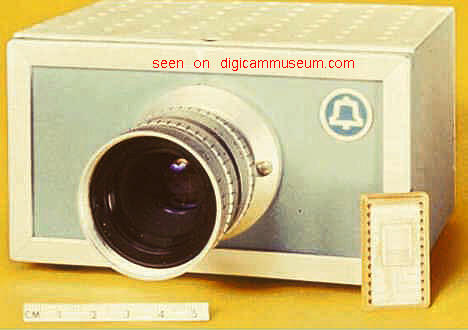
CCD Picturephone imaging chip
and self-contained camera
(Photo Alcatel-Lucent/Bell Labs)
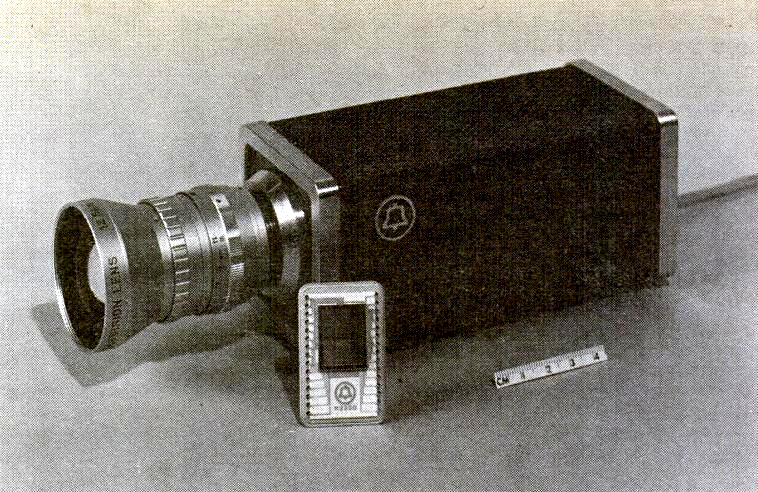
Bell Labs CCD TV of 1975
(Photo Alcatel-Lucent/Bell Labs)By 1971 Bell researchers were able to capture images with simple linear devices. But soon other companies like Texas Instruments, Sony and RCA picked up on the invention and started development programs of their own. Sanyo announced in 1971 to market a solid-state camera in 1972 called the VC-100.
Afore mentioned CCD was used to build the first solid-state video camera at Bell Labs. Although their original intention was to build a simple camera that could be used in a video-telephone device (see left picture), they soon built a camera that was good enough for broadcast television by 1975. Commercial TV resolution in the US at the time was 525 lines compared to Europe's PAL standard of 625 lines. The experimental camera measured about 6 x 15 cm. The CCD's surface had been engraved by a new electron beam exposure system with 496 vertical interlaced scan lines and 475 horizontal picture elements. But it was not perfect. Blemishes would appear on the screen as a result of defects in the readout.[13]
The camera can also be seen in the popular Smith & Boyle Video on Youtube: https://www.youtube.com/watch?v=51Za3FY1axI
1971 - first digital camera patent
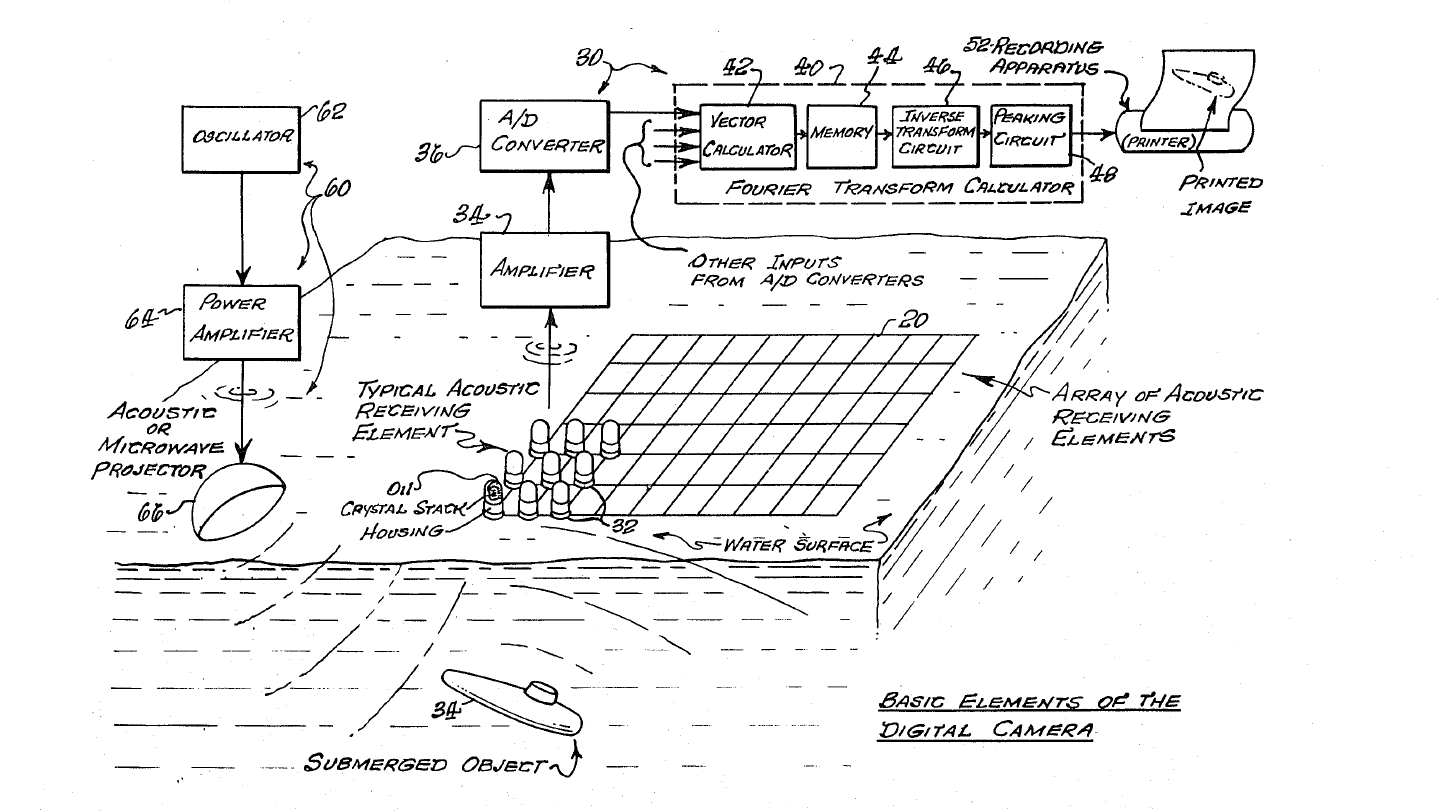
First digital camera patent (© public domain) Louis A. Lopes Jr. and Owen F. Thomas filed the very first digital camera patent ever on June 24, 1971. According to the patent the invention was a gift to the US government. The inventors did not insist on payment or royalties. Unique about this invention is that not that an imaging sensor is used but instead an acoustic sensor. The invention showed a method to photograph submerged submarines. Instead of an imaging sensor the invention used the readout of a matrix of omnidirectional hydrophones (without the use of a physical lens), which were then digitized, buffered, processed and either stored on a digital computer or printed out as a hardcopy on a printer. It described a process of acoustic imaging. First tests were simulated with a UNIVAC 1108 computer. In order to produce an image the object needed to radiate the proper frequencies by itself, if not, an oscillator and ampflifier were needed to produce sinusoidal voltages.
Basically the object reflects or radiates energy to an array of receiving transducers connected through amplifiers and A/D-converters to a digital computer. The computer performs an analysis of the phase and amplitude of each element, stores the values in an array, digitizes it into a new array which is the image in complex notation.The digital computer then starts forming another image by performing a spectral analysis on the time samples from the A/D converters as above and repeats the operations required to output an image.
1971 - McCord & Westphal camera
I have to make a step forward here because Dr. Roger N. Clark shed some new light on the early developments in digital camera history. According to his website Thomas B. McCord of MIT and James A. Westphal of CalTech had already built a digital camera and published their results in the journal Applied Optics. (McCord, Thomas B. and Westphal, James A. (1972) Two-Dimensional Silicon Vidicon Astronomical Photometer. Applied Optics, 11 (3). pp. 522-526. ISSN 0003-6935). Their camera used a silicon vidicon 256 x 256 pixel array (0.065 megapixel) and wrote 8-bit image data to 9-track magnetic digital tape in about 4 seconds. They published isophote images of Jupiter and the globular star cluster 47 Tucanae obtained at the Cerro Tololo Interamerican Observatory, Chile, in 1971. Their paper was submitted to Applied Optics on October 12, 1971 and the paper was published in March 1972.
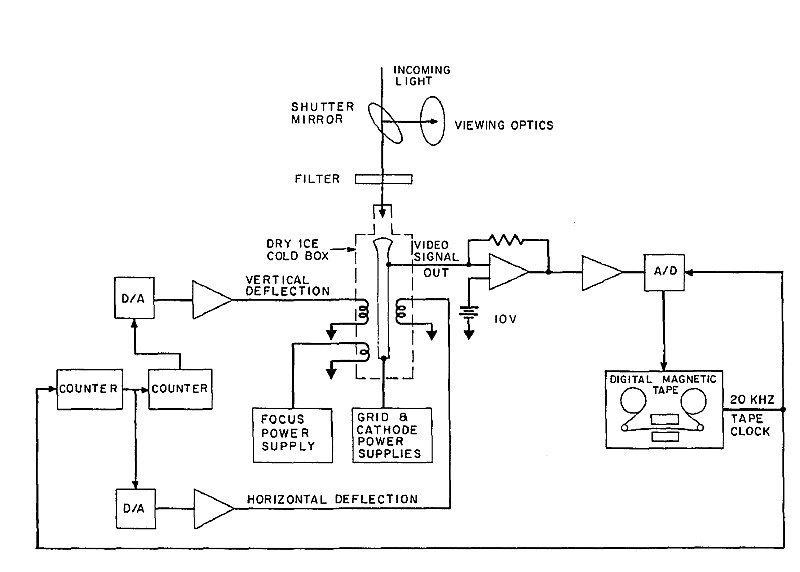
Schematics of McCord & Westphal cameraThe McCord and Westphal "digital camera" weighed 10kg and had approximate dimensions of 20 X 20 X 40 cm. The electronics and tape recorder were mounted in a 53-cm electronics rack and the camera was attached by a cable. Thus a tethered system. McCord and Westphal filed a patent (U.S. Patent 3951552) on August 7, 1972 on their "digital camera" and the patent was issued on April 20, 1976. The patent includes the statement: "After a predetermined vidicon exposure interval the image electrically stored in the target is read out by a scanning electron beam, digitized and recorded to provide an immediately available digital record of the object.".
The "digital camera" was first presented publicly at the end of August 1971 at a conference in Santa Cruz, California (see Westphal and McCord, 1972). McCord's lab at MIT went on to produce improved digital cameras. J. Kunin, in his MIT 1972 masters thesis, describes the second generation McCord digital camera. It used an RCA 4532A vidicon tube, a 10-bit analog-to-digital converter, of which the top 8-bits were used, and data were recorded to a 9-track magnetic tape drive. The system wrote 256x256 pixel images to tape in 3.3 seconds and images were displayed on a 9-inch monitor.
Both the McCord and Westphal and the Kunin described systems had a peak quantum efficiency in the visible spectral range of over 80%, higher than today's consumer digital cameras by about a factor of 2. Both systems were also used for astronomical applications, so they cooled the vidicon tube to dry-ice temperature, which reduced dark current allowing exposure of many minutes. The data system described in Kunin's thesis allowed exposure times from 0.01 second to 99.9 minutes.
The system described by Kunin included improvements made over the original McCord and Westphal camera. Those improvements included the monitor to display images a few seconds after the camera acquired an image, and improved cold housing of the vidicon tube. Kunin's thesis showed black and white images from the system, including dark frames and images of the Moon.Kunin also describes development of computer digital image processing tools to handle their new data. Tools included addition, subtraction, and ratioing of digital images. Further, the MIT group was developing computer digital image processing routines by 1972 to analyse the images from their digital cameras.[14]
This takes the discussion about the origins of digital cameras to a whole new level. I think more important is what applications were the inventions intended for. What did the inventor have in mind when he built or patented his idea? All the major universities and a lot of companies tinkered with image dissectors, tubes, silicon arrays and what not in the seventies. There are numerous patents out there proving this. The major fields the inventions were intended for were broadcasting, laboratory research and astronomy.
1972 - Adcock and bell labs
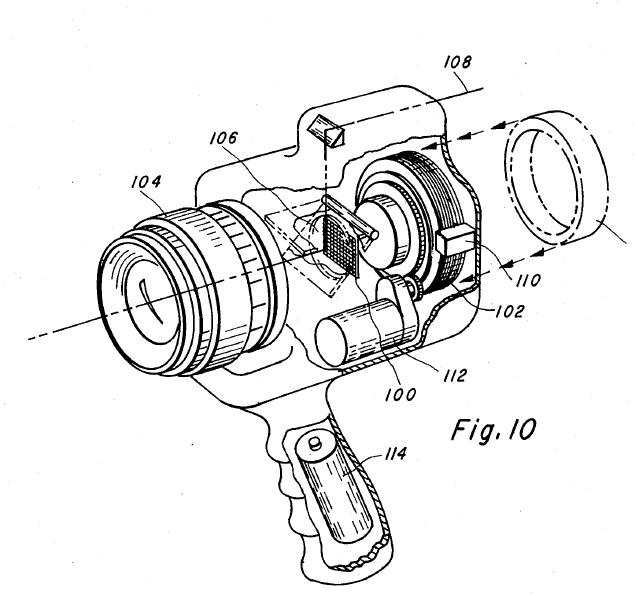
Possible invention embodimentIn 1972 electrical engineer Willis Alfred Adcock (who worked for Texas Instruments) filed a patent for an electronic photography system aka filmless camera (part of Dr. Adcock's work at Texas Instruments involved growing the first silicon boule that permitted construction of the silicon transistor which made the company a world leader in semiconductors).[15]
The subject was "A completely electronic system for recording and subsequently displaying still life pictures includes an optical-electronic transducer for generating electronic signals responsive to an optical image. The signals are stored and subsequently applied to a visual display. Means are provided for applying the signals at a scan rate synchronized with the scan rate of the display to effect a stationary display of the optical image. Preferably, the display is a conventional television set".
The camera alas was never built. It remained a patent. Interestingly Willis Adcock became the liaison between Texas Instruments and Bell Laboratories. Also Texas Instruments had a patent license from Bell Labs. In an interview conducted in 2000 by David Morton, Willis Adcock claimed that Texas Instruments invented the CCD for electronic cameras but never entered the business.[16]
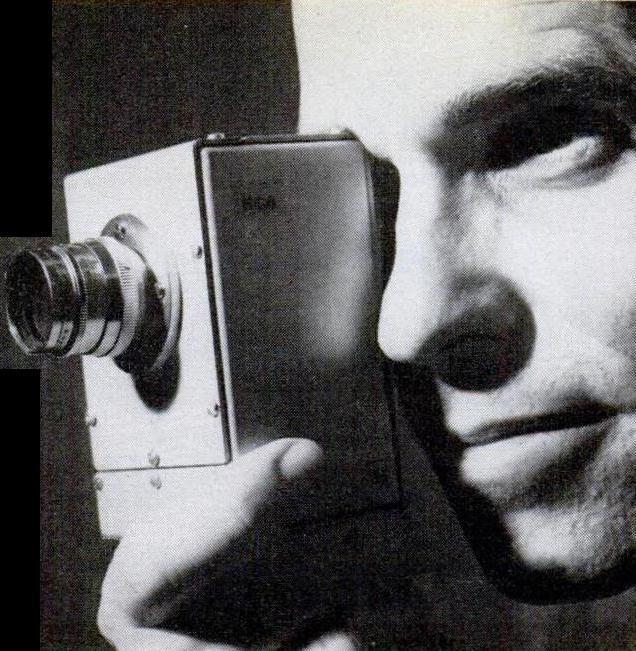
RCA prototype CCD TV
(Photo RCA)Also in 1972 RCA presented a prototype CCD TV camera that incorporated a CCD from Bell Labs. The CCD had a resolution of 32x44px (1,408 total) and the image produced was coarse and grainy (a regular vidicon TV camera easily reached 400,000 pixel). So the excitement rather stemmed from the camera's size, not it's performance. The camera measured only approx. 2x2x3 inches and had a weight of 450gr and was kindly dubbed the "bucket-brigade charge-transfer camera" (due to the way the sensor works).
But RCA thought or even predicted that the cameras would eventually have better resolution and could be made smaller as for example a wrist watch. In November of 1972 Bell Labs tested a color CCD TV camera. The camera was built by Mike Tompsett. Far from being ready to sell, the camera measured 8x9x5 inches and weighted only a few pounds. The camera used three CCD's and a beam splitter.[17a]
1973 - Fairchild CCD
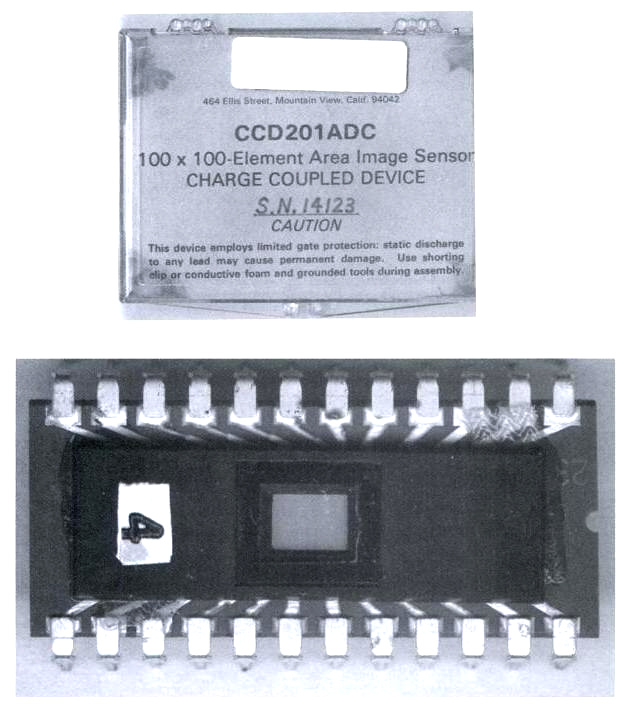
Fairchild CCD201ADC (Photo Fairchild)Fairchild Semiconductor was the first company to commercially produce CCD's. At first the CCD101ADC, a monolithic self-scanned 500-element linear array designed for slow scan TV, document reading and other high sensitivity imaging applications. Later that year the more successful and widely spread CCD201ADC, a 2D 100 x 100 pixel device (100 rows, 100 columns). Giving birth to a lot of innovative opportunities and possibilities. After commercialization research was made towards better CCD's that allowed for higher resolution. By 1974 the following CCD's were under development or under design: the CCD110ADC, a 256-element linear array, the CCAID-244A and CCAID-244B with an array of 244x190px, the CCAID-488A and CCAID-488B with an array of 480x390px.
The datasheet for the CCD201 provided the following general description "The CCD201 is a 2-phase 10,000-element self-scanning image sensor. It uses charge coupled technology, the light sensitive area is a 100x100 array of photo elements which provide an image aspect ratio of 4x3. The CCD operates under 20V. In addition to the image array, the CCD201 chip includes 100 columns of 2-phase analog shift registers interdigitated in the photosensor array and a 102-element 2-phase analog output shift register, an output detector/preamplifier and a compensation output amplifier". Fairchild demonstrated the CCD-201 sensor on August 21st of 1973 in a miniature TV camera . The price in 1973 for that CCD was $965.
One year later, the Fairchild CCD was used to produce the first astronomical photo ever taken by an electronic camera with an image sensor. It was an image of the moon captured using a 200mm telescope. The charge transfer efficiency of this CCD however was so low, that the overall yield was less than 0.5%. Which in turn was much less than the better photographic plates at the time and consequently observational astronomers were somewhat less than enthusiastic about replacing glass plates with digital electronics.
Soon RCA, now manufacturing their own CCD's, announced an even larger solid-state imager than Fairchild's CCD. It contained 120,000 elements. It was announced as a "key milestone in the creation of a new generation of tubeless cameras". Please note that half of the 120,000 elements were for the imaging array and the other half for storage and readout. The race for larger solid-state imagers was on.[17b]
1973-1975 - first commercially available CCD cameras
The story behind the ominous Fairchild MV-101 and it's equivalents.
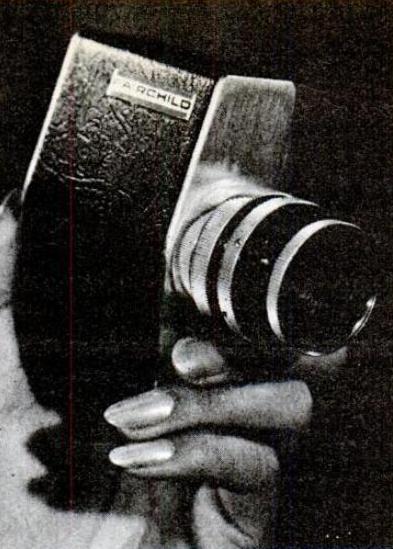
Fairchild MV-100
(Photo Fairchild Corp.)Although Fairchild Camera and Instruments Corporation created the first commercial CCD camera, it wasn't the Fairchild MV-101. In August of 1973 the Fairchild MV-100 was introduced, the first commercial CCD camera (source: Electrical Design News, vol. 18, 1973), already equipped with a 100x100 CCD. A palm-sized miniature CCD TV camera, 6 oz in weight. Although not intended to meet TV broadcast standards, the MV-100 was aimed at surveillance, medical instrumentation, and process-control markets.
It's follow-up, the more widespread MV-101, weighted about 11 oz, measured 7.6 cm in diameter and 4.75 cm long and had a resolution of 0.01 mp (100 x 100 pixel), it was announced at a street price of $4000 and was titled "pocket-sized solid-state camera". The horizontal resolution was 75 tv lines with nine shades of gray. Sensitivity was optimum in the near-infrared so it could be used with invisible infrared illumination sources. Fairchild was the technology leader in CCD image sensing for well over a decade. So one use for their CCD cameras was for product inspections.
The camera was also used to build pressure tolerant TV cameras for oceanic engineering[18a]. Also a lot of websites mention 1976 as the manufacturing year of the MV-101 but it was already designed and manufactured in 1973. Otherwise the camera could never have been disclosed to the public on February 8th, 1975 at a showcase at Lincoln Center, NY where an 18-month experimental program had been launched as how new TV technology could be used in performing arts. Showcased was an impressive display of videotape recorders, video disks, screen projectors and pocket cameras. Contrary to popular belief this was not a digital camera or a photo camera but simply a TV camera utilizing a CCD.[18b]
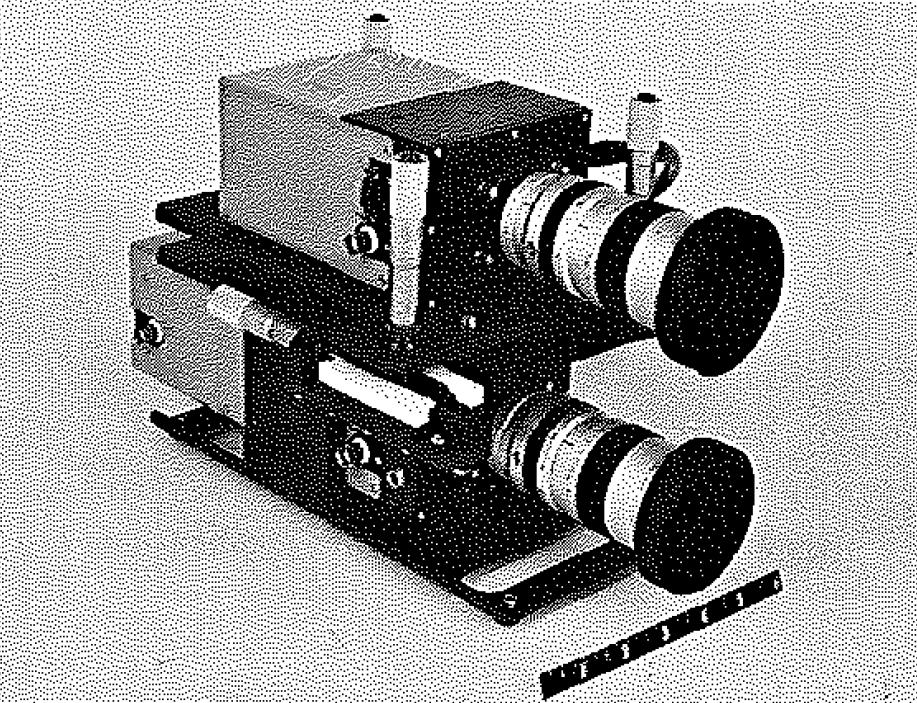
Fairchild Boresight Camera
(Photo Fairchild Corp.)
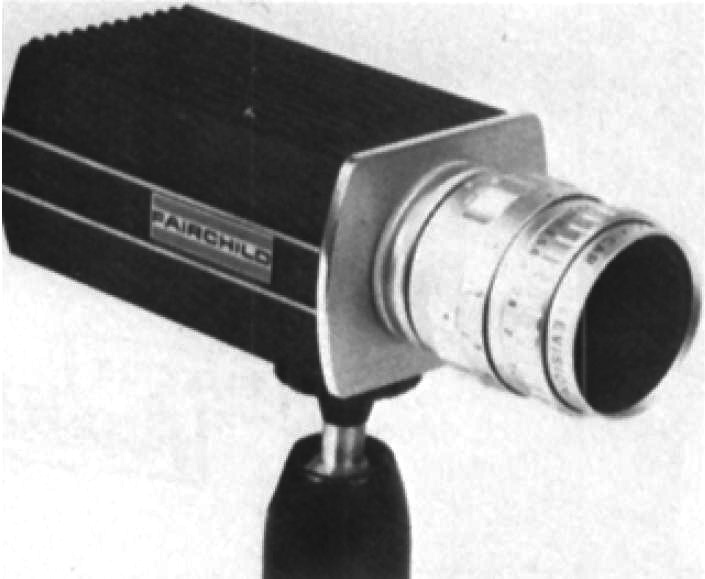
Fairchild MV-201 (Photo Fairchild Corp.In early 1976 the camera was succeeded by the Fairchild MV-201. This model had a 244-line resolution using a 244x190 pixel sensor, the Fairchild CCD211. It measured 2"H x 2.5"W x 3.75"L and weighted 12 oz. The MV-201 was a sophisticated piece of equipment at that time and was almost exclusively used in military and industrial low-light applications. This was also the first one of the three MV cameras that could be connected directly to a conventional TV receiver. Operating at 4 Watts and with a 12 Volts battery was also possible. The market price was aimed at $4,000. There were three different design versions planned or in development. The retail version, a hardened version for the "US Army Shell expirements" and a version for borehole applications. The latter one consisted of two MV-201 cameras connected to each other with a MCU (multiplex control unit) between them. This set became known as the Boresight-244 system. Each camera could operate as a stand-alone unit. The cameras ran synchronously in a master/slave relationship.[19a]
1974 - Bayer Mosaic and CCD TV cameras
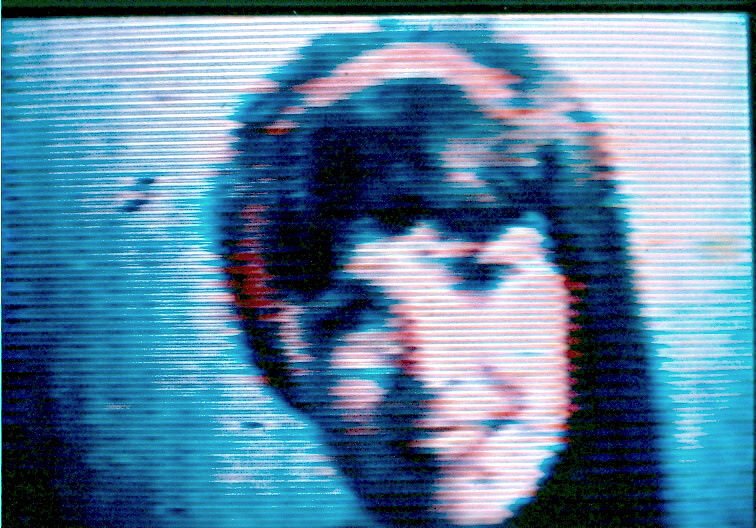
Early Bayer Color Filter Array image
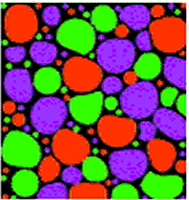
Autochrome grain plateKodak engineer Bryce E. Bayer invents and develops one of the most significant parts in digital cameras, the Bayer filter mosaic for arranging RGB color filters on a square grid of photosensors. It's particular arrangement of color filters is used in most single-chip digital image sensors used in digital cameras, camcorders, and scanners to create a color image. The filter pattern is 50% green, 25% red and 25% blue. Something similar to the autochrome plates that the Lumiere Brothers patented in 1906 when they dusted plates with millions of potato starch grains that were dyed in red, green and violet. It worked as a filter mosaic. Glass was coated with liquid pitch and mixed with a small percentage of beeswax, then the prepared grain was dusted on. Lampblack was used to fill the spaces between the irregularly shaped grains. Back then it was the standard for colour photography as the Bayer filter is for modern digital cameras. There was even a manual issued to describe the complex procedure on how to use the autochrome plates properly.[19b]
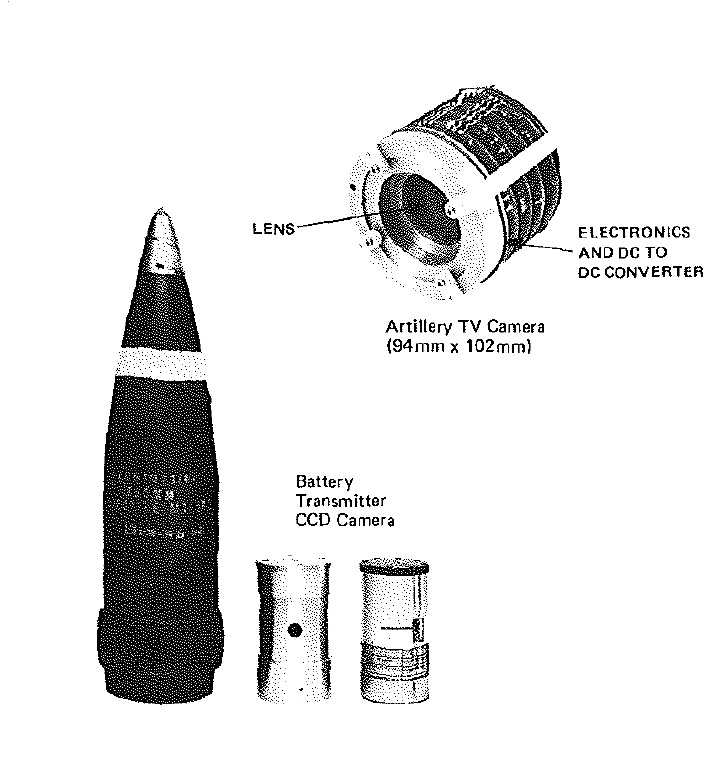
Artillery TV pack (Picture WSTIAC)Work and progress on the CCD's went on. The successors of the CCD201ADC were already introduced in white papers and in basic production. The Fairchild Camera and Instrument Corporation had a special Space and Defense Systems Division which together with the US Army worked on new means for CCD cameras, especially TV cameras that could be used in reconnaissance. In a 1974 document a concept for "Artillery launched TV" is proposed. The objective of the effort was to demonstrate some of the capabilities and limitations of a charge-coupled device TV camera as it might be used in a aerial reconnaissance system. The idea was to take a TV camera with a CCD, a transmitter, an antenna and a battery pack and wrap it up in a 155mm shell. The projectile would be fired by artillery over enemy territory. At a certain point the TV pack would be deployed and parachute down to earth whilst taking pictures of the ground. The received signals would be monitored back at the base station on a real-time TV display and recorded on a video-tape recorder for later playback, photography and analysis. At the time it was quite extraordinary in a way because CCD TV cameras weren't commercialized back then. There were barely some available. It was still brand new technology.
The technology used for this concept consisted of a Fairchild MV-100 TV camera. Operating with 24V from (4x 6V cells). The camera was mounted with a 10mm lens with iris adjustment. A prototype was built and the entire TV package weighted about 17 pounds. Several tests were performed with the system being wrapped in styrofoam and dropped from a helicopter by it's own parachute or attached to a paratrooper. The CCD TV camera "survived" 4 paratrooper jumps and 9 drops on it's own while floating down to earth by it's parachute. The transmitted images were of excellent quality and photographs were made of the TV set using a still camera. These experiments went on and later a special variation of the MV-201 was used[20a]. These shell packages also contained self-destruction charges so that the entire camera package would become unusable would it ever fall into enemy hands.
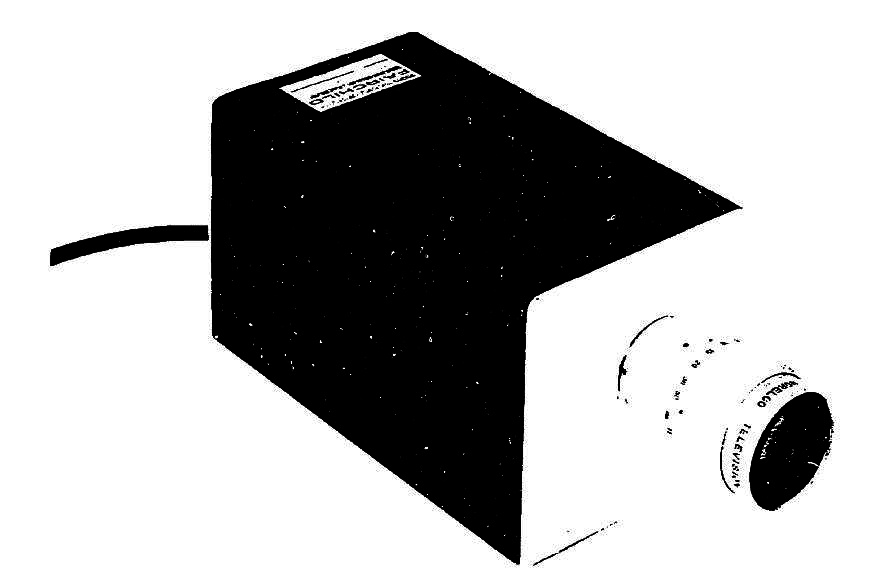
Fairchild CCD TV camera
(Picture Fairchild Imaging systems)Also between 1973 and 1974 a television camera system utilizing the CCAID-100BD sensor was built and delivered to the Naval Electronics Systems Command. The system consisted of a totally self-contained camera unit and a modified 8" display monitor. The CCD socket was a zero-insertion force type enabling quick device replacement without stressing the substrate or pin connections. The camera was built with a lot of features like gamma correction, black level stabilization, C and D-mount lens compatibility, clock voltage adjustment through pots, EIA compatible output for video tape recorders, horizontal aperture correction.[20b]
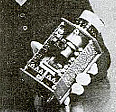
RCA CCD TV camera
(Photo RCA Corp.)RCA (already manufacturing their own CCD's) announced a iquid nitrogen cooled RCA 512x320 pixel CCD or the SID51232 which was first used in two upcoming TV cameras, one with built-in lens for $3,000 (model TC1150) and one with interchangeable lenses for $3,800 (model TC1155). A monochrome camera using this CCD was demonstrated in April of 1974. They announced that full TV resolution was achieved in a solid-state device. The same CCD would later be used in astronomy in 1979 and for lots of other high-end applications during the seventies and early eighties. The chip was nicknamed "Big Sid" due to it's high resolution. SID stands for silicon imaging device.
1974/75 - Kodak's Prototypes
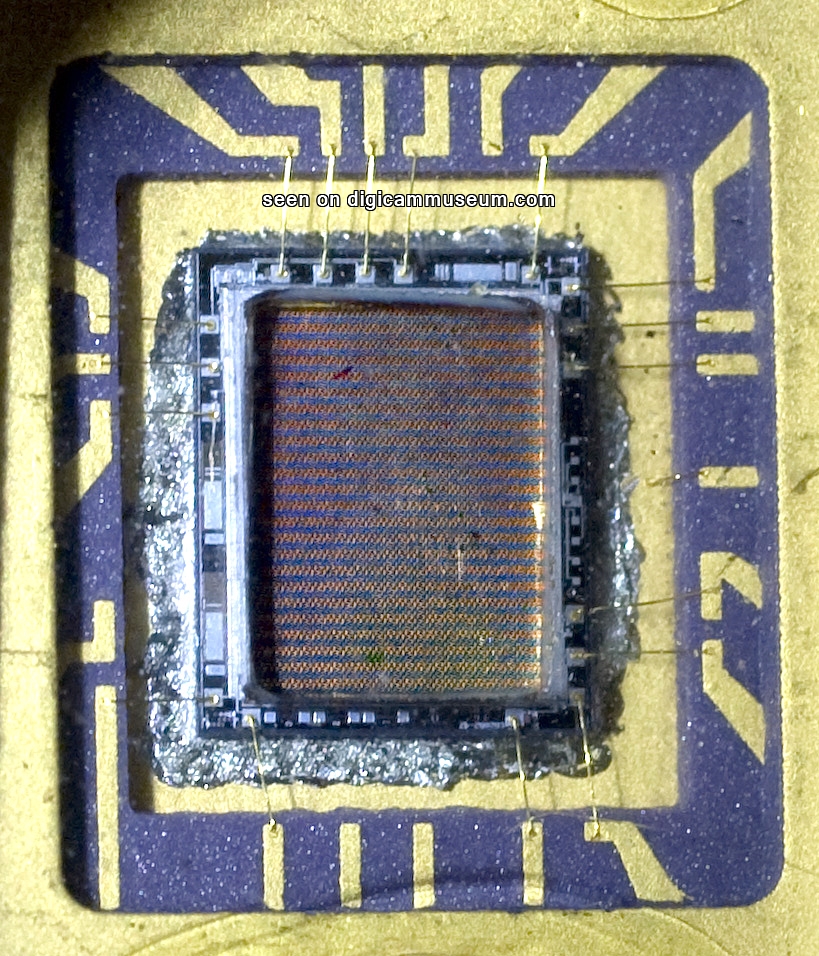
Fairchild 201CCD (© Eastman Museum) 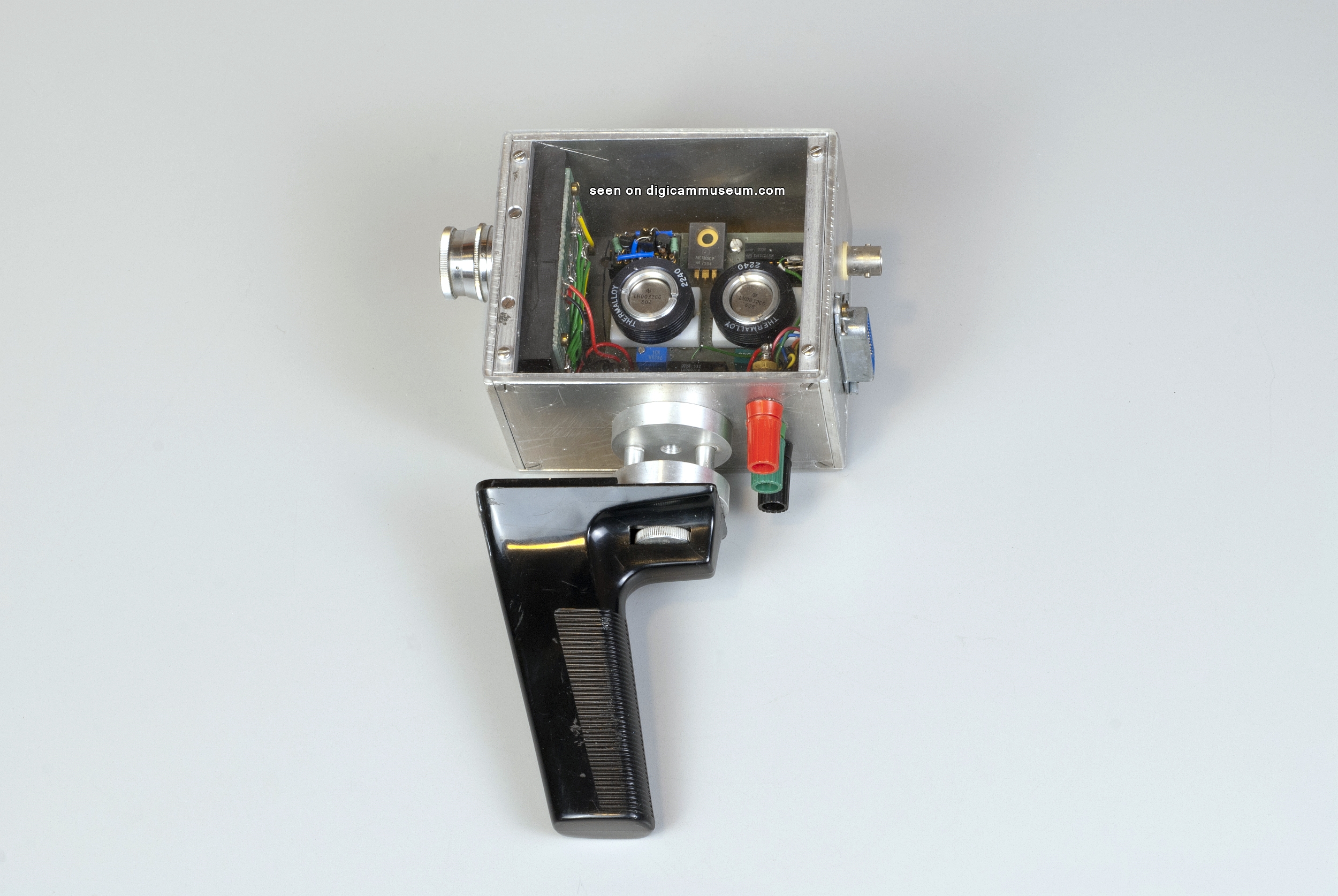
First Kodak CCD camera (© Eastman Museum) Some new information has come to light recently that I (and the rest of the world) was completely unaware of. We all believe that Steven Sasson was the first Kodak employee to create a CCD camera that resulted in the first digital camera prototype. Until now no one knew that he wasn't in fact the first one. In 1974, kodak engineer David Lewis, from the Kodak apparatus research lab, also tinkered with the famous Fairchild type 201CCD (100x100 pixel) and created the first Kodak CCD camera, even before Steven Sasson did. His CCD camera consisted of a custom built camera head with a super 8 movie camera grip and a c-mount lens. It's no wonder now that Kodak was tinkering with electronics because they were a major player with NASA and involved in many projects including the Lunar Orbiter (the one that mapped the surface of the moon) where Kodak designed and built the camera payload for this mission. They were also involved in some of the US military spy satellites and thus had a lot of interest in electronic imaging. To the left and right you can see some world exclusive shots of Kodak's first CCD camera ever from 1974 where the Fairchild CCD can be seen clearly (after all it was directly behind the lens).[60]
Experimenting with CCD's also leads me to Steven Sasson, an electrical engineer at Eastman Kodak Company. Sasson was hired by Kodak in 1973. Kodak's staff at that time mainly consisted of chemical and mechanical engineers, so the company started hiring EEs for developing electronic controls for cameras. In 1974, 24-year-old Sasson was approached by his superior, Gareth A. Lloyd, who offered him two choices. Either examining a movie camera's exposure control or investigating the new CCD. Sasson jumped at the CCD. The specific task was "could a camera be built using solid state electronics and solid state imagers?". Or in other words "check out the new 100- by 100-pixel CCD chip developed by Fairchild Semiconductor and see if it can be useful for Kodak." So Sasson contacted Fairchild Semiconductors and bought two CCD's. One spare CCD in case the other one could get destroyed in the process.
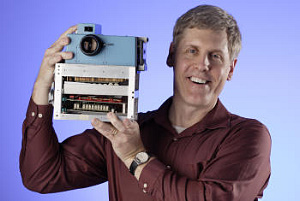
Steven Sasson (Photo courtesy S. Sasson)With almost no budget to spend and using an unused back laboratory for space, Sasson and a few colleagues were put to the task. He ordered two CCD's from Fairchild and cobbled together whatever he could find, even from the recycling bin in the video camera lab. Although the machine did not produce pictures all the time they were working on it, their only feedback was from oscilloscopes and voltmeters telling them that the circuits worked. Only if camera and playback unit worked together it would produce a picture. Sasson was supported in this task by fellow engineers Rick Osiecki, Bob Deyager and Jim Schueckler. Within a year the mission was accomplished and on December, 12th 1975 the first picture was recorded and produced. Note: the now famous shot of the "Boy and the Beagle" was not the first picture to be taken with the camera but it served as a good test picture. The first picture taken was that of a female lab assistant (Joy Marshall) after the voltage-variation tests were concluded. The picture that came out was a bit blurred on the facial part. So after reversing some wires the picture came out right. Sasson recalls the moment "You could see her head with the hair, she had long hair. And there was a white background. But her face was all distorted. It was static". "Well, Joy, who was standing behind us, was less than impressed. She said it needs work and left."

Image example of the Kodak Prototype
(Photo Kodak)After the picture was grabbed it took the machine about 50ms to digitize the picture and capture it in it's digital memory. For permanent storage the picture was recorded on to a digital cassette which was put in a digital tape recorder that was applied to the side of the camera and could be detached. Storing took 23 seconds. The image was viewed by removing the cassette from the camera and placing it in a custom playback device. Reading and portraying took another 23 seconds. This playback device incorporated a cassette reader and a specially built frame store. This custom frame store received the data from the tape, interpolated the 100 captured lines to 400 lines, and generated a standard NTSC video signal, which was then sent to a television set. The digital tape could contain 30 pictures. Not because of the storage capacity limits on the tape but because it was "a convenient number between 24 and 36" (number of pictures one could take on a regular film back then). Unfortunately the device is no longer operational as all components have reached end-of-life or stopped working. The batteries are also the first ones that were installed. No changes have been made to the prototype since it was built and demonstrated.
The Kodak Prototype was the only one ever built. Both the camera and the playback unit represented a first attempt at demonstrating an all-digital electronic capture and display system for still images with the consumer in mind. Sasson wrote a technical report about it and a patent was filed in 1976/1977. The camera was demonstrated to the Kodak management. They looked at it and said it was "cute". They asked him when the camera could be ready for market and Sasson replied in "15-20 years time". That being said the prototype did not get much more attention and was put it in a storage room. Sounds totally surprising now, but it wasn't back then since film and film cameras were Kodak's main business, developments in solid state imagers were after all a completely new field. Over the years the Prototype became "just an outdated piece of hardware" and it didn't get any attention in the 80's and 90's until Sasson was awarded the Kodak Innovation Award in 2001 and the prototype came back into focus through a newspaper article. Since then it is regarded as a holy grail! Hard to imagine that such an important device got locked up in storage rooms for over two decades and eventually got lost several times.[21][22][23][24]
Also the end some rumours and speculations. This was not the first digital (all solid-state electronics) camera ever built. It was the first portable one though. Also, the invention of the Kodak prototype did not automatically lead to the digital camera boom that took place in the nineties nor did it help Kodak build and market the DCS series. Kodak's DCS series arose from Jim McGarvey's tactical DSLR cameras.
1975 - Instant Electronic Camera
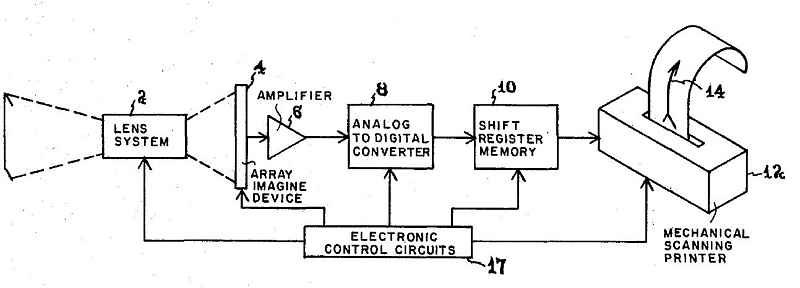
Jon S. Barrett's schematics for an instant electronic cameraNot many know this but Jon S. Barrett (founder of Dycam Inc.) filed a patent (US4074324) for an "instant electronic camera". It was granted in 1978. The idea was a sort of a digital Polaroid camera if you will. He described a digital camera that instead of storing images would directly print them on non-photographic paper. It contained all the classic elements, a CCD, an A/D converter, amplifiers, a shift register memory and as an output device a mechanical printer. He was years ahead of his time. With no chance to build it and no company to back his idea up it got shelved. Interesting enough King Jim Co. Ltd. of Japan picked up on the idea, invented and built the now sought-after DaVinci DV55 digital camera with built-in thermal printer.
1976 - Astronomy and NASA/Fairchild collaboration
The KH-11 reconnaissance satellite was launched by the National Reconnaissance Office. It was built by Lockheed in Sunnyvale, California and was the first american spy satellite to utilize electro-optical digital imaging allowing a real-time optical observation.[25] Data was transmitted through the U.S. military's Satellite Data System relay network. The initial ground station for the processing of the electro-optical imaging was a secret National Reconnaissance Office facility. It used a powerful 2.3-meter mirror, the theoretical ground resolution in good atmospheric conditions was approximately 0,16m. KH-11 was the first reconnaissance satellite equipped with charge-coupled device (CCD) array technology for imaging which had a resolution of 800 x 800 pixels.[26]
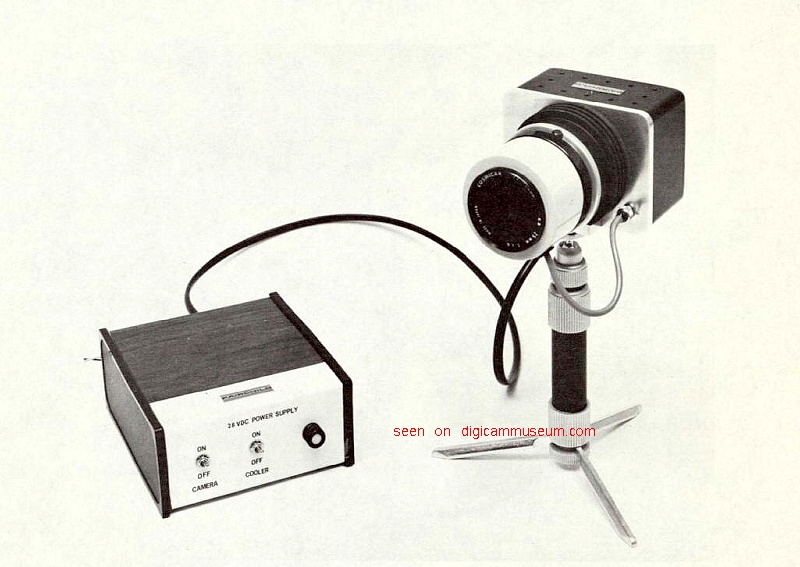
Fairchild/NASA Prototype camera (Photo Fairchild Corp.)NASA contracted Fairchild Imaging Systems in 1975 to develop, built and deliver a solid-state camera. For the prelimanary tests the MV-201 was used and modified. They used the CCAID-488 sensor and built a completely new solid-state camera that met all the required specifications in design and technology. The camera specifications were clearly described, the camera had to meet broadcast resolution, had to operate between 24 and 32 Volts. The camera had to be equipped with external controls that had to be easily accessible and labeled clearly to allow ease of reading and operation. It was designed for C-mount television lenses. The camera was to be used for space environment conditions. Sensor temperature control was achieved by integrating a heatsink and the ccd into a hermetically sealed enclosure. Fairchild delivered a prototype (s/n 001!) which was thoroughly tested. Although the camera completely met the requirments, improvements were already contemplated for future cameras. Miniaturization of components and the need for lesser power consumption was already recognized by Fairchild and in development.[27]
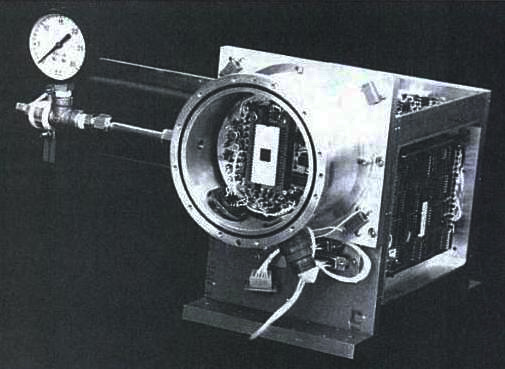
Travelling CCD camera (Photo J. Janesick)
Also in April and May of 1976 in another part of America, Fred Landauer, Larry Hovland, James Janesick of JPL and Bradford A. Smith of the University of Arizona went to Mount Lemmon's 154-cm telescope with a CCD camera system to capture the first hi-res images of various astronomical objects (known as the JPL camera). The detector was a Texas Instruments 400x400 CCD incorporated into a breadboard camera, designed and fabricated by NASA's JPL.
Here they took the first CCD image of the planet Uranus. During the operating time, the CCD was cooled to 210 degrees Kelvin by a regulated flow of cold gas from a liquid-nitrogen Dewar. The camera system contained a 10-bit A/D converter and images were recorded. A little later an upgraded version of the JPL camera made visits to different major observatories where it took spectacular images. JPL's "travelling CCD camera system" was the first of it's kind to be used at major observatories.[28]
1977 - CASI and ASI
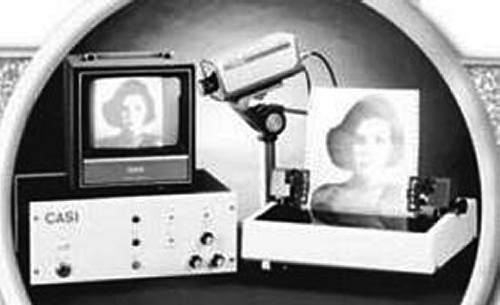
First CASI system (Photo CASI)In 1976 Ken Kendes and his father Sam Kendes saw a Computer Portrait System in a shopping window on Broadway that would take a picture and print it out in crude computer symbols. People were actually lining up outside and waiting to pay $3.00 for $0.10 worth of paper! They felt it was the right idea to start a business with and bought two of those systems. It was like Polaroid but with a computer instead. During the christmas seasons of '76 they tested the systems in two different malls and scored big time. That led them to set up an office in 1977 and develop the CASI Computer Portrait System (CASI = Creative Amusement Services, Inc.). It was the idea of applying computer technology to the gift industry by producing a digital picture where you could put a name on and then transfer it onto a T-shirt or poster. The first CASI system (Apollo VP2 S100) used a still-video camera (Panasonic security camera) with a detachable zoom lens which produced b/w pictures. The system had 8 kilobytes of SRAM and cost about $25,000. Allegedly only about 300 units were sold. It captured a still image from a motion stream and printed it on paper with a customized message. The analog images were not stored but processed directly. The first system beared the name "Apollo" because the same engineers who worked for NASA on the Apollo space mission imaging systems helped in creating the first CASI system.[29][30][30a]
The ASI (All-Sky Imager) Science Team of the University of Calgary constructed the world's first all-sky digital monitoring system in 1977. Not in 1981 as mentioned anywhere else on the internet. The All-Sky Photometer. All-sky cameras had been around since the 1950's on the southpole for example, but up till then they were film cameras. As far as I know the All-Sky Imager used in Calgary was built by Stephen K. Babey.
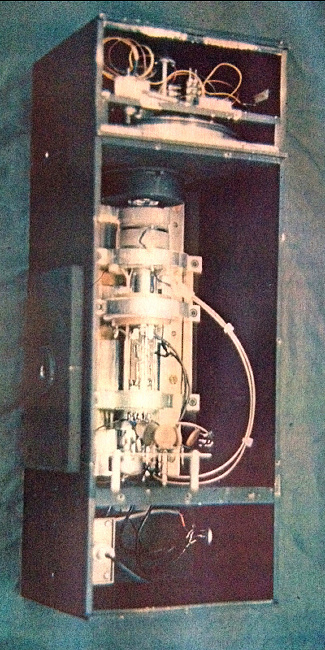
Inside of the ASP
(Photo provided by S. Babey)The image sensor of the ASP was an "ITT F4012 magnetically focused and deflected Image Dissector camera tube". In order to provide maximum flexibility the optical system was designed as a set of compatible modules. A 16mm Bolex lens acted as the master lens to focus the desired image on the photocathode of the Image Dissector. Scanning of the electron image at the photocathode was accomplished by means of deflection voltages applied to scan coils surrounding the drift tube of the Image Dissector. The scan coils were driven by digital-to-analog converters (DAC's) connected to the controlling minicomputer. (a Zilog MCz1/25 Microcomputer)
By sequentially stepping the DAC coordinated and remaining at each point for a fixed dwell time, a composite digital 'picture' was constructed in the computer memory and displayed on a storage oscilloscope. For permanent recording and analysis, the data was stored on nine-track magnetic tapes. As the ASP produced data directly in digital form, reduction operations, accumulation of scans and conversion into standard photometric units were considerably simplified. The ASP was designed so that it could be easily reconfigured to operate remotely and unattended, with a communication link provided by a telephone line. Stephen also prognosed that if another ASP was installed elsewhere, the two units could work together in a master-slave relationship and suggested in his thesis that the image dissector could be replaced with solid-state imagers in future models.[31a]
To my knowledge such a system was ready and operable in 1986. It used the Fairchild CCD202 image sensor with 100x100 pixels.[31b] One must know that especially in the field of astrophysics there were a lot of CCD cameras built between 1978 and 1982. The majority used the Fairchild CCD202 image sensor. Too much to mention here in detail.
1977 - Fairchilds night vision camera
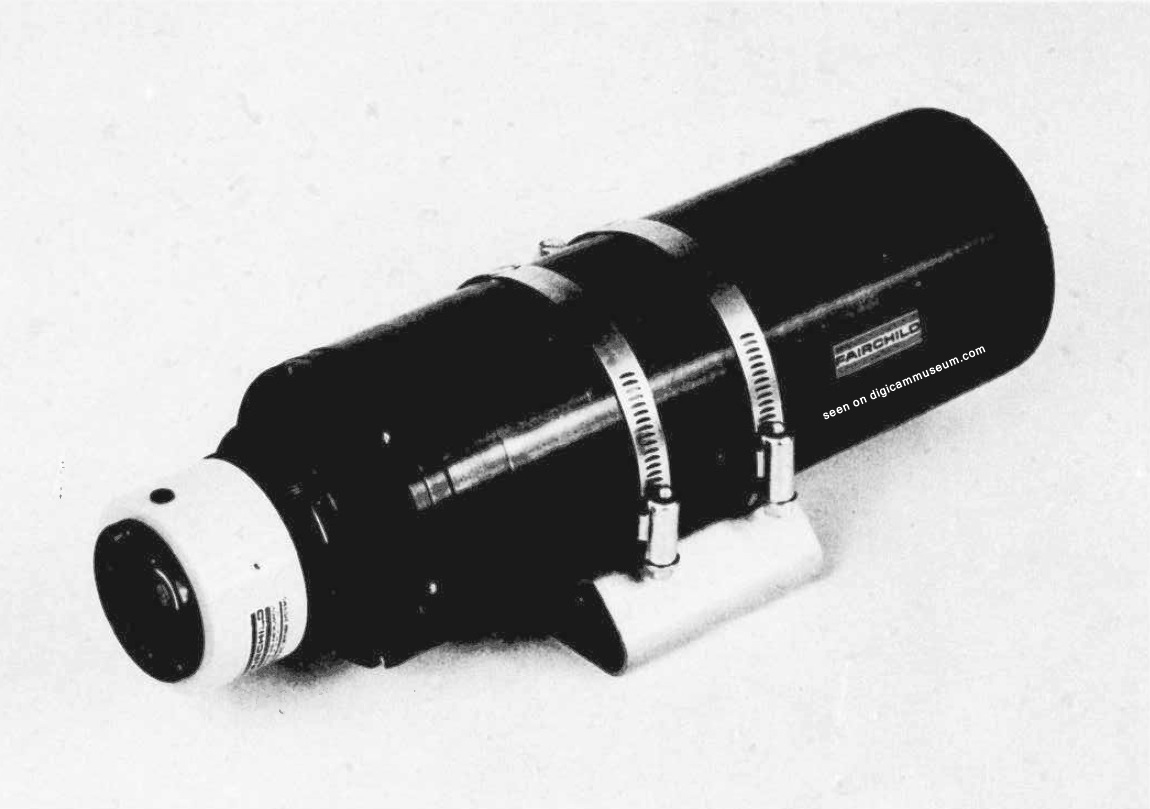
First CCD Night Vision Camera (Photo Fairchild)In 1977 Fairchild Imaging Systems ran some experiments with the Fairchild CCD-488 sensor to create the world's first solid-state CCD night vision camera. The task was to create a day/night imager to be used in a remotely piloted vehicle (RPV) for the US Army. This newly developed camera was to replace the Phase IV daylight Vidicon imager then used in the Aquila RPV program. The solid-state system consisted of a high performance image intensifier coupled by fiber optics to the Fairchild CCD-488 image sensor. The sensor itself was being used primarily in low-light level TV cameras. Work on this project started in early January of 1977 and a feasible result was delivered Fall 1977. The results were better than expected according to Fairchild. The camera prototype contained the afore mentioned CCD, a breadboard, four circuit boards and a 25mm GEN II image intensifier mounted in a modified Starlight Scope housing. The optics they used for testing was a Soligor 25mm F0.95 C-mount lens. Here's a fun fact, the circuits were derived from a basic design originally developed for a Missile Guidance Camera! The circuits were modified to implement automatic light control, video level clamping, automatic and manual gain control. Shutter speed was either 1/60s or 1/30s. An interface was implemented to work with a data processor developed earlier for another US Army contract. The ouput was analog as there was no AD converter on the boards. The final camera design featured a 50mm F1.8 auto-iris C-mount lens. The size was 4 inches wide and 11.5 inches long and weighted 7 lbs. Voltage for operation was between 24V and 32V. [59]
1979 - Patent conflicts and underwater stories
One of the very first instances of electronic imaging that would stir discussions about the future of photography was Emory Kristof's use of an electronic camera to photograph underwater life for National Geographic in a miniature submarine called Alvin. It was a solid-state TV camera from RCA and was mounted on a mechanical arm outside of the minisub. Simply because tubed TV cameras were too big to fit into the minisub, that was already packed with electronics. His endeavours paid off and the result was an emmy winning TV documentary.[32][33a][33b]

Campbell's Electronic Still Camera PrototypeSomething else happened in 1979 that is quite bizarr and definitely worth mentioning. Malcolm Gregory (Gene) Campbell from New Zealand invented and patented an electronic stills camera. His vision though was not only to make the camera smaller in the near future, maybe the size of a calculator with a "pop-up chip" as memory storage, but also to equip the camera with a built-in screen (diode matrix) to review the images taken. The photographer could review and instantly delete unwanted pictures and re-use the freed-up memory for other pictures. He suggested bubble memory could do the job. At the time the patent was filed he already had a prototype under construction, the size of a suitcase utilizing a RCA TC1160 solid-state TV camera and other off-the-shelf components to capture, process and store 256x256 pixel gray-scale images on a bubble memory cassette.
When he found out that the technology for his ideas was available, he took out patents. In 1980 he went to Japan and approached Toshiba, Sony, Hitachi and National to build him a prototype. None of the companies showed interested or suggested that they would enter the eletronic still camera business any time soon. So he went back empty-handed and commissioned the New Zealand Department of Scientific and Industrial Research to prove his theories. He wanted fast results since none of the major companies seemed interested. In 1981, eight months after his trip to Japan, he received a letter from Sony. They enclosed full details of a Mavica prototype and asked Campbell to compare them with his patents.[34a] It is not known to me whether there were any legal negotiations once his patents were published in Japan nor the consequences it had for the Mavica not going on sale.[34b]
1980 - first commercial color CCD camera
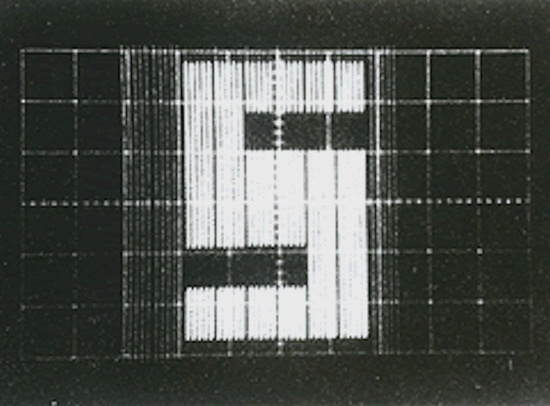
A 64 px CCD projection of the letter "S"
in 1972 (Photo Sony)We learned that in 1970 Bell Labs announced their invention of the CCD. At the same time over in Japan at Sony's Research Center there was an engineer by the name of Shigeyuki Ochi. A fellow engineer showed him a magazine one day with the original Boyle and Smith report. Ochi's initial response to the article was that the CCD had a very simple structure and he added the development of the CCD to his list of projects related to the development of MOS devices. This was in December of 1970. Depending on the voltage applied, an electric signal is transferred in a CCD and the two ends of the CCD act as the entrance and exit for the signal. Thus, a CCD can be used as a delay unit in signal transmission. Ochi, idly playing with a CCD, noted, "If you input an electric signal at this end, it's transferred and emerges through the other end." Moreover, he discovered that when a CCD is used as a photo-sensor, it converts the received light signals into electric signals. In other words, it performs as an optical signal reader. Thus, a CCD connected to a lens can act as an "electronic eye."
Ochi thought that if it can be commercialized, Sony would be able to make inexpensive cameras. He went on to develop several prototypes, the first of which was a CCD that captured an 8 pixel image. For an 8 pixel image, eight sets of photo detectors and transmitters receive light signals and converted them to electric signals. He then succeeded in 1972 to project the letter "S" with an 8 x 8 (or 64 pixel) CCD. By the time of his invention, Bell Laboratories had given up on commercializing the CCD.
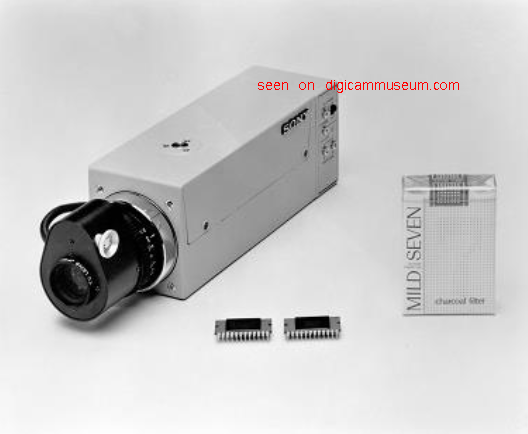
World's first color CCD camera XC-1 (Photo Sony)The picture of course was soft and fuzzy but Ochi had a strong supporter in Iwama, then deputy president. Ochi and his group were still merely playing with the CCD, but Iwama ordered them to, "seriously focus on the CCD and turn their R&D efforts into a usable product." Thereafter, the development of the CCD became a full-time project. Iwama gave the team a specific goal: "We have to produce a camera using CCD's at a price of under 50,000 yen within five years. We're not competing against other electronics manufacturers in this field. Our competition is Eastman Kodak." This being said the CCD experiments went on over the years and they increased the number of pixels from 2,000 to 8,000 and to 70,000. Eventually in 1978, they were able to increase the number to 120,000. In it's quest to produce high quality crystals, Sony invented the MCZ crystallization method. As a result, the problem of dust contamination in the pixels was overcome. Dust from people, machines and other origins were removed and countered. Finally, a perfect, clear image was achieved. Test manufacturing of the 120,000 pixel CCD's began that same year, and in 1979 the new CCD was commercialized as the "ICX008." Total investment until that date amounted to 20 billion yen.
Following tests for mass production, a prototype CCD camera production line was established in Atsugi in November 1978. Finally in January 1980, six years and three months after Iwama first gave orders to begin work on the CCD; the world's first color CCD camera was produced. The XC-1. It was mounted to an All Nippon Airways (ANA) jumbo jet and used to project images from the cockpit at departure and landing times into the cabins, acting as the "eye" of ANA's Sky Vision system.[35]
1980 - kodak at hi-speed
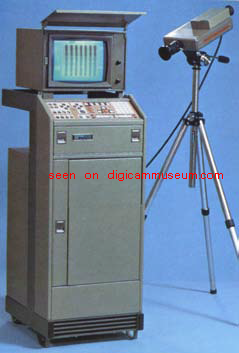
Kodak SP-2000 (Photo EKC)John Bagby of Spin Physics (a company acquired by Kodak in 1973), developed and built a Motion Analysis System to analyze fast-moving objects that could later be reviewed at a slower speed. Intended for various applications like sports, safety and engineering. It was dubbed Kodak SP-2000 Motion Analysis System. It used a very fast CCD, high-speed electronics and advanced tape-recording technology to perform high-speed video recording at rates of up to 2,000 frames per second. This enabled powerful slow-motion analysis for both industrial and scientific applications.[58]
1981 - Mavica mystery
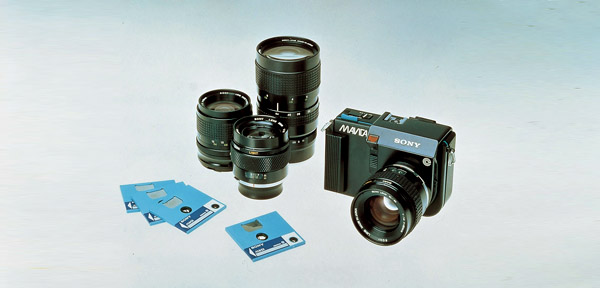
First Sony Mavica (Photo Sony)At this point the era of the Electronic Still Video Cameras began with the announcement of the Sony MAVICA in 1981 and died around 1992 with the last of the Canon ION and the Sony ProMAVICA series. For that period this was the first time that regular consumers could buy electronic still cameras which enabled them to download pictures onto a computer or watch them on a television set. They were completely analog devices but an important step towards digital cameras because they proved that a filmless CCD camera could be build similar in size to a regular film camera.
But the magnetic video discs were never really a substitute for the far superior films which became better and better in quality over the years. Between 1981 and 1994 some 50+ still video cameras were announced, built and/or marketed. Their story is widely covered for example in Understanding Electronic Photography by John Larish. You can see what SVC's were marketed or demonstrated in the SVC section in the main menu.
A little sidenote: electronic still video cameras (ESVC) are often confused and/or mixed-up with digital cameras which is not correct. ESVC's do not have a built-in A/D converter and the images are stored in analog form on a magnetic video floppy disc. Those images need to be digitized on a computer with a frame grabber or video card in order to produce a true digital picture.
As we know now Sony never marketed the Mavica because they weren't quite satisfied with the resolution and picture quality. Nonetheless, Japanese newspaper Asahi Shimbun heavily field-tested the camera and it was often shown and demonstrated to both public and press. Also (and almost NOBODY knows this!) the term "MaViCa" (which now stands for "Magnetic Video Camera") was not especially coined for this 1981 prototype as many believe. The term itself dates back to the year 1974, where it stood for "Magnetic Video Card" and was invented for a prototype videoplayer that could record and play images from "magnetic cards". The Nikkei Sangyo Shimbun newspaper and Popular Science magazine wrote an article about it in may and august of 1974.[35a]
1982 - patents galore!
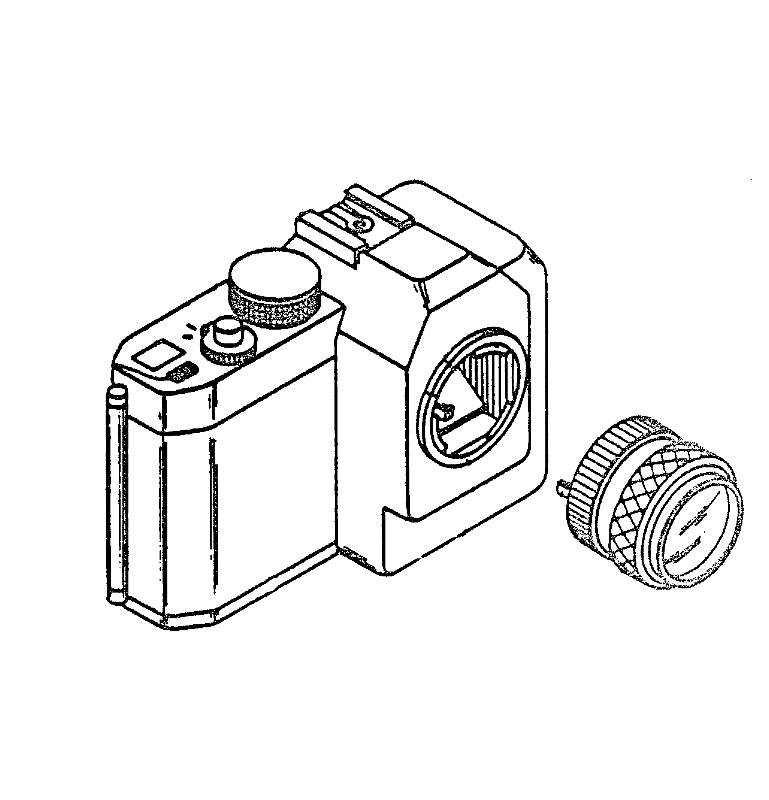
Nikon Patent (© Nikon Corp.) 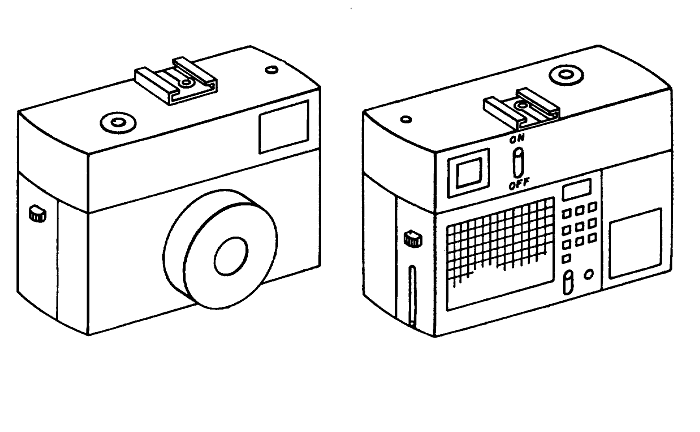
Nikon Patent (© Nikon Corp.) The eighties held a few surprising moments, foremost the Sony Mavica revelation in 1981, then Canon headlining the still video camera race later in 1984 and their commercial success in 1986. These ware alas all novelties and inventions that were actually built, demonstrated and sometimes even marketed. When you take a look at the ESVC section you can find a full list of all still video cameras (or electronic solid-state cameras) ever built. Is that all you may ask, well the answer is no. Numerous patents were filed in the outgoing seventies and eighties and all of them wanted a piece of the solid-state pie. Most interesting is Nikon's patent for a still video camera with a detachable monitor! Here is an overview of some of the patents that never turned into a feasible product.
1978 Polaroid - Electronic Imaging Camera (US4262301 A)
1980 Nikon - Electronic photographic camera (US4420773 A and US4456931 A)
1981 Stephane M. d'Alayer de Costemore d'Arc - Electronic still camera (US4489351 A)
1982 Olympus - Electronic still camera for generating long time exposure (US4614966 A)
1982 Nikon - Electronic picture camera (US4758883 A)
1982 Nikon - Multi-motor electronic still camera having a recording disk (US4896226 A)
1983 Polaroid - Electronic imaging camera (US4541010 A)
1985 Polaroid - Electronic imaging camera for recording either moving or still images (US4691253 A)
1988 Fuji Photo Film - Electronic still camera capable of selecting recording media (US 5067029 A)
1989 Polaroid - Electronic camera system with detachable printer (US4937676 A)
1983 - MegaVision
From 1983 CCD technology was widely employed for telescopes and replaced the previously used photographic plates. The telescopes fitted with CCD at that time allowed observations and studying objects and recording in seconds what would previously take hours.
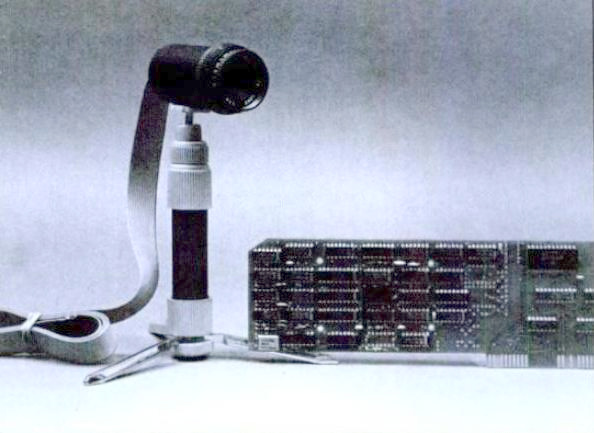
Micro D-Cam (Photo The Micromint)1983 was also the year the first inexpensive sort-of digital camera appeared on the market. The Micro D-Cam by The Micromint was a digitizing camera or digital image camera that could capture images directly onto a PC screen. Books and magazines often refer to it as digital camera. Instead of a CCD or CMOS it used an optically sensitive RAM with a resolution of 256x128 pixels. It came complete with lens, cables, software and interface card. One could either buy a tested pre-built version for $299 or $264 for a DIY-kit. It was available for IBM PC, Apple II and could be special ordered with a RS-232C connector. Gray-scale images were recorded into RAM memory. Around that time another company Datacopy also produced digitizer cameras but these ones had higher resolutions and were aimed at professionals or companies since their price easily went into thousands of dollars. Over the next four years more and more of this digitizing cameras with optical RAM's surfaced on the market, for example the MicronEye and the Idetix Digital Camera. All consumer-friendly and low-budget ($400-$700).[36a]
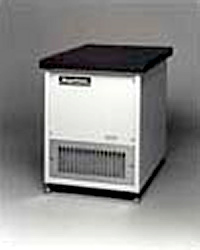
1024XM Computer
(Photo MegaVision)MegaVision goes into business and notices that in order to produce high resolution digital images one would either need a super computer or a specialized computer specifically designed for processing pictures. So they built their first product, the 1024XM image processor in 1983. A sort of array processor slaved to a much slower computer host. It had 32MB of real-time memory and a 350mb/s processing speed. Remarkably fast for it's time. According to MegaVision it "offered both speed and image manipulation capabilities not effectively surpassed by any computer other than supercomputers and mainframes until 1997". They started selling the 1024XM in 1984 to companies such as Kodak, Westinghouse, Intel and Texas Instruments to aid in the development and testing of their digital imaging sensors.
1984 - Canon shoots the Olympics
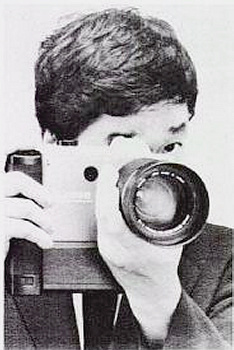
Canon D413 Prototype
(© Popular Photography Magazine)Since Sony still wasn't going to market the original Mavica, Canon jumped in. Waiting in the wings, Canon already had a task force working on an electronic camera since 1981. Ten months before the '84 Summer Olympics in Los Angeles, japanese newspaper Yomiuri Shimbun asked Canon to participate in image transmission experiments. After initial field tests, trainings and preparations, 5 months had passed. Still Canon did not have a transmitter or recorder. These had to be designed, built and tested within the remaining 5 months. After everything was completed and finished, Mr. Masaya Maeda, now Managing Director and CEO of Image Communications, and others went to Los Angeles with the electronic still video camera (after all Canon was the official camera of the Olympic Games). The prototype series codename was D413.[36b]
For broadcasting the images a car telephone was attached to the transmitter. This worked well until the broadcast of the men's marathon when the phone failed to work. The engineers quickly had to switch to a public line in order to continue broadcasting. According to Mr. Maeda some 50 color electronic files were transmitted back to Japan. Mr. Kazuro Yamamoto, Chief of the 'Yomiuri' press group, claimed that it took 6 minutes for b&w stills and 24 minutes for color pictures. A few hours later the images were received, reviewed and printed. Not many know that Sony too was shooting the Olympics with an improved version of the Mavica! The generel claim Canon used the RC-701 for the Olympics is simply wrong as it was the D413 prototype. The experiences made, inspired Canon to continue development towards a commcercial product.
Canon's success led to the further development of the RC-701 which was later publically announced in 1986 at the Photokina and advertised as the Canon SVS which stands for 'Canon Still Video System'. But Canon wasn't by far the only company that dabbled in the new still camera market. The Photokina was always a playground for all major companies to show-off their novelties and prototypes. But in 1984 it weren't just film cameras, oh no no, for the first time electronic still cameras were shown. Not all of them were actually demonstrated or shown to the public. Some were just 'feasible' products, others only shown in private. Panasonic showed an electronic SVC, Copal had a Video Floppy Camera named CV-1 and Hitachi had a nameless prototype on display. The Copal now is among the rarest of them all since they had no intentions of ever releasing a still camera under their own brand name. Sony, who sparked the electronic still camera hype, failed to introduce the long anticipated Mavica.
1984 - DRAM experiments and First Still video device
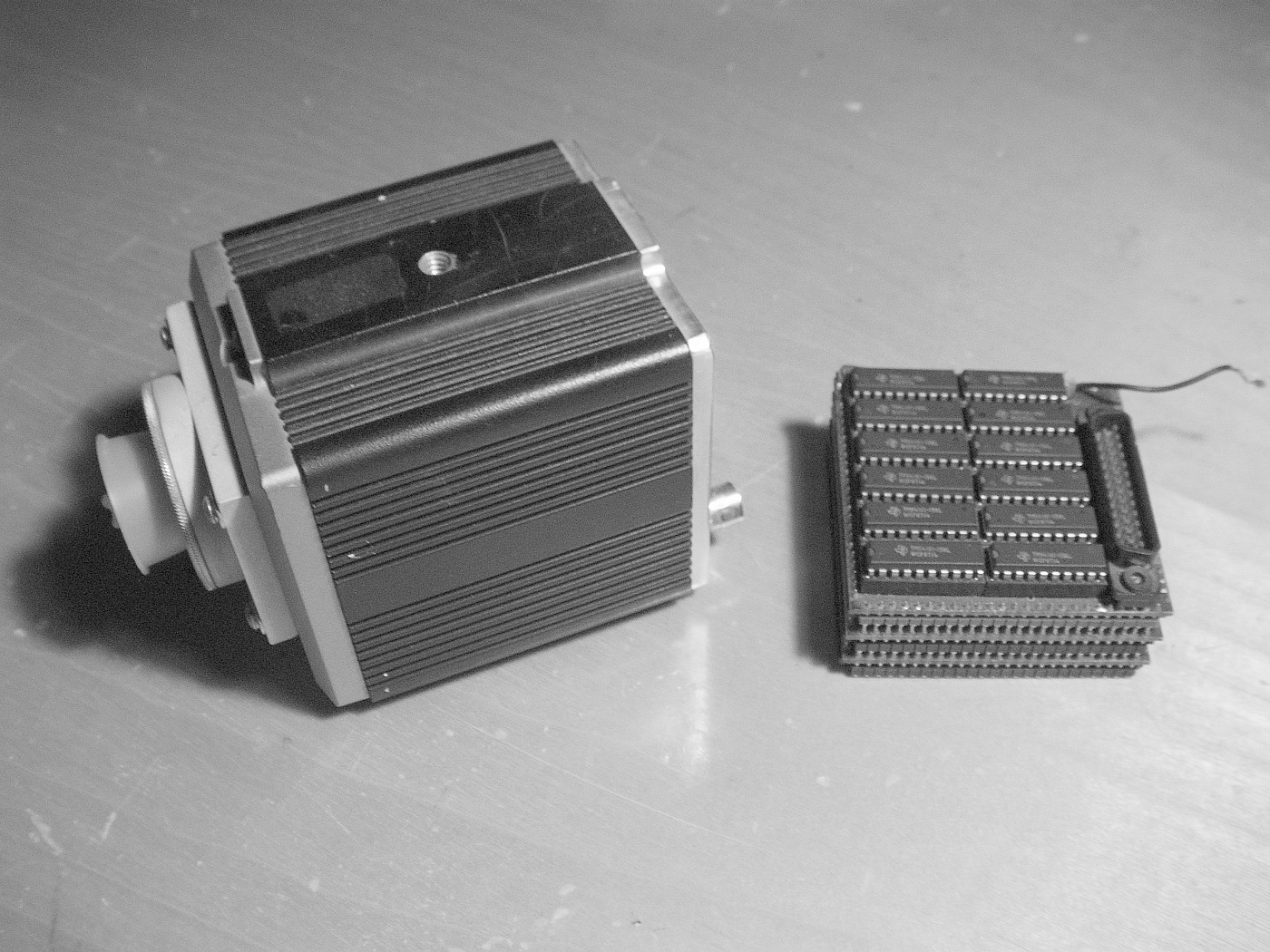
Poynting Products FS-2505
(© Michael Belanger)In 1978 a company was founded called Poynting Products Inc. (PPI), to supply RS-170 Video Scan Converters for the then popular General Electric TN2200 camera with 128x128 resolution. That scan device provided a real time video signal which supported the set-up and operation of the camera. It also helped GE demonstrate the quality of that camera, which increased their sales. PPI subsequently developed a close relationship with GE, introduced a series of support products and became a vendor for their cameras. When GE introduced the TN2505 camera which employed a 388x248 pixel sensor and generated standard RS-170 video, PPI built video freeze frame and computer interfaces to support it. Given the nature of the CID sensor used in that camera, it was excellent for strobe illuminated videography.
In order to support that application, PPI combined the TN2505 camera and an 8 bit digital video frame memory in an extended TN2505 housing. They marketed this camera as the FS-2505 (Frame Store 2505) and sold these to printing and mailing firms for strobe illuminated image acquisition of their rapidly moving products. The price at that time was $4,000. The FS-2505 may therefore be the first commercially marketed, solid-state camera with built in memory. The video output was continuously generated from the digital memory and freeze frame capability was provided by disabling writes to the digital memory. The CID Camera had the unique ability to acquire images from an asynchronously illuminated source, like a strobe illuminated production line. PPI's memory was made from a three board stack of control, memory, and video A/D and D/A. They were very dependent on GE and nearly crashed when GE went through a period of not being able to produce video sensor chips. They finally tracked it down to a hair spray used by a worker in the production area![52][53]
The next thing to happen in 1984 was that Fujifilm brought the first still video product to market. The Fujix TV Photo Player P3 was the first still video device that could actually be bought. Even before a still video camera was marketed. Is there a "why" coming up in your thoughts? If so, the answer is simple. Video Floppy Disks were already in use by then. As I have explained elsewhere, VF disks were used in broadcasting and similar fields. For the regular consumer things were not so easy. Fuji's concept was that a regular consumer would shoot pictures with a regular 35mm camera then bring the film to a Fuji lab. There the film was developed but instead of being printed on paper the pictures were scanned by a video camera and recorded onto a VF disk. Pretty neat. It went for sale in Japan in 1984 for a pretty decent sum of around $210. Apparently different sets were released, some contained just the player while other sets included a cable remote control
1985 - kodak's still video efforts
Little is known about Kodak's efforts in the field of Still Video. It's true they never marketed a feasible still video camera but therefore still video equipment. So here is a heads up on Kodak's efforts in the still video market. It all starts in 1981 of course when Sony announced their Mavica prototype. This was a wake-up call for all major camera manufacturers at the time. Although the camera was not marketed, it certainly rocked the camera industry. Kodak's Consumer Product Development group at Elmgrove Plant started working on electronic imaging products in response to Sony's Mavica announcement. These first efforts circled around still video and motion video images. Kodak eventually teamed up with Panasonic for the 8mm video project.
In 1984 Kodak executive Colby Chandler formed 17 separate business units to move more quickly ahead. By 1985 the top management acknowledged that attempts should be made towards the combination of film and electronic imaging. The first unit in this field that came out was the so-called Color Video Imager (aka Trimprinter). It could capture a video frame image from a video signal and make an instant print on Kodak's own Trimprint instant film (the same film used in Kodak instant cameras). Alas the project was canned after Kodak lost the lawsuit against Polaroid. Kodak's Consumer Electronics Division (CED) was reshaped into the Electronic Photography Division (EPD), run by Dr. K. Bradley Paxton. It was in late 1985 when Tom Nutting and Keith Surdyke developed the first electronic still video camera prototype. Now known as the Kodak SV8300. The camera came with a shoulder backpack that housed the 3" magnetic video disk recording unit. At that time Kodak was working on their own 3.5" floppy disk for recording before they switched to the standard 2" video floppy disk. Dr. Paxton himself took the system in early 1986 on to the top levels of the Kodak Tower to take snapshots of some executives.
Also in 1986 Kodak developed the first megapixel sensor (see below). A 1.4 million pixel imager. The number 1.4 was a simple choice, in order to produce a borderless 5 by 7 inch print with a 200 pixel-per-inch thermal printer, one needed a 1.4 million pixel image (5x200x7x200). Kodak was eagerly working on a so-called Magnetic Disk Video System (MDVS) which was to capture images with either traditional film cameras or electronic cameras on a video floppy disk and display the images either on a television set or on a printer. MDVS was later re-named to Still Video System (SVS) as Kodak began approaching the still video market. By fall of 1986 Kodak had an entire plan worked out of up to 9 different products all working together in creating electronic images or printouts and/or transmitting them over a phone line. It was a complete setup. The system was announced to the world in June 1987. So Kodak went on to improve the still video camera and built six prototypes of the SV8300 to demonstrate their SVS product line in 1987. Apart from a one-time prototype (SV8200) this SV8300 model was actually one that could have made it into a commercial product. Kodak finally entered the market with several still video products like the SV6500 color video printer and the SV7400 still video recorder and Kodak's first all-digital product, the SV9600 still video transceiver among others.
A major problem with the SV8300 however was the signal-to-noise ratio (SNR). Secondly there were video motion cameras available that could deliver images into the Kodak SVS system. Thirdly, Kodak's top management was always more interested in analog cameras and were not too eager to see Kodak branded electronic cameras pop up on the market as they feared it would hasten the demise of their bread-winning film. These three major issued were the reasons why Kodak didn't enter the market with a still video camera in the 1980's. Not because "they had no idea" but because of quality reasons and management decisions..[58]
1986 - rise of still video and megapixel cameras
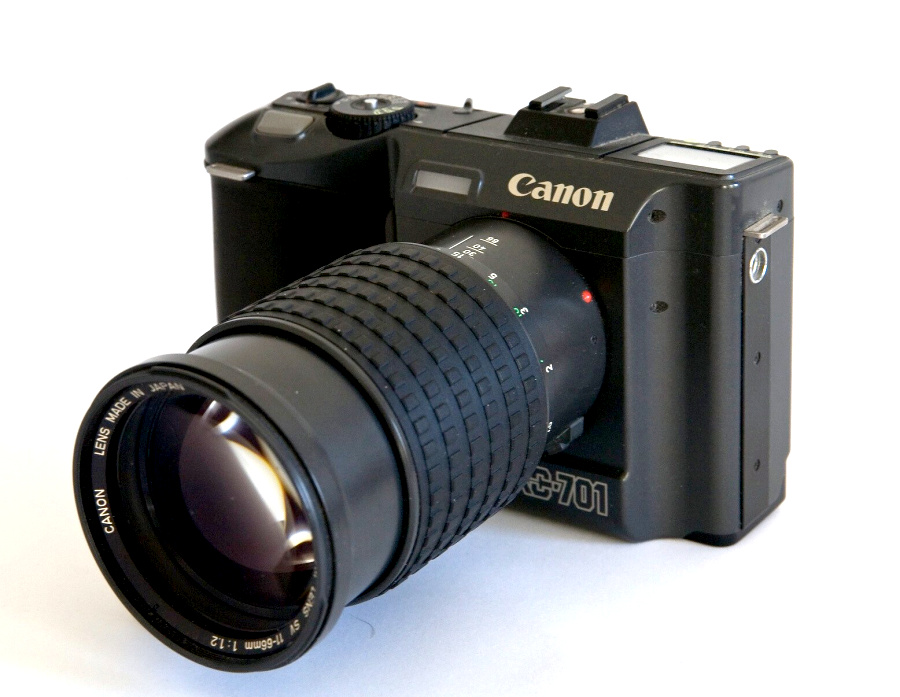
Canon RC-701 (© David Williams)Finally, after the success in the 1984 transmission experiments, Canon finally marketed the RC-701. The first commercially available electronic still camera. The RC-701 'Realtime Camera' was equipped with a 390,000 pixel CCD from Texas Instruments and came with a wide range of accessoires. Apart from four dedicated lenses one could also use 60 regular Canon FD lenses by utilizing an adapter. The entire system consisted of a SV recorder, SV transmitter, SV camera, system lenses and a color video printer that would not only print the images but also laminate them to sharpen the clarity and preserve the dyes. Although the camera body was sold for $2,725 it was aimed at newspapers, magazines or wire services because the equipment was very expensive. The lenses went for $700-800 a piece, the printer for $7,000, the recorder for $2,800 and the transmitter for a pricy $20,000. Transmission of a b&w image would take ninety seconds, color three minutes under good conditions. Therefore one had a highly sophisticated piece of equipment. Shooting speeds ranged from single frame to ten frames per second! You could hook up the printer to either the recorder or the transmitter and print away. Since it took the printer three to four minutes to print an image there was still enough time left for a coffee break..
Others were soon to follow, Sony finally marketed their first Mavica, the MVC-A7AF and Nikon showed a Panasonic-built SVC. Kodak was eagerly working on Still Video equipment too.
MegaVision designed their own 1000-line camera in 1984 to more easily transfer images into the 1024XM image processor. It was a bulky scanline, vidicon tube camera called MV 1024XS. It had 1024x1024 pixel resolution and was designed for (but not limited to) repeatable measurement of intensity and geometry. Color reproduction was possible when RGB color filters were used. The camera itself consisted of the camera head and a power supply. It had a standard C-mount so that a variety of lenses could be used. It was made available with a Precision 1 inch vidicon tube and retailed for around $6,200. For $1,400 more it came equipped with a medical grade Newvicon tube. Slides, bellows and 25mm lens were available for another $1,000. It was designed for the 1024XM image processor but could also be hooked up to any other high speed processor.[37a]
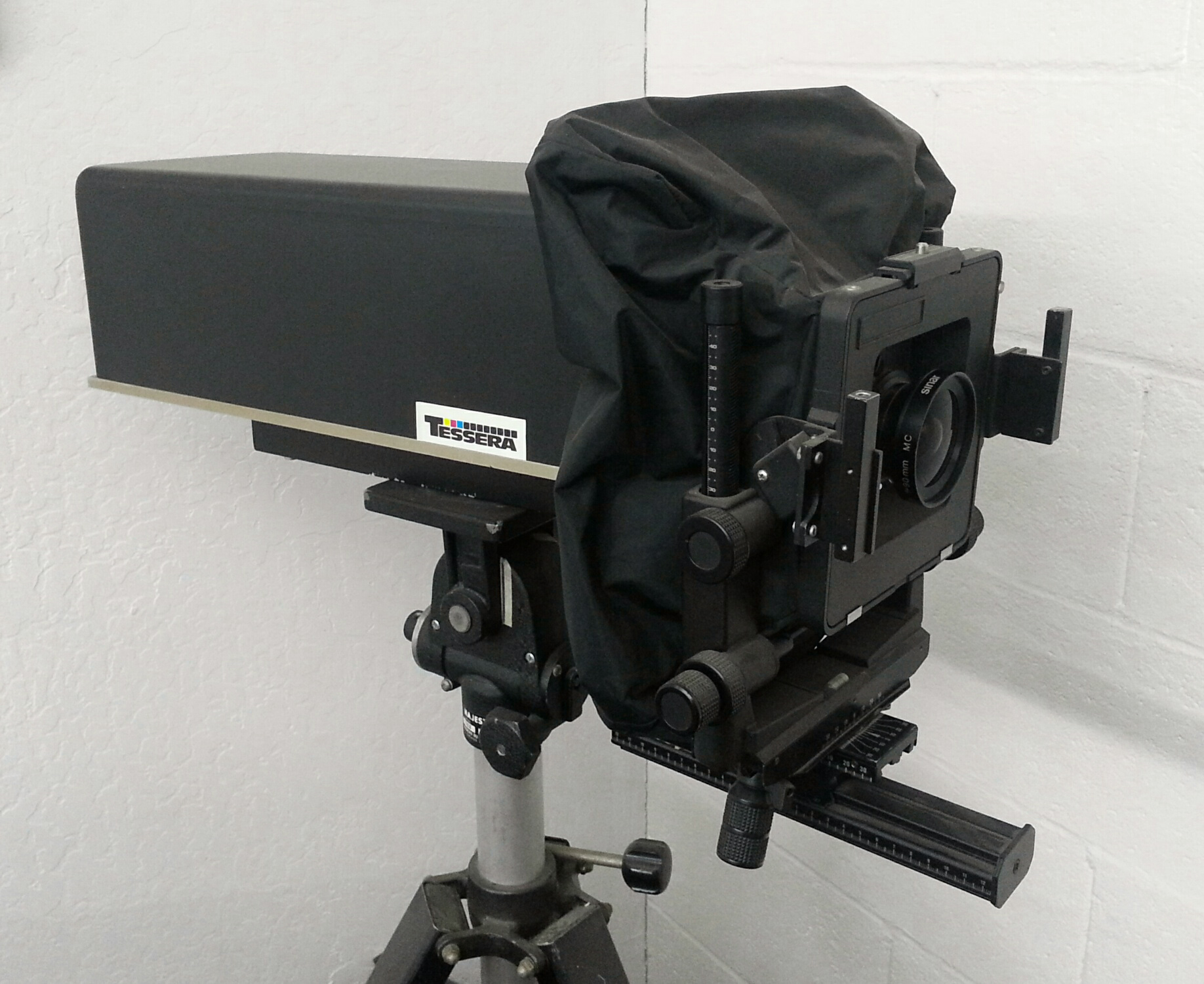
MegaVision Tessera
(Photo Courtesy of MegaVision)
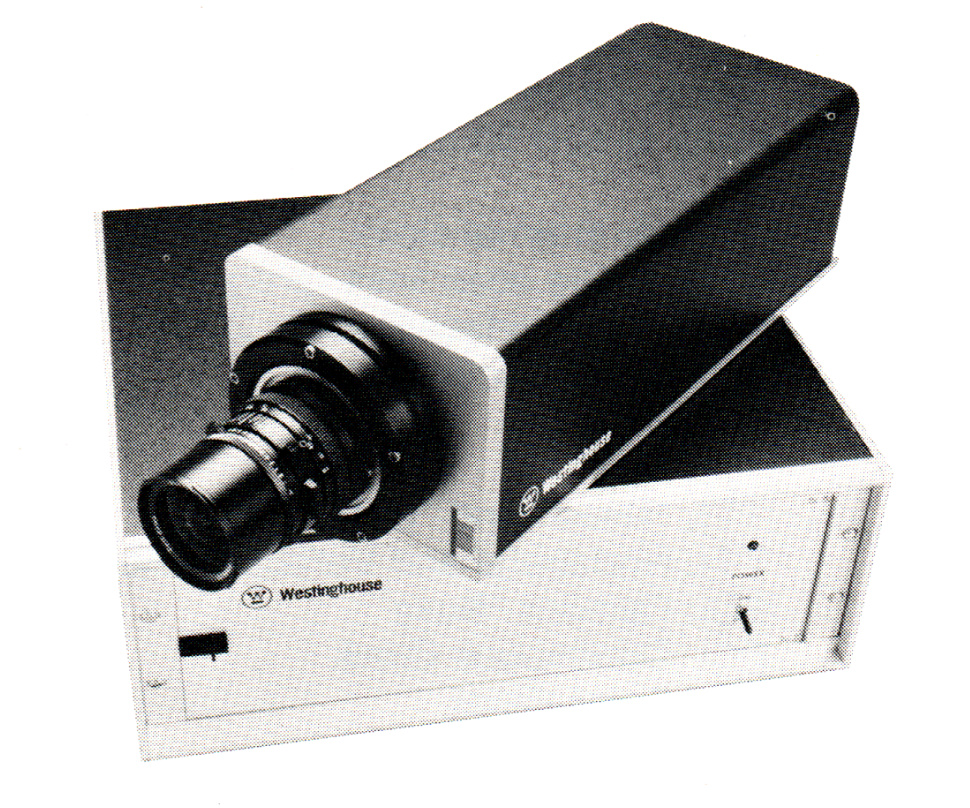
Westinghouse ETV-2000
(Photo MegaVision) MegaVision then went on to develop the Tessera system using a hi-res 2000 line vidicon tube camera. In conjunction with the 1024XM image processor. Designed to create professional looking pictures for e.g. catalog production. They wanted to use the promising Westinghouse ETV-2000, 10Mhz tube camera with 2048 active scanlines. But it never worked out. The only useful parts were the yoke and the vidicon tube. So they built their own 4 megapixel camera around it. Their first new Tessera system went into regular use in early 1989 at a commercial photo studio in Minneapolis (Photo Mechanical Services, Inc.). It was sold with Capture Station software which ran on the MegaVision image processing computer known as the 1024XM (see above). Back then they were already shooting 4 megapixel images while the rest of the digital world was evolving around one megapixel (like Kodak in 1986). Since then they claim to be the first ones to have commercially launched the first professional digital camera system to be used in commercial photographic applications. This was in 1987. Up to that point all Tessera systems used vidicon tubes. [37b][37c][37d]
At this megapixel point I'd like to quote an article from Popular Photography of 1982. The author wrote:
".. an electronic camera with a one-million element CCD would have to be suspended inside a cake of dry ice to keep the camera from melting.".
That was 1982 thinking for you!
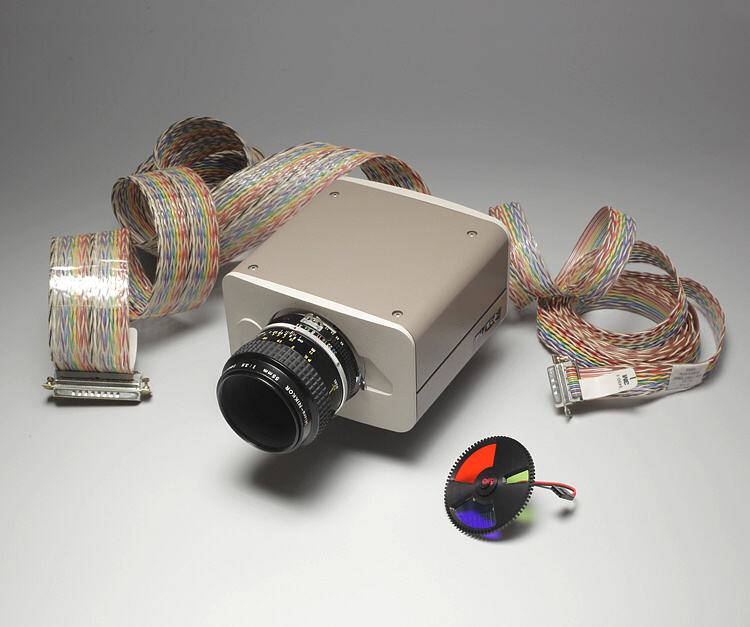
Kodak/VIDEK (Photo courtesy Kodak)Also in 1986, the world's first 1 megapixel CCD (monochrome) was developed by Kodak, called KAF 1400 or M1. It measured 7 by 9 millimeters. Small enough to be placed in a handheld camera. The high resolution was achieved by making the CCD pixels square rather than rectangular. So there were no gaps between them. A Kodak subsidiary called Videk incorporated the sensor into the Videk Megaplus camera. It was announced by Videk at the Vision '86 exhibition in Detroit. The camera was a so-called machine vision camera mainly used in machine-vision, medical, image-analysis, astronomy and optical-measurement systems. It could record 10 frames per second. It took an external processing unit and a computer to store, export and produce images. To handle that kind of data back then, a fast 14 MHz computer was needed. So it's no wonder that the Megaplus was hooked up with the Megavision 1024XM computer. It is often called a digital camera because it had a digital output, rather than an analog output like most machine vision cameras at that time. A solid-state CCD camera with 1320x1035 pixels and 100% light-sensitive sensor area. Thus a full-frame imager. These cameras sold between $10,000 and $40,000 and were essentially the first camera with enough resolution to produce a 5x7 photo quality print.[38]
This is very different than today's consumer digital cameras or D-SLRs. It did not have a viewfinder or memory to store images, or any type of user control. Rather, it was controlled by a computer which received the digital image data. Also the Megaplus could only be used with a power supply that was even bigger than the camera itself. Also, there was not just one model Megaplus but several different models to meet customer's demands. So it's almost impossible to determine what model the really first Megaplus was. Probably Model 1400 but I am unsure.
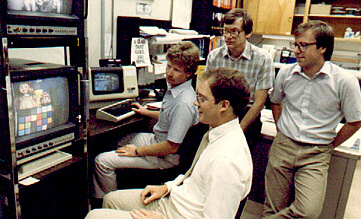
The Color M1 camera team (Photo courtesy Ken Parulski)Kodak Research Scientist Ken Parulski's R&D team developed a color megapixel camera breadboard in 1986. The goal of the work was to produce high quality color prints from Kodak's first megapixel CCD sensor, afore mentioned "M1". The camera breadboard was used to capture color images using a single CCD sensor with an integral color filter. The images were processed using digital image processing algorithms developed by the team. The processed color digital images were printed as large photographs. The prints were exhibited in Kodak's booth at Photokina in 1986. This was Kodak's first public display of color prints produced using it's digital camera technology. The photo shows some of the team members looking at computer displays of the sensor output (top) and processed color image (bottom).[39a]
Interestingly in 1990 Kodak had a strong business relationship with Apple, so Ken Parulski and a team of Kodak managers and engineers, traveled to Cupertino, California, to discuss mutual digital-imaging capabilities. They returned in 1992 with a Kodak sensor and a prototype. Apple did the industrial design and marketed it in 1994 as the Apple Quicktake 100. Ken was among the pioneers who did early work for Kodak when they headed for digital imaging. He holds not only a vast number of patents but is also still active as an inventor in the field of digital imaging applications.[39b]
1987 - Casio's leap from the VS-101 to the epic QV-10
Here is a little story that was so interesting to read that I split the 1987-section into two parts. In the first part I share the story of how Casio abandoned all plans of ever making an electronic camera again after the VS-101 electronic still video camera failed to sell and how the difficulties were overcome to finally release the now legendary QV-10 in 1995 that sparked the digital camera boom in Japan. All because of the perseverance and determination two men: Hiroyuki Suetaka and Hitoshi Nakayama.[39c]
Hiroyuki Suetaka, an engineer who designed LSI for watches at Casio, witnessed the Sony Mavica announcement in 1981 and felt that the electronic camera business was something that should be watched closely. By seeing the in-house technical capabilities, the concept of electronic cameras appeared very attractive to him. His determination to develop electronic cameras was confirmed when he discussed this with other competitors at the Electronic Still Camera Conference in February of 1983. Their purpose was to establish the 'Mavica Standard' as an industry standard for recording and processing images that were created by electronic signals. At least 42(!) manufacturers from the camera and electronics industries took part in establishing this standard. Suetaka was convinced that the electronic camera business would be profitable.
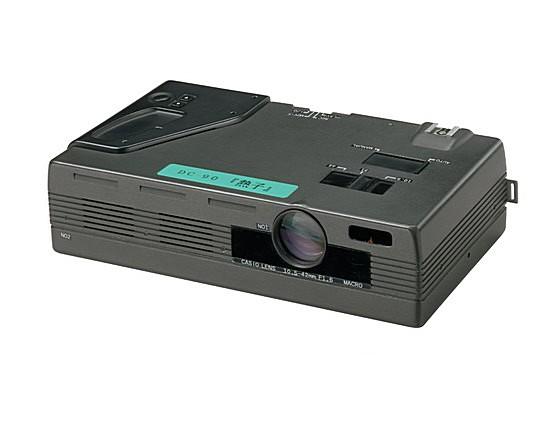
Casio DC-90 Prototype 'Atsuko'
(Photo © Beareyes.com/Casio)He took his concept to his senior manager, got it approved and in May of 1985 a special team of 8 engineers started to work on an electronic camera. It was called 'The K Project'. After the design phase was completed it was announced as the 'VS-101' in December of 1986. The imager was a Hitachi MOS sensor with 300,000 pixels making it not only the first MOS still video camera but also the first electronic still camera for private use. It went on sale in 1987 for a seemingly low price of 'just under $1,000'. Since Casio targeted private households they estimated that they would sell around 10,000 units per month. But the market failed to respond to the VS-101 and only 3,000 to 4,000 units were sold. With this bitter result all developments of a successor were shelved. The electronic still camera project was officially abandoned in 1988. The team was split-up and send to different departments and Suetaka was transferred to a different department. But he didn't give up and refused to believe that photography would forever be based on film. He reviewed the VS-101 and it's flaws and analyzed why it failed to sell. The reason was simple. It was analog. It had a floppy disc drive. He deemed it an immature product and it had to be digital to succeed. His thoughts were on the same level as those of Steven Sasson at that time.
But no-one at Casio seemed interested. Although all eight original Project K members were pooled at the Applied Research Department, four of them were transferred to other parts of the company simply because Casio saw no future in developing electronic still cameras. After 'five years of void' Suetaka and the remaining three engineers started working on the digitization of the VS-101. Since the JPEG protocol was established at around the same time, they adopted it for image compression and extraction. During these five years two prototypes emerged. The first prototype in 1990/1991, the Casio DC-90, conquered a few of the technological problems but had a side-effect. The DC-90 used PLD (Programmable Logic Device) and power consumption was high and thus it had a problem with high heat output (we're talking almost 200° Fahrenheit here). The heat problem was the reason for the nickname Ms. Atsuko meaning Hot Child. Also, because the DC-90 used generic parts it became rather bulky and heavy (around 5,5 pounds), so the other DC-90 prototype was nicknamed Ms. Omoko meaning Heavy. The DC-90 had a void to accomodate a small LCD viewfinder (as used in the Sony DKC-ID1) but the void now had to be filled with a cooling fan to deal with the heat. This work-around made it impossible to see the viewfinder! They solved the problem by attaching a small Casio LCD TV on top of the camera. This experience lead to the idea of incorporating a LCD screen on a digital camera.

Casio QV-10 mock-up model
(Photo © Impress Watch Corporation)The prototype was never put in production but seen as a mere toy instead. But because it was equipped with a serial interface and thus could connect to a computer it was used as an I/O device in television phone demonstrations. One can say that the general idea of connecting a digital camera to a personal computer derived from tinkering with the DC-90. Since the prototype was regarded as a toy the team went on to develop the next prototype, the CT-300 scanner camera. It too was outfitted with a RS232 serial interface for personal computer and periphery device connection. A Sanyo monochrome CCD and a Hitachi CPU were installed (a combination that was later successfully integrated in the QV-10. The CT-300 was built as a periphery device for personal computers but was never approved as such. Suetaka then took it to the electronic calculator devision which were marketing the Nameland seal printer at the time. They approved and it was sold as a periphery device for the seal printer to input facial images that could be printed on seals. On their own, the two prototypes were no stand-alone products but together they formed the core concepts of the Casio QV-10. In 1991 Hitoshi Nakayama joined the planning department to oversee planning strategies. He was a supporter of electronic cameras and wanted to revive the idea of a viable electronic camera. So in December of 1991 he held a meeting with Suetaka and wanted him to develop a digital camera using a memory card. Again this plan failed to gain approval. Nakayama then came up with another idea, a digital camera with voice recording capabilities and a 3-inch LCD monitor. Codenamed V2-Memo which stood for Visual Voice Memo. The concept idea was a highly portable electronic camera with a 3-inch LCD monitor that could record any- and everything, everywhere and check the results on the spot, show it on TV, store it on IC memory and erase images when no longer needed. The option of connecting it to a personal computer was not considered. Again, it failed to gain top managment approval.
The reason for Casio not approving anything that had to do with electronic cameras came for three reasons. First, the bad acceptance of the VS-101 on the market. Secondly, having no experiece with computers, the top managment couldn't comprehend the full impact and capabilities of an image input device for personal computers. Thirdly, the digital cameras on the market didn't sell well. In December of 1992 Suetaka and Nakayama met again and agreed on moving from a digital camera concept to a LCD TV with a built-in camera concept. The CV-1 was the world's smallest LCD TV at that time. Unfortunately the CV-1 wasn't selling well because there was no nation-wide reception possible and people couldn't watch whenever or wherever. Nakayama thought that when people cannot watch commcercial broadcasts anywhere and anytime, why not let them watch images they took earlier. A LCD-TV with an eye. He made a wooden mock-up model and proposed the idea to the president. He was interested and the development program codenamed RS-20 was approved in December of 1992. In March of 1993 formal development began.
Aimed at 50,000 Yen, a production rate of 3,000 units per month and with the basic product specifications set, a ten-man project team was set to work and a first sample was ready by December of 1993. A sort of camera TV with an internal TV tuner. After the sample was shown, the product characterization was changed from TV camera to digital camera (or an image input device for personal computers). Why? Because at that time the price of LCD TV's was set to increase proportionally to it's screen size. Justifying 50,000 Yen for an 1.8 inch LCD TV (even with a built-in camera) was simply impossible. It had thus to be sold as something else then a LCD camera. By summer of 1994 the product in it's final form was ready. Officially released as the Casio QV-10 digital camera in November of 1994. Six months behind schedule it was ready to sell. But the path of the development work on the QV-10 was far from being smooth. The QV-10 was never a clearly defined product concept and underwent a lot of changes in product design. The final product characterization was formed by pooling different opinions from different perspectives.
1987 - Kodak's approach at digital SLR's
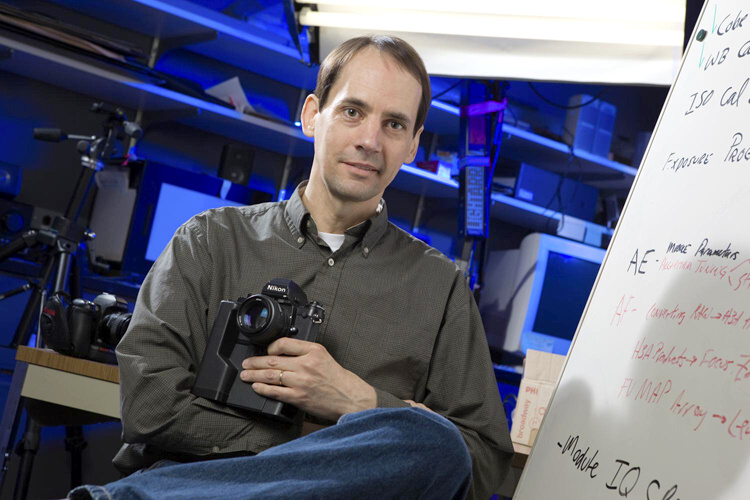
Jim McGarvey (Photo courtesy J. McGarvey)
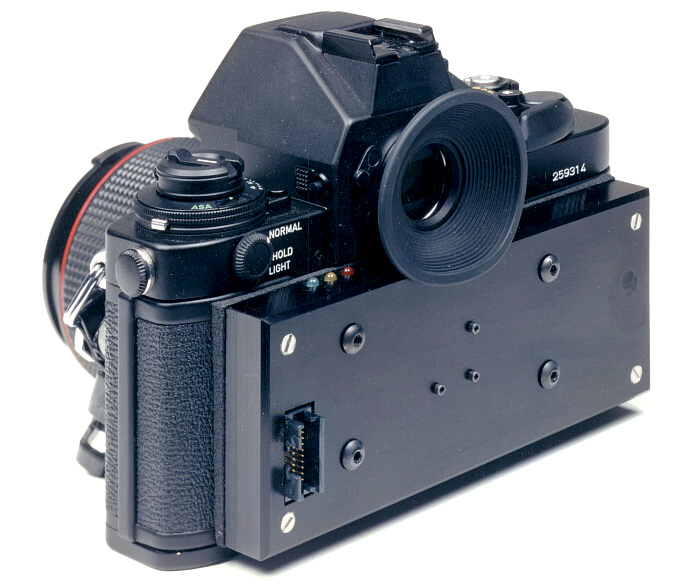
Kodak EO (Photo courtesy J. McGarvey)The Megaplus wasn't the only camera built at that time to use the new megapixel sensor from Kodak. A US Government customer asked the FSD (Federal Systems Division) of Kodak Eastman to incorporate the M1 into a standard 35mm film camera body (to create the first megapixel portable digital camera). This led to the development of the prototype of the popular Kodak DCS camera system. Dubbed the Kodak Electro-Optic Camera, nicknamed EO, (announced 1987). Intended for covert use with a black box containing a 100MB HDD in a camera bag and a ribbon cable to the camera body concealed inside the neck strap. Images were downloaded from the internal HDD by docking the black box on a tape archive unit. (The first digital camera dock). The film camera body had no electronic interface, so the shutter release was detected by monitoring the battery current. The imager package was mounted to a cooler to reduce noise, but cooling was limited to prevent fogging the cover glass and was not very effective. It was truly portable, battery operated and could store lots of images on an external harddrive. The image quality was far better than the popular still video cameras of that age.
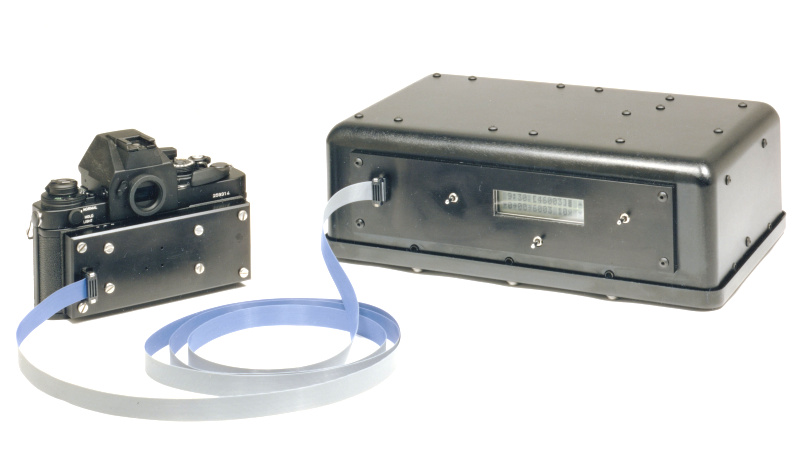
Kodak EO (Photo courtesy J. McGarvey)Unfortunately only one such camera was built and it's whereabouts are unknown today. The fact why this camera was almost unknown to the public is because the contractor was a secretive organization and the camera was hand-delivered personally by it's engineer Jim McGarvey in Washington. Never to be seen again. Luckily Jim shared his knowledge about his work and this cameras on his website.[40a][40b]
1987 - first electronic picture in a newspaper
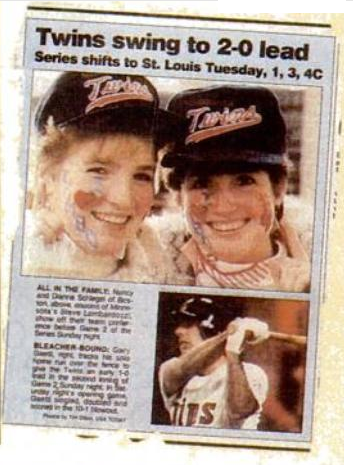
First SV picture
(Photo USA Today)During the second game of the World Series in Minneapolis, a news reporter took a legendary picture with a Canon still video camera, wired the images via a telephone line to the HQ of USA Today for printing. The picture of two fans was printed the next day on the first page of USA Today on October 19, 1987. It was the first time that an electronic image of a still video camera was printed in a newspaper.
1988/1989 - first consumer digital cameraS
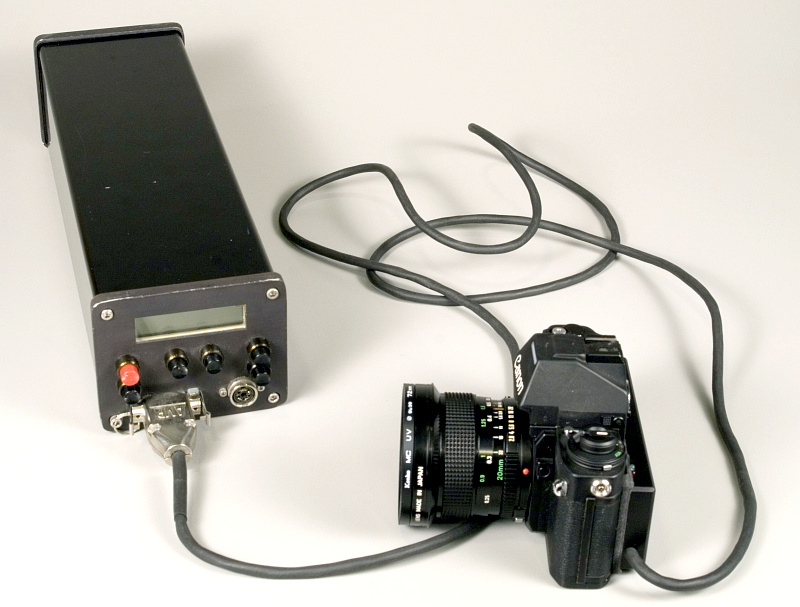
Tactical Camera (Photo courtesy J. McGarvey)In the EO the FSD marketing guys saw an opportunity to create digital cameras for the US military. Based on it's design the Kodak Tactical Camera was built in 1988. More rugged by eliminating the internal HDD and using buffer memory to store images until they could be downloaded to an external SCSI storage device. With a motor drive, the camera would capture a "movie" at 5 fps and play it back just as fast from memory. It used the same imager and firmware as the EO. Two demo units were built and demonstrated to many government customers. In spring of 2012 one of the two camera systems was tracked down and saved from being disposed of. It is now on display in the George Eastman House collection. Jim McGarvey was so inspired by widespread interest in his work that he created a very useful and detailed website about his work and his cameras:Tactical Camera and Kodak DCS series
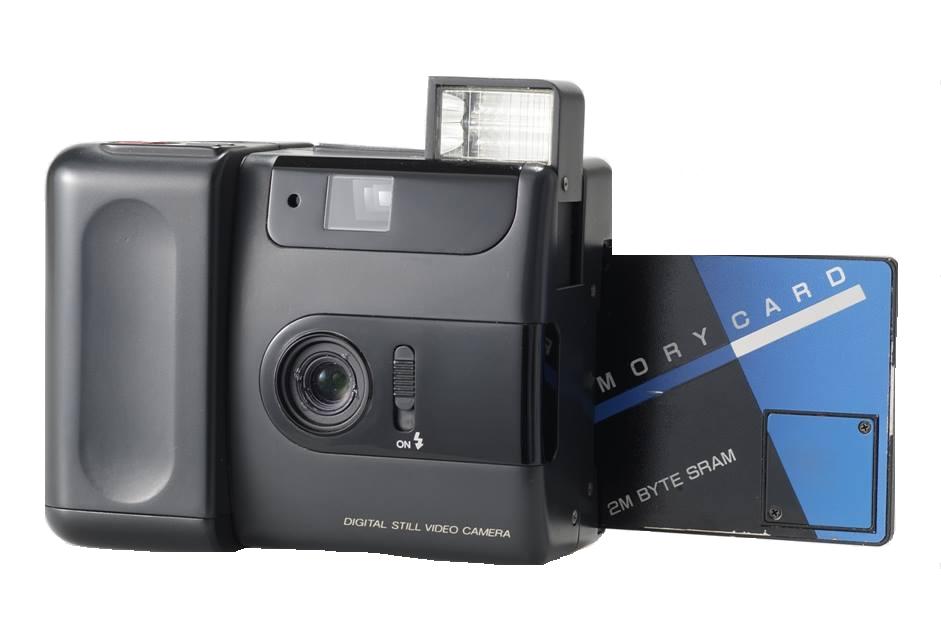
Fujix DS-1P (Photo Fuji)At the time Kodak was developing and building professional digital cameras for government customers, Toshiba and Fuji did something in Japan that would soon shake the very foundations of the consumer photography market. Since they belonged to the same financial group (Mitsui) they held annual group meetings to decide plans that would be proceeded jointly. In 1987 Fuji announced in the meeting that they had a plan to develop a digital still camera. At that moment, Toshiba had developed a variety of IC memory cards to be used as additional memories or supplemental functionalities. Then both companies agreed that Fuji would make cameras and Toshiba would make memory cards and support the electrical parts of the digital still cameras. This agreement was made because Fuji was simply one step ahead of Toshiba in the development process. The outcome was the first fully digital camera with a re-usable SRAM memory card. The Fujix DS-1P. Although not the first digital camera, it was the first one intended for the consumer market and could also handle memory cards. Well, the very few IC cards that were available back then. The 2MB SRAM card that came with the camera could only store the pictures temporarily (the cards back then were equipped with button cells, when they were depleted all images on the card were lost).
According to an unproven source the DS-1P should be priced at $10,000 and a top of the range version at $40,000. This must have included a video printer and playback device. At least it's successor the DS-X was sold for $20,000 including said equipment. To avoid confusion: the press back then referred to the DS-1P often as the "Fuji card camera". One may mistake this with another camera released before the DS-1P. This is not true. The DS-1P was announced by Fuji on September 20th, 1988 and introduced to the world at Photokina on October 5th, 1988.
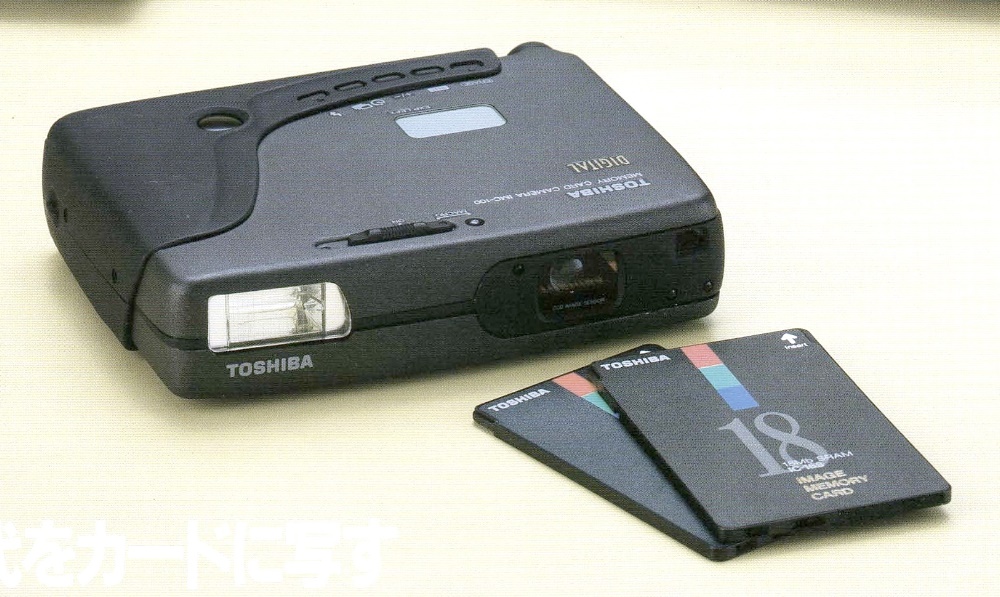
Toshiba IMC-100
(© Toshiba Science Museum)At this point I would like to end all speculations concerning this camera. The DS-1P was NOT marketed on the consumer market. An unknown number of DS-1P had been manufactured that were clearly beyond the prototype stage. Several SPIE and IEEE documents prove that image quality tests were conducted in 1989. In 1991 Toshiba called a few companies who were interested in developing digital still cameras. They held a meeting up to two times per year, from 1991 to 2000, to develop a standard for digital cameras. Most of the DS-1P were therefore either given away or sold to these particular digital camera manufacturers.
Here comes the big bummer for collectors: according to a statement from Fuji in 2009 only one DS-1P still exists and is believed to be non-functional. It is currently at display in a museum in Japan. To prove that the DS-1P was actually built as a working camera I came across an abstract by Kikuo Otsuka et al. It's from 1990 and describes a digital image transmitter for card cameras with ISDN interface. In his abstract he describes how pictures from a memory card, taken by the Fujix DS-1P, could be transmitted via ISDN by a prototype transmitter.
The DS-1P was succeeded one year later by the Fujix DS-X card camera. The DS-X was the result of the field tests that were conducted with the DS-1P. This time Toshiba and Fuji worked at a similar pace and both companies succeeded in producing an identical digital camera. Fuji launched the DS-X and Toshiba built the IMC-100. Since there was no picture material of the IMC-100 available I first assumed the camera never existed but after discussing this issue with my sources I can correct my initial mistake and say that the IMC-100 was indeed built and that's not all, to back this up I was granted a world exclusive photo of the IMC-100 by the Toshiba Science Museum. You can see the picture in the Prototypes&Rarities section. [41] [42] [43] [44]
1990 - first digital cameras outside of japan
Dycam Model 1 (© digicammuseum.com)
Dycam Model 1 interior (© digicammuseum.com)1990 was a vivid year. While most companies were still working on still video cameras or digital camera prototypes, Dycam and other companies actually marketed one. At Comdex '90 Dycam introduced a black and white point-and-shoot camera, the Model 1. Announced as a pocket-size-camera it would take pictures of 376x240 pixel resolution and stored them in it's 1MB flash memory. People nowadays often complain about low resolution of old digital cameras, how grainy and tiny the picture was. Let us not forget that in the nineties a 640x480 resolution monitor was standard equipment for years on end and even a 320x240 image still looked fabulous on such a monitor! A one button, easy to operate digital camera. There was no display and the camera would communicate with users through beep tones. Without a manual you were lost as there was no way to figure out what the beeps meant. The camera worked on two rechargable batteries buried under the black plastic cover. You had to recharge these batteries frequently because when they were depleted your pictures were lost. Not only that, but once the batteries where recharged you had to connect your camera to a computer and download the software into the camera to make it work again! The camera hit the streets at $895 suggested retail price. Together with a docking station, PC or MAC cables and software. At first Dycam released a MAC version of the Model 1 and it's original project name was Dycam 1GS. Later a PC version followed and the camera became commonly known as the Model 1. Interesting enough the Dycam website hasn't changed it's looks or content for over 18 years![46][47]
King Jim Co. DaVinci DV55 (© digicammuseum.com) This happened in america. At the other side of the globe something was happening too. As you have read before Casio was working hard on the DC90 prototypes that would eventually turn into the Casio QV10. That was of course not the only thing. King Jim Co. LTD, without much ado, marketed a filmless digital camera that would briefly store an image in internal DRAM buffer and then, upon request, would print it on thermal paper. Just like a Polaroid but only in black and white and on thermal paper instead of photo paper. The idea behind this can be read in the 1975 section of this page. As I mentioned, King Jim Co. LTD, picked up on the idea and patented their own electronic printer camera in 1990 which was marketed the same year as the King Jim DaVinci DV55 (it even featured Mona Lisa on the retail package). The DV55 was the world's first digital camera with built-in thermal printer. It's design was unlike any other camera and actually won a Good Design Award in 1990. The DaVinci DV55 and the Dycam Model 1 were marketed around the same time in mid 1990. About two to three years later it came over the big pond and found it's way to the US. There it was sold by different companies as well as american airlines as the world's first camera that has a built-in copier (according to John Henshall and his great Evolution of the Species article in EDI Review of November 1993).![48][49]
1991 - The digital camera comes to europe
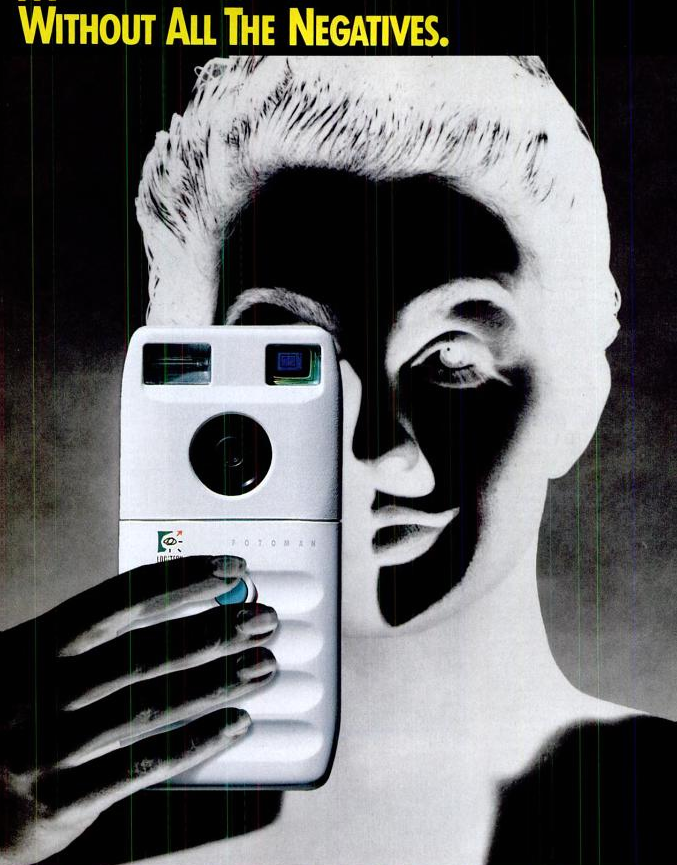
Early Fotoman ad (© Ziff Davis, Inc.) 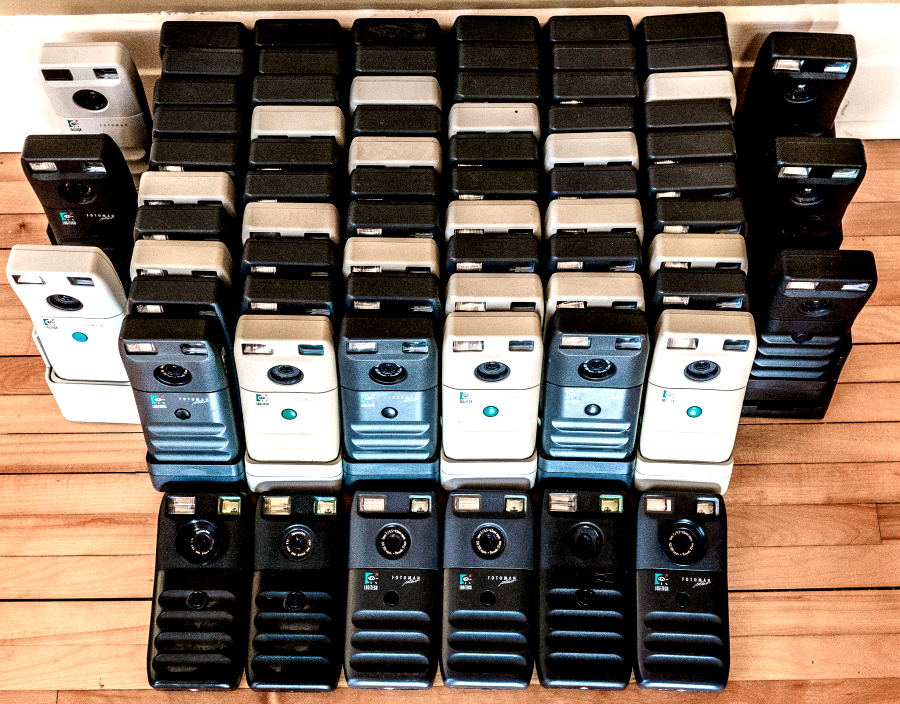
Dycam/Logitech collection (© Marc Aubry) In early 1991 Logitech approached Dycam. They wanted to market a digital camera as they were one of the leading brands in computer peripherals. A digital camera that could connect to a PC seemed like a good add-on to their portfolio. Dycam licensed Logitech to use it's technology to build their own version for $1M.[45] The Logitech Fotoman FM-1 went on sale by Fall 1991. Physically similar to the Dycam but with different firmware, software and a white embodiment instead of black. The first digital consumer point-and-shoot camera to hit the european market. Not that many Dycam Model 1 cameras were made and only sold in the US through selected channels. The Logitech Fotoman FM-1 however was produced in larger quantities, sold and shipped all over the world. It was a market success. The reason was simple. The Fotoman had better software, better marketing, better firmware and Logitech gave away free camera bags upon registration. The Logitech software had a lot of features like picture alteration and the possibility to store the images in three different file types.[50] It also allowed the user to transfer new firmware into the camera. Dycam digital cameras are hard to get by these days. There is only one person in the world I know who by far has the biggest collection on Dycams and Fotomans. To the right you can see a picture his collection. Only nine of them are Dycam's, the rest Logitechs. I doubt anyone will top this.. ever!
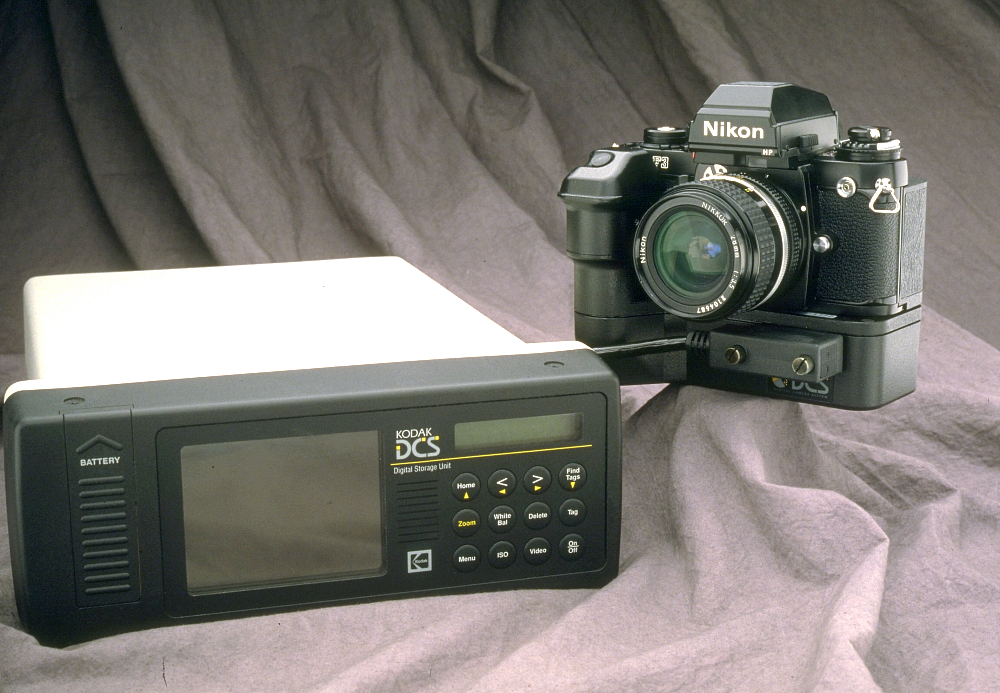
Kodak DCS (© Kodak/Jim McGarvey) While Logitech and Dycam were satisfying the consumer crowd, Kodak introduced the Digital Camera System (DCS) with blazing horns after three years of tests. Aimed at photo journalists, industries and government. A $20,000+ package with camera, storage unit, cables, manuals, disks, keyboard and suitcase. A Nikon F3 camera with a digital 1.3MP back, a 200-MB hard disk drive and an LCD screen for reviewing the images were the core elements. The camera system came in six different packages with color and monochrome imagers. A total of 987 units were sold until 1994. When the Kodak DCS-200 unit came out, the press dubbed it's predecessor the DCS-100. It stuck and has been called that ever since. There is an interesting interview on Nikonwebs' website with Jim McGarvey about the Kodak DCS. You can find it under reference 51 or here DCS-100.[51] 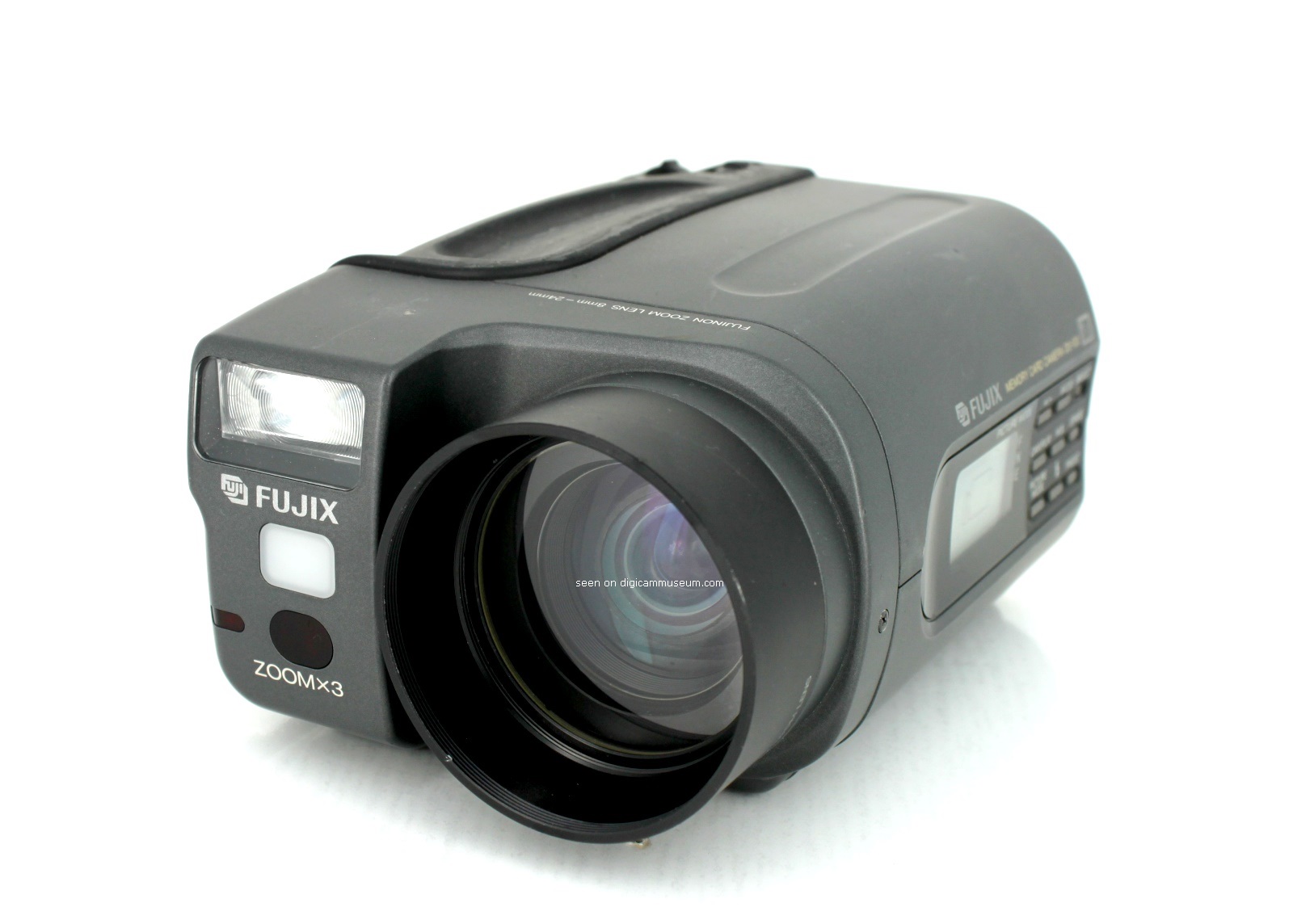
Fujix DS-100 (© digicammuseum.com) There is a load of DCS-100 pictures out there copied all over the internet from various sources so I picked an early marketing photo that has not been multiplied that often.
Fujix learned from customer experiences and revamped their DS-X model entirely. Having listened to customer feedback the new DS-100 digital card camera now featured an LCD display, auto focus, video out jack and featured 3x optical zoom. Having implemented the first SRAM cards it was no suprise that this camera also featured external storage capabilities. For the first time a card reader was presented for reading the SRAM cards by hooking it up to a computer. The camera was quite a success and won a Good Design Award in 1992.
1992 - Secret Apple projects

Apple Adam Prototype Design (© digicammuseum.com) Over the past few years I've had the privilege to have worked with some of the most powerful minds in the imaging business. I've had endless conversations with engineers, inventors and scientists from almost every major camera company so far and during the Fall of 2014 some new material came to light, so extraordinary, that it had to be included here. So let me take you on a strange journey into the mind of a true genius named Eric Anderson. Most of what you can read here are his recollections of true events. Apple's internal ATG (advanced technology group) actually started developing a prototype digital LCD-based camera back in 1990. The entire process of developing the prototype took about two years. The project was called Ansel Adam. A demonstration of the system (under NDA) was widely acclaimed. As we know Kodak and Apple had a strong business relationship which resulted in the Apple Quick Take series (among other things). However, the relationship between Apple and Kodak was very difficult and around this time the troubles began to manifest. Kodak also had business relationships with Logitech, Compaq and Chinon among others but somehow always proved to be a difficult business partner as you can read in the Kodak DC40 section. Anyway, the Ansel Adam Prototype (which consisted of a handheld device attached to a Macintosh computer under a table) was showcased in Rochester at Kodak. In mid 1992 Apple decided to turn the prototype into a self-contained product (in ATG), with the goal that it would then be transferred to the Imaging Group. The Imaging group, at that time, was in the process of working with Kodak to create the Quick Take camera series, based on multiple subsystems developed by different groups - the standard method of building a digital camera at the time.
By Fall of 1992, Eric Anderson finished up on Cathedral (a DSP OS) and went to work full-time on Adam at ATG. The team spent a lot of time working on lenses, sensors, system block diagrams, feature sets, and did many user studies with cobbled together prototypes of various kinds to get a handle on what people wanted for features (consumers and business). In late 1992 and early 1993 the Adam team had established a great relationship with Sanyo and developed block diagrams and concepts around integrated circuits they had developed for video cameras (minor changes were required - in those days, consumer-level digital still capture was not a whole lot more resolution than VGA). In 1993 the Adam team was transferred to the Apple Imaging Group. They had a complete Bill of Materials for the Adam camera and agreements with Sanyo to produce it. Sanyo promised Apple they would be the first to introduce a LCD based camera with a GUI. Apple spent a LOT of time developing the GUI. The GUI was later shipped in 1998 on the Kodak cameras. The Imaging Group Product Marketing and Management decided to "go after the underbelly of the market" i.e. low cost cameras, and put Adam on the back burner for the future. The Imaging Group's engineers agreed and developed the Aspen and Phobos projects (two cameras with no LCD although Aspen started out with a 0.7" LCD viewfinder, which was later removed to reduce cost). They were "forced" to switch to Kodak. This caused some very serious problems, such as the Chairman of the Board of Sanyo being put out to pasture, and some very unhappy times between the Apple and Kodak teams. The Imaging Group presented their architecture (Apple Camera Architecture, or ACA) to Kodak in Japan. They didn't like it because Apple's engineers were claiming to actually know how to build a camera in a different and new way that they hadn't thought of. During that meeting, they sent out someone to create a document of "Kodak architectures" a document dated that day consisting of multiple pages, with various configurations of CPU, memory, etc. That was Kodak's response. Kodak even refused to take a copy of the presentation Eric Anderson gave, in spite of the fact that the NDA required it. A "talk" from Apple to Kodak management "fixed" that soon after.
The key to the FlashPoint OS (as it was called at the time) running on Adam was a single bank of DRAM and a high-speed processor (a single processor), with everything done in software, from taking in the raw CCD data to JPEG. The Adam engineers invented many things during this process. This they called the Uniform Memory Architecture. It was the software-based camera idea with API's so other apps could be launched. By 1994, it was clear that Kodak's work on the "camera control shell" software subsystem was not successful. The Adam engineers had to re-instruct them which set the project back a year. Same went for the hardware development, Kodak attempted to emulate the ASIC using a set of boards with many FPGA chips which never fully worked and that what did work, only worked at 1/12 speed. So Apple agreed to drop the LCD and GUI part for the future because of Kodak's insistence (and the Imaging Group's management under their influence), only to see Casio beat them to it and launch the QV-10 in summer 1995. By the end of 1995, Kodak demanded an LCD panel on the camera but after some arguments Kodak cancelled the project. As for the Adam prototype, Apple's Imaging group continued to work on it because they believed it was the future of photography. In fall 1996 the group was spun out of Apple as FlashPoint Technology and QuickTime IC became Digita OS. The Motorola 823 processor finally arrived in 1997 and they had full GUI working that year. First products shipped were the Kodak DC 220 and 240, later the DC 260 and 290.[54]
Since all material concerning the Ansel Adam Prototype is currently under the wings of lawyers I can only present a 3D rendered image of what the camera might have looked like.
1993 - digital cameras for business people
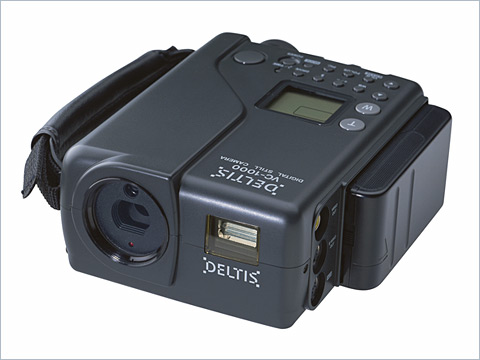
Olympus Deltis VC-1000 (© Olympus Corp.) Dycam, Fuji, Kodak, Nikon and Logitech already had digital cameras on the market. Aimed at professionals, news reporters, press and DTP agencies. Regular consumers were not the focus group of camera manufacturers so far, neither were business people. Olympus wanted to change that and used their computer storage label Deltis to market a digital camera for commercial use. The Olympus VC-1000 was a professional looking digital camera which should replace the earlier still video model VC-100. The camera had a CCD with 410K pixel resolution and would store the images on an external SRAM card. A novelty was the built-in LCD viewfinder which allowed the user to playback and review taken images. There is no information about how the camera did on the market but ist must have been at least successful enough to spawn five follow-up cameras, the VC-1100, VC-1000 II, VC-1100 II, VC-1100 II HS and VC-1100 II HS PV. The VC-1100 models had transmission capabilities that allowed the user to transmit images over the air. Transmission of one image could take up to 6 minutes and was reduced by a faster model, the VC-1100 HS. The numbers are pretty simple to explain, the 'II' behind the models name implied that the model was re-issued with a reduced price tag. 'HS' meant High Speed and implied faster transmission speed. The VC-1100 II HS PV is the most peculiar one as it featured PC-VAN autopilot function (whatever that means!). Little is known about these cameras and few were marketed at all. It's incredibly difficult to track one down these days which makes them highly collectible. The VC-1000 was priced at $4,500 then reduced to $1,700. The VC-1100 went for $3,000 and reduced to $2,200. All models after that sold for around $2,000 in 1993 dollars.
1994 - children of different parents
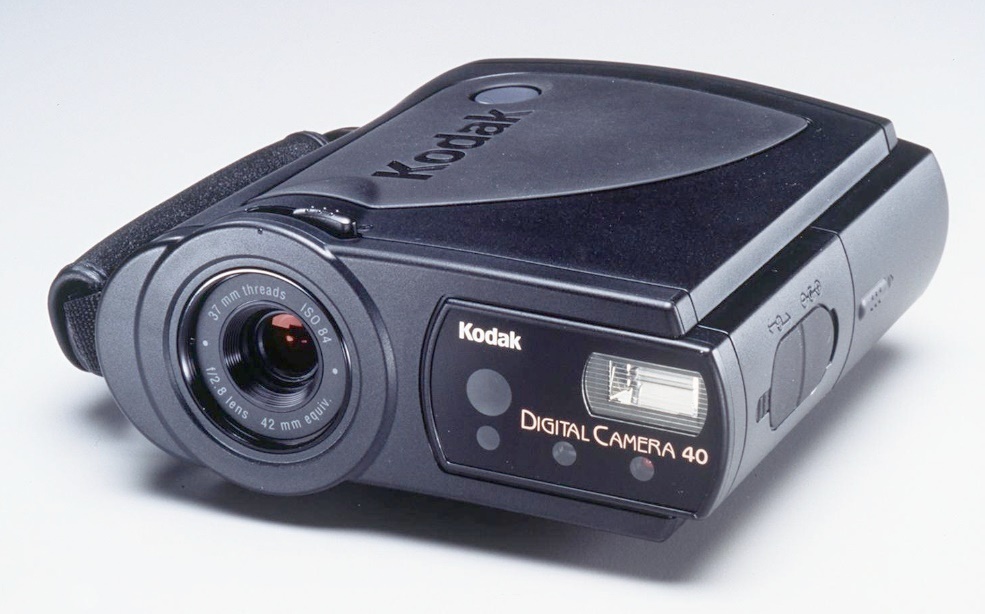
Kodak DC40 (© Kodak Eastman) 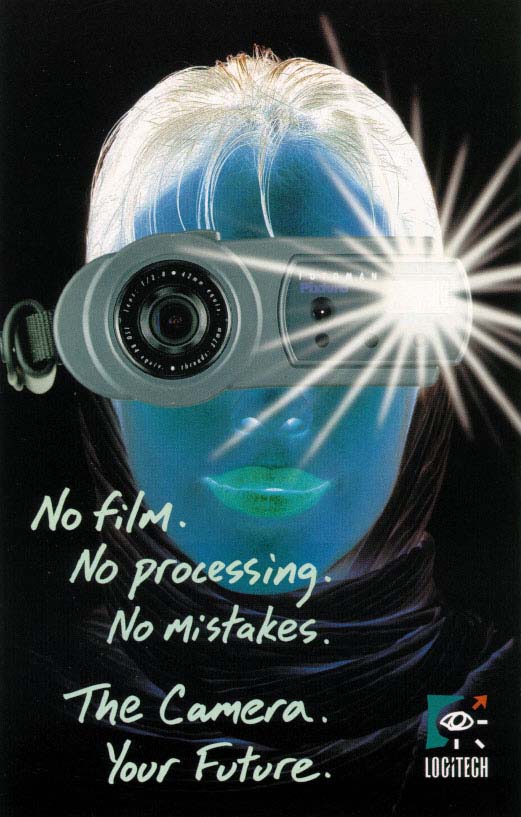
Logitech Fotoman Pixtura ad (© Logitech Inc.) At the end of 1993 there were already some 15 digital cameras on the market, most of them extremely expensive and hard to get. The forerunners on the digital camera market were Dycam, Logitech, Nikon, Kodak and Fuji. 1994 also saw the birth of two different digital cameras from joint ventures. The Kodak DC40 from the Logitech/Kodak relationship and the Apple Quick Take 100 from the Apple/Kodak relationship. Some of the Apple Quick Take has already been mentioned before on this site so let's focus on the "breech birth" of the Kodak DC40. The following section is a recollection of true events as disclosed to me by Paul Laughton.
Paul Laughton was the Logitech project manager for digital still cameras around 1994. Logitech had purchased the rights to the Dycam camera for $1M. After much difficulty they re-engineered the Dycam into a manufacturable Logitech Fotoman. Their next goal was to design a color version of the Fotoman and all efforts revolved around using a color video camera CCD (the Logitech Fotoman used a black and white video CCD). Logitech was not having much success in generating quality images. One day two guys from Kodak came in and showed them a prototype of digital still camera using the Kodak KAF 400 color CCD. Knowing that their own color camera project was not doing well, Paul immediately said that they wanted to use Kodak’s technology. The Kodak guys invited his team and himself to visit and evaluate their camera development site in Yokohoma. Paul was also invited to visit and inspect Kodak’s manufacturing partner, Chinon, in Suwa City Japan. Everything he saw convinced him that Logitech should go with the Kodak design. So he told the Kodak guys, over and over, that they were ready to commit. For some reason, Kodak was not responsive to their commitment. It turned out that Kodak’s management had authorized them to sell the camera design to two and only two companies. They already had a contract with Apple (for the Quick Take series) and had also been working on a deal with Compaq. That was two. While Kodak was stalling Logitech, Paul continued to work on the development specifications. He had a whole team of engineers from various product development disciplines (Hardware, software, QA, manufacturing, packaging, industrial design, etc). He had them write up a complete set of specifications for their new camera (using their own technology and/or Kodak’s technology). One of their efforts was the industrial design. They tested various design forms with focus groups. The binocular design of the ultimate Logitech Pixtura / Kodak DC40 won out.
Suddenly, one day, Paul got a call from Kodak. They were ready to go (he later learned that Compaq had bowed out). They asked for Logitech's specifications. Paul immediately faxed them over one hundred pages of specifications for just about every aspect of the camera including the industrial design. They were blown away. Apparently getting specs from Apple had been like pulling teeth. They agreed upon prices, quantities, delivery dates and so forth. Logitech's management agreed with the details, Kodak agreed with the details and they proceeded with development. Chinon proceeded with the camera chassis tooling and engineering. Kodak Rochester and Logitech worked out the details for the software. Everything was going well. Then one day, Paul's management came to him and said “We can’t afford this. We must cancel.” He called a meeting with his management and the Kodak guys. He told them they were terminating. Kodak said, “we will get back to you.” A few days later, Kodak came back with a proposal. They would greatly reduce their charges for development to that which Logitech had already paid them if they could sell the same camera under their own label. Kodak would pay Logitech a royalty for every camera sold. Logitech would still control the product development. Paul's management agreed. Thus was born the Kodak DC40. After that, he became the project manager for both the Logitech Pixtura and Kodak DC40. Kodak entrusted him with management of the whole development project. He and various members of his team spent a lot of time in Suwa City overseeing the development at the Chinon plant. He also spent time in Rochester with the DC40 marketing team. They both brought their cameras to market. Logitech’s Pixtura did not sell very well. The DC40 did better. Kodak would mail a royalty check to Logitech every quarter year.[55]
1995 - the digital camera boom
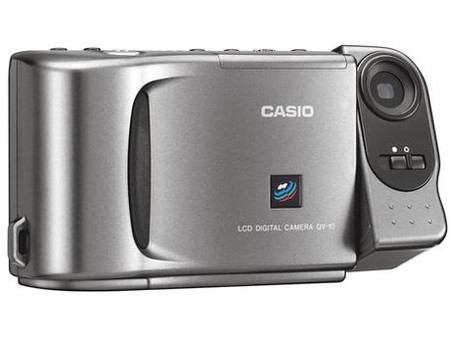
Casio QV-10 (© Casio Corp.) 
Casio QV-10 skeleton model (© Casio Corp.) As mentioned before, Casio was working hard on the QV-10 model and in 1995 they were finally ready. Casio launched the first digital camera with LCD screen. The Casio QV-10 is now officially recognized for sparking the digital camera boom. In retrospect it's a fairly simple point and shoot digital camera. A swivel lens, video out jack, no flash, almost no features and just 2MB internal memory. Yet it cost around $700 back then. Insane by today's standards but back then it was the latest craze. An affordable ditigal camera for the average Joe with LCD screen. In 1995 this was one of the high-tech must-haves for christmas.
Is there a first....?
Now we have at least 9 different cameras that were a "first" in their own special way.
1. McCord & Westphal Digital Camera (1971-1973)
First digital silicon pixel array field operational camera. Invented and built by Thomas B. McCord (MIT) and James A. Westphal (CalTech) in 1971. Paper published and patented in 1972. A photometer-digitizer system with A/D converter that stored images on a digital tape. Tethered to an electronics rack. Handheld no. Marketed no.
2. Kodak Prototype Electronic Still Camera (1975)
First hand-held silicon pixel array (CCD) camera. Conceived by Steven Sasson of Kodak Eastman. Started in late 1974, finished by December of 1975. All electronic still camera that recorded a digital representation of the output of a single frame of the CCD on a digital tape. First ever built hand-held CCD still camera. Handheld yes. Marketed no.
3. University of Calgary All-Sky Imager (1977?)
First all-sky digital monitoring system for auroral studies. Designed and constructed at the University of Calgary. Handheld no. Marketed no.
4. Pointing Products FS-2505 Digital Freeze Frame Camera (1984)
First commercially sold video camera with a built-in "freeze frame" capability using solid state digital memory. Handheld yes. Marketed yes.
5. Kodak / Videk Megaplus (1986)
First megapixel class digital camera. Developed and manufactured by Kodak. Sold by Videk. Built in 1986. Hi-res CCD camera with external processing unit. Digital camera but not a stand-alone product (tethered to a digital processing unit). Handheld no. Marketed yes.
6. MegaVision Tessera System (1987)
First commercially available professional digital camera. Tethered system. Developed and manufactured by MegaVision. Built in 1986, on sale in 1987, first regular use in 1989. Handheld no. Marketed yes.
7. Kodak Electro Optical Camera (EO) (1987)
First hand held marketed digital camera. Developed by Kodak's FSD Division engineer Jim McGarvey for a federal contractor. It was the first megapixel digital camera from Kodak. Handheld yes. Marketed yes (government customer).
8. Fujix DS-1P (1988)
First consumer friendly pocket sized digital camera. Developed jointly with Toshiba. Manufactured by Fuji in 1987, introduced in 1988. It utilized IC cards for storage (SRAM). First consumer digital camera. Handheld yes. Marketed no (distributed to other camera manufacturers though).
9. Fujix DS-X / Toshiba IMC-100 (1989)
First marketed consumer friendly pocket sized digital cameras ever. Developed jointly with Toshiba. Manufactured by Fuji and Toshiba in 1988, introduced and marketed in 1989. It utilized IC cards for storage (SRAM). First consumer digital cameras marketed. Handheld yes. Marketed yes (only in Japan I assume).
(Handheld here means you could take the camera and the storage/processing unit along with you to take pictures.)




